It seems we can’t find what you’re looking for. Perhaps searching can help.




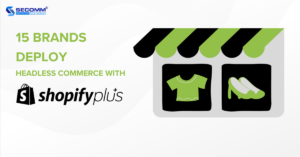
15 BRANDS DEPLOY HEADLESS COMMERCE WITH SHOPIFY PLUS
 08/01/2024
08/01/2024
 3,879
3,879
 2
2
 0
0
 1
1
Headless Commerce is one of the fastest-growing trends that contributes to changing how businesses approach eCommerce. Interestingly, Shopify Plus is known as a leading platform in providing superior solutions and tools for businesses to implement Headless Commerce.
The article below lists 15 top brands from various industries that have deployed headless eCommerce websites on the Shopify Plus platform to deliver a more memorable online shopping experience to customers.
Learn more: 15 reasons to switch to Shopify Plus
Babylist
Babylist was founded in 2011 by Natalie Gordon when she was pregnant and faced difficulty selecting gifts for her baby shower. Babylist is a platform that allows parents to create a list of products they need for their child. This helps party attendees or gift buyers know what items are essential.
It’s crucial for Babylist to optimize for two distinct customer journeys:
- One allows parents to easily create a wishlist and add product URLs they want from any website on the internet, not just Babylist.
- One allows friends or relatives to purchase products from the wishlist from anywhere on the internet.
This illustrates that shopping involves more than just selecting items from a product catalog; it also extends to registries created by parents, housing product URLs from various sources on the internet. The complexity increases as Babylist enables users to make online purchases and collect items in-store.
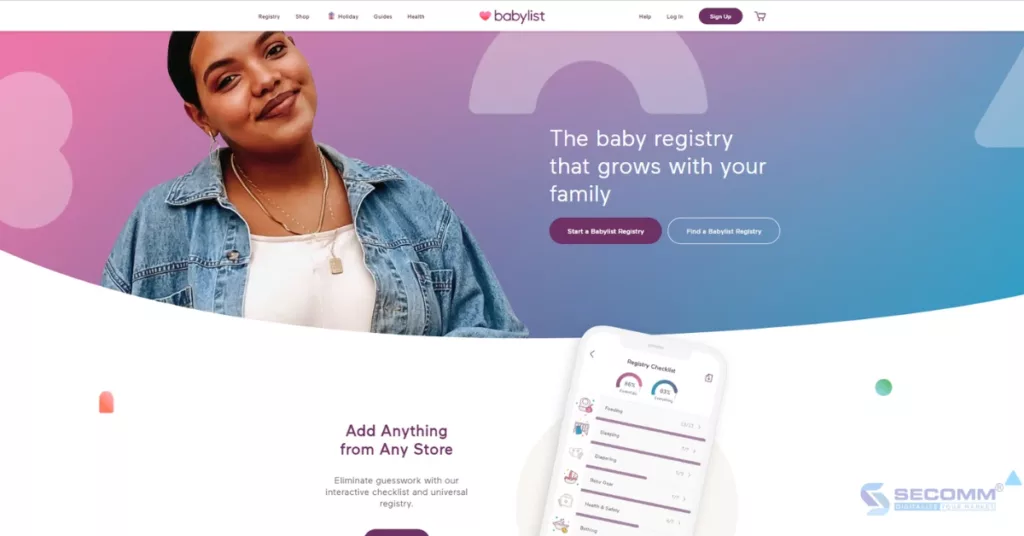
Therefore, Babylist has adopted Headless Commerce with Shopify Plus to customize the customer journey more easily and optimize the management processes of product listings, orders, payments, and inventory. In addition, Babylist also uses a Headless CMS – Contentful to distribute content to the website and mobile app interfaces.
- Website: https://www.babylist.com/
- Industry: Maternity & Baby
- Lưu lượng truy cập: 9.9 triệu/tháng
- Xếp hạng: 1,087 (Hoa Kỳ) & 5,431 (Toàn cầu)
Figs
Figs is a high-end medical apparel brand with a focus on minimalist design.
The brand specializes in manufacturing and distributing medical clothing and accessories for healthcare professionals, including households, doctors, dentists, and individuals working in the healthcare industry. Figs’ product range includes medical clothing, jackets, hats, socks, gloves, and shoes.
Prioritizing online sales, Figs has implemented a Headless Commerce strategy using Shopify Plus for backend functions such as product management, order processing, payments, shipping, and more. However, on the frontend, Figs has taken an independent approach to crafting a distinctive and personalized user experience.
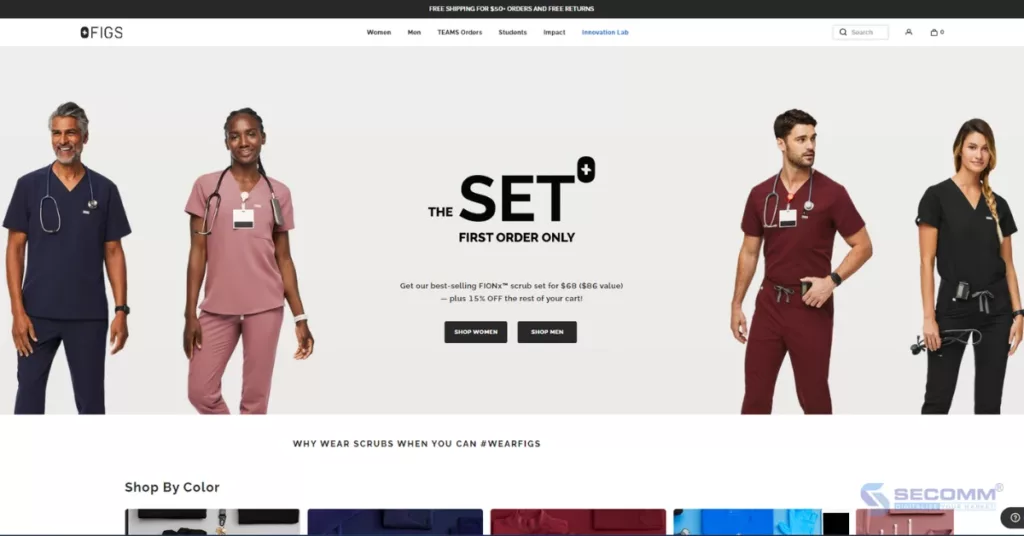
In particular, Figs has utilized Unbounce to create unique and tailored landing pages for products or promotional campaigns. Furthermore, they’ve integrated Next.js to link these customized landing pages seamlessly with the product pages on Shopify.
This approach ensures that when customers visit a specific custom landing page, they can easily locate and purchase products. Therefore, Figs has enhanced the shopping experience for customers, providing a seamless and user-friendly journey to quickly find the products of their interest.
- Website: https://www.wearfigs.com/
- Lĩnh vực: Thời trang
- Lưu lượng truy cập: 4.3 triệu/tháng
- Xếp hạng: 2,207 (Hoa Kỳ) & 9,573 (Toàn cầu)
Allbirds
Allbirds is an athletic and footwear brand founded in 2014 by Tim Brown and Joey Zwillinger. The brand is well-known for crafting shoes from sustainable sources and featuring simple, aesthetically pleasing designs. With the slogan “We make shoes to thank the earth,” Allbirds has experienced rapid growth, becoming a prominent name in the fashion industry as a whole and specifically in the footwear sector.
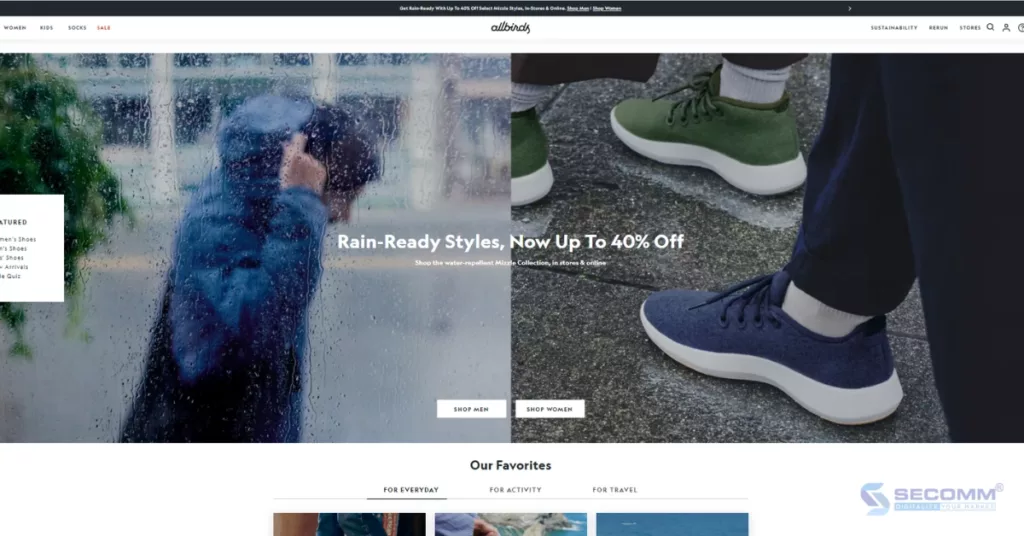
To provide an optimal online shopping experience for customers, Allbirds has deployed Headless Shopify Plus. The Headless architecture allows the brand to customize and control the user interface (frontend) flexibly and efficiently, while Shopify Plus is utilized for managing data and eCommerce operations on the backend.
The deployment of Headless Commerce has enabled Allbirds to create a user-friendly and distinctive interface, providing a unique shopping experience with advanced features.
- Website: https://www.allbirds.com/
- Industry: Fashion
- Traffic: 2.2M/month
- Ranking: 4,212 (USA) & 21,427 (Worldwide)
Rothy’s
Headquartered in San Francisco, California, Rothy’s is a well-known fashion brand that specializes in producing footwear from recycled materials, primarily utilizing post-consumer plastic fibers, especially PET. Rothy’s has become an icon capturing consumer interest by combining fashion elements with an environmentally-friendly mindset.

With a desire to “do things differently,” Rothy’s has embraced a Headless architecture to easily expand its presence to various international markets. The Headless architecture allows the brand the freedom to seamlessly integrate preferred technologies into the Shopify Plus eCommerce system.
Meanwhile, Rothy’s can develop independent frontends for each market, enabling adjustments in elements such as pricing and language to suit the specific consumers of each market. This approach helps Rothy’s create a unique and tailored shopping experience for the target customers in each market they serve.
- Website: https://rothys.com/
- Industry: Fashion
- Traffic: 1.6M/month
- Ranking: 6,083 (USA) & 31,084 (Worldwide)
Inkbox
Inkbox is a brand specializing in temporary tattoos that can be easily applied to the skin and nails. It allows users to have the temporary tattoos they desire without the commitment of a permanent one. Inkbox’s ink is made from natural ingredients, ensuring it is skin-friendly with the “Freehand Ink” technology. The brand is an example of leveraging creativity and technology to offer a temporary change for self-expression and image creation on the skin and nails uniquely and excitingly.
Inkbox has implemented Headless Commerce with Shopify Plus to provide an optimal shopping experience for customers, featuring prominent functionalities such as:
- Search suggestions with popular keywords
- Displaying products by size, category, and theme
- Allowing users to customize their tattoos
- Integrating multiple payment methods: PayPal, Apple Pay, Google Pay, Sezzle, and Afterpay.
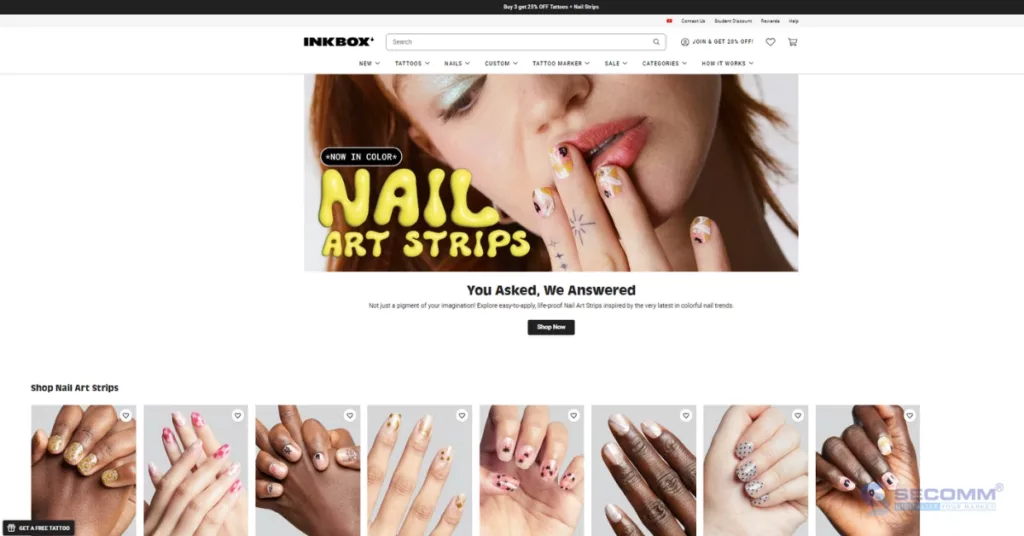
- Website: https://inkbox.com/
- Industry: Beauty
- Traffic: 1.3M/month
- Ranking: 9,560 (USA) & 31,846 (Worldwide)
Kylie Cosmetics
Since its establishment in 2014, Kylie Cosmetics has been widely embraced by consumers throughout North America, and Kylie Jenner was notably honored as a business genius by Forbes. Following the success of Kylie-branded cosmetics, in 2019 Kylie Jenner marked a new milestone by introducing the skincare line named Kylie Skin.

Quick to embrace the Headless Commerce trend, Kylie Cosmetics has implemented Shopify Plus for core functionalities on the backend, such as payment and delivery.
In addition, this platform provides the brand with exceptional flexibility to integrate third-party services for a more diverse range of custom operations on the frontend.
This enables Kylie Cosmetics to offer a unique and appealing online shopping experience for customers while benefiting from the robust and stable infrastructure of Shopify Plus.
- Website: https://kyliecosmetics.com/
- Industry: Cosmetics
- Traffic: 678.7K/month
- Ranking: 24,950 (USA) & 74,263 (Worldwide)
Vinamilk
Vinamilk is the national brand of Vietnam, offering a wide range of trusted dairy products such as fresh milk, yogurt, condensed milk, ice cream, and more. In 2023, Vinamilk implemented a repositioning strategy to strengthen its position in the domestic market and expand its business activities internationally.
As part of this strategy, Vinamilk integrated its eCommerce website and corporate website to provide a more consistent and seamless customer experience, as well as to manage data more efficiently.

Vinamilk collaborated with SECOMM to make a decisive move towards implementing the Headless Commerce + Headless CMS model based on the Shopify Plus eCommerce platform and a Headless CMS system.
The revamped appearance of Vinamilk’s website signifies a transformation from traditional to modern, from segregation to integration, and from focusing solely on sales to enhancing the overall customer experience.
- Website: https://new.vinamilk.com.vn/
- Industry: Dairy
- Traffic: 635.8K/month
- Ranking: 2,197 (Vietnam) & 103,735 (Worldwide)
ILIA
ILIA is a beloved clean beauty brand that has won numerous consumer awards. The brand was created to help users protect and restore their skin through safe and highly effective formulas.
Initially running on Shopify Advanced, ILIA’s eCommerce website quickly grew and upgraded to Shopify Plus for more flexible customization capabilities.
ILIA implemented Headless to provide diverse and impressive visuals, helping customers find the exact type of cosmetics suitable for their skin without creating a cluttered web experience that could impact performance and page loading speed.
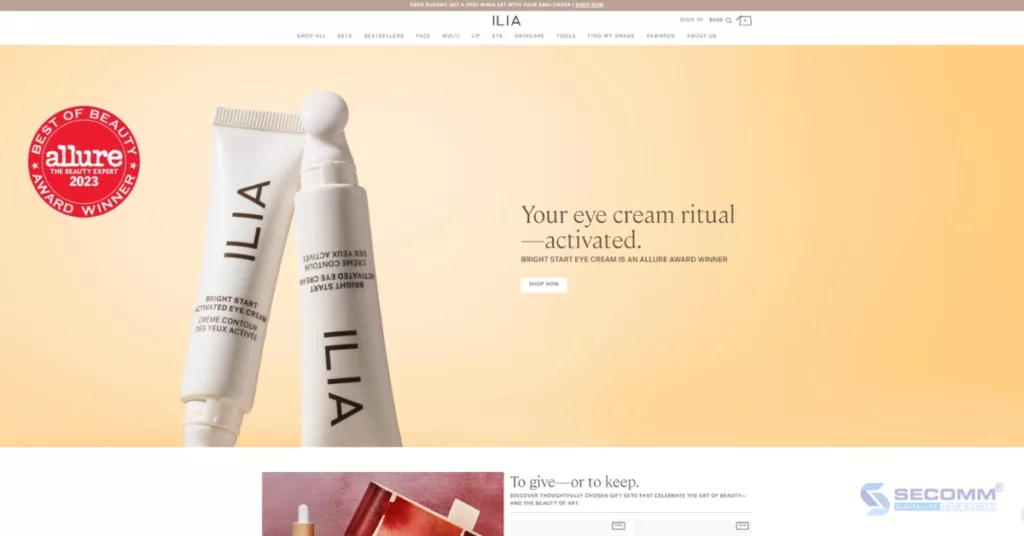
By deploying Headless Commerce on Shopify Plus, ILIA’s developers have the freedom to experiment with various types and formats of content. This approach has significantly improved the frontend capabilities, such as faster page loading speed, and has provided customers with an enhanced shopping experience, including the “Find My Shade” feature.
- Website: https://iliabeauty.com/
- Industry: Cosmetics
- Traffic: 530K/month
- Ranking: 20,571 (USA) & 107,803 (Worldwide)
Bols
Established in 1575, Bols is a brand specializing in cocktails that has been present in bars, restaurants, and airplanes worldwide for many years. After years of operation, the brand aimed to sell its products to consumers on a global scale. Therefore, Bols built an eCommerce website for both B2B and B2C models, placing a strong emphasis on customer experience.
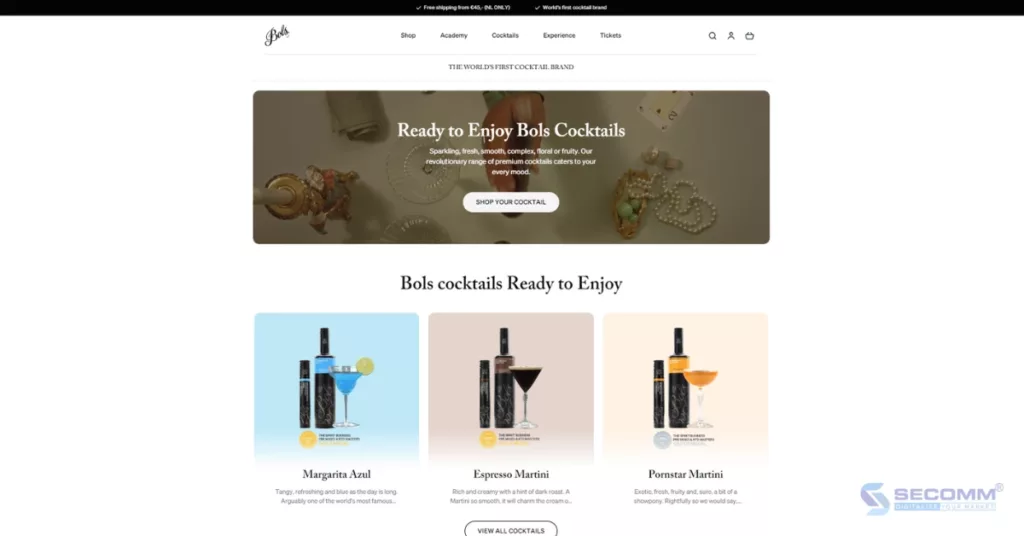
By deploying Headless Commerce on the Shopify Plus platform, Bols can flexibly customize the layout and design of the frontend interface, allowing customers to purchase cocktails, book events, buy event tickets, and register for mixology courses.
To date, Bols has built a community of over 20 thousand followers on Instagram and has integrated this social network into the website to share the latest cocktail recipes.
- Website: https://bols.com/
- Industry: FnB
- Traffic: 482.7K/month
- Ranking: 23,098 (Holland) & 619,828 (Worldwide)
Victoria Beckham Beauty
Victoria Beckham is known as an icon in the global fashion industry, and her talent and dedication are recognized by professionals and fans alike.
Victoria’s passion extends beyond fashion to the realm of beauty. Thus, in 2019, she co-founded the beauty brand Victoria Beckham Beauty.
The brand launched an eCommerce website with a focus on high performance, fast page loading speed, and smooth operation with a multilingual, multicurrency interface.
Therefore, Victoria Beckham Beauty decided to implement a Headless architecture, leveraging Shopify Plus Storefront API, Netlify hosting, combined with the Contentful Content Management System (CMS).
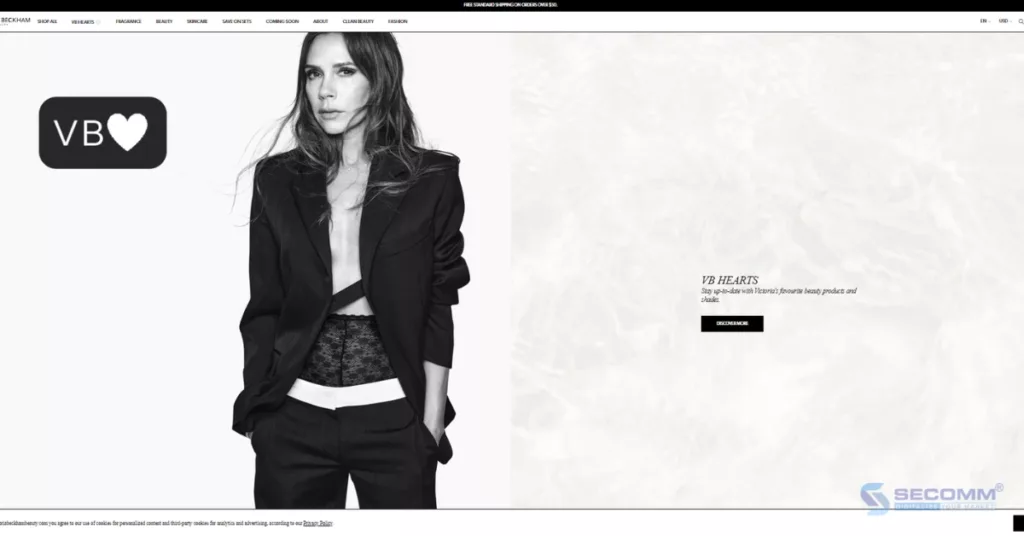
Shopify Plus assists this business in managing customers, orders, and inventory, and integrating multiple payment methods to provide a multi-currency experience. Meanwhile, Contentful provides outstanding CMS features to manage the rich data of Victoria Beckham Beauty.
- Website: https://victoriabeckhambeauty.com/
- Industry: Cosmetics
- Traffic: 365.7K/month
- Ranking: 41,886 (USA) & 126,562 (Worldwide)
Kotn
Kotn was founded with a mission to set standards for creativity and conscious consumerism, designing clothing based on principles that ensure quality, honest value, and a positive impact on society.
After launching a Headless eCommerce website with Shopify Plus in 2014, the brand continued to expand its product portfolio to meet customer demands. To provide customers with an exceptional experience, Kotn adjusted its approach for future development.

Kotn utilized the Shopify Storefront API to consolidate two stores into one, integrating with a new CMS system and customizing product pages and payment processes. This reduced the need for custom apps and related solutions, empowering staff to manage inventory, sales, and customer experiences more efficiently.
- Website: https://kotn.com/
- Industry: Fashion
- Traffic: 336.3K/month
- Ranking: 4,834 (Canada) & 122,434 (Worldwide)
Paul Valentine
Paul Valentine is a brand specializing in crafting and offering timeless and elegant jewelry. In just 8 years since its establishment in 2015, Paul Valentine has officially become a reputable jewelry brand, serving hundreds of customers worldwide.
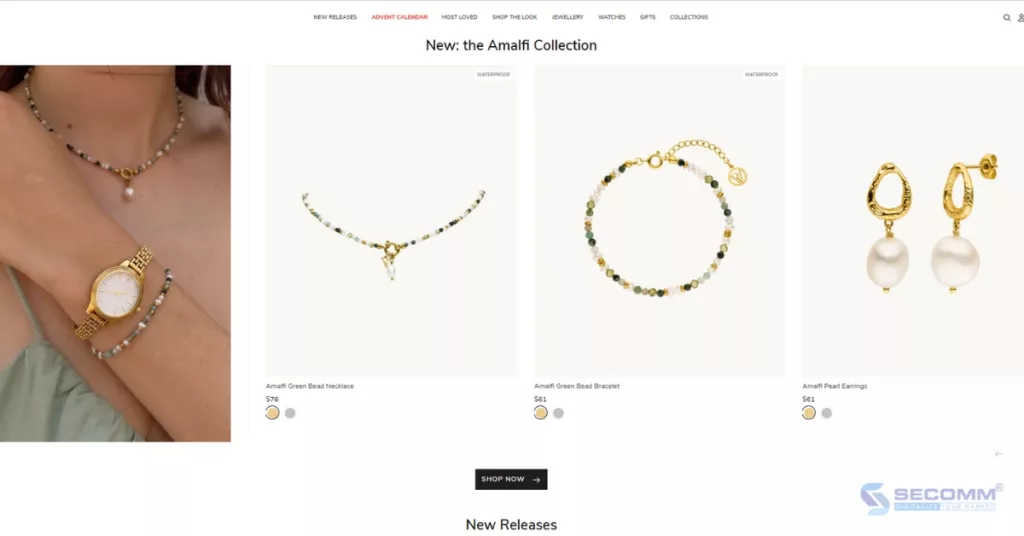
While the Paul Valentine website had previously been operated on Shopify Plus, a reset in its setup made content management across 12 local stores complex and less efficient.
Therefore, implementing the Headless architecture was deemed the most suitable approach to address this issue. Accordingly, Paul Valentine built a custom frontend interface using the Shopify Storefront API and the Vue.js framework.
Additionally, they integrated the Contentful system into the backend to unify content management and distribution across all stores.
This streamlined the management and operation of Paul Valentine’s eCommerce website, accelerated page loading speed, and ensured a smooth and consistent user experience.
- Website: https://int.paul-valentine.com/
- Industry: Jewelry
- Traffic: 168K/month
- Ranking: 16,087 (Germany) & 284,438 (Worldwide)
Veloretti
Veloretti is a well-known bicycle brand from the Netherlands, specializing in the production and supply of high-quality bicycles and accessories. The introduction of their first modern electric bicycle prompted Veloretti to completely rebuild its eCommerce website.
While competitors focus on technology, Veloretti chooses to design its website with a strong emphasis on fashion and lifestyle, utilizing unique layouts and video content.
For non-electric bicycle product pages, Veloretti uses a bright theme, while a dark theme is employed for electric bicycle product pages, ensuring the provision of sufficient technical information without sacrificing the brand’s fashion and core values.
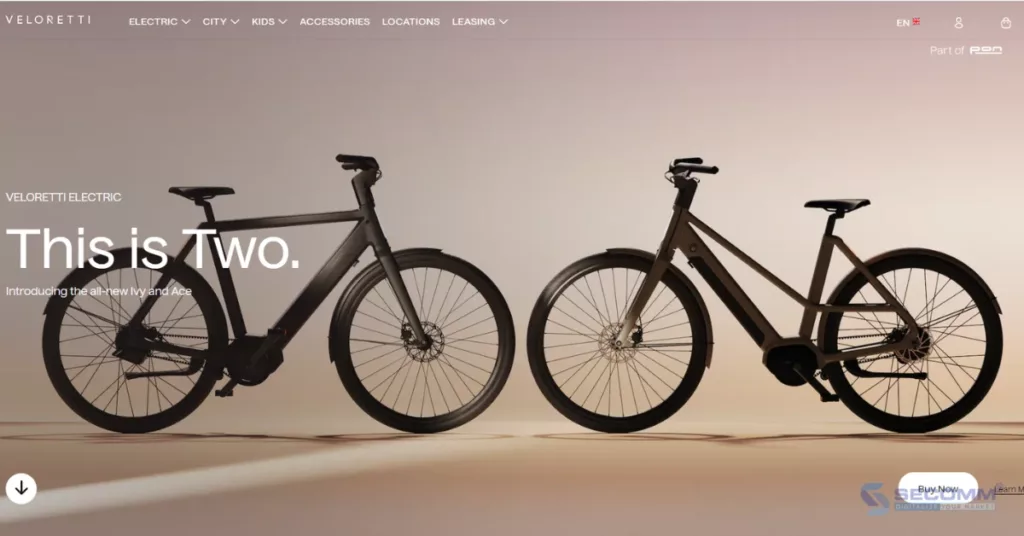
To achieve this, Veloretti has implemented the Headless architecture, with Shopify Plus serving as the backend platform. In addition, they use the Shopify Storefront API to connect the frontend and backend, facilitating easy and flexible access to data and functionality from Shopify.
Furthermore, Veloretti utilizes the React framework to build a custom frontend interface, providing customers with a unique and fashion-forward shopping experience.
- Website: https://www.veloretti.com/
- Industry: Consumer electronics
- Traffic: 145.4K/month
- Ranking: 8,114 (Holland) & 304,131 (Worldwide)
BonLook
BonLook is a renowned eyewear brand based in Montreal, with 37 branch stores across Canada. In addition to selling ready-made glasses, BonLook offers prescription lens-cutting services. Customers can upload their prescriptions, and choose lens materials, anti-blue light and anti-fatigue capabilities, frame sizes, and styles.

BonLook has developed a Headless omnichannel solution with Shopify Plus to provide a seamless shopping experience across various channels, from online to offline, incorporating unique features such as AR technology with “Virtual Try-On.” The brand also leverages applications within Shopify Plus Certified Apps to enhance conversion rates and foster loyalty through promotional programs and seasonal offers, attracting customers to return for more shopping.
- Website: https://www.bonlook.ca/
- Industry: Fashion
- Traffic: 112.8K/month
- Ranking: 7,778 (USA) & 294,314 (Worldwide)
Grass Roots Farmers’ Cooperative
Grass Roots is a cooperative of small-scale family farmers in the United States specializing in the production and sale of clean products such as pork, beef, chicken, lamb, and bone broth.
To provide users with the optimal online shopping experience, Grass Roots decided to implement a Headless Commerce solution on the Shopify Plus platform.
This allows Grass Roots to access the latest web technologies to create its unique customer experience with features such as
- Allowing customers to select product sizes and automatically display prices.
- Integrating a loyalty program with a referral rewards program.
- Integrating diverse payment methods such as Shop Pay, PayPal, and Google Pay.
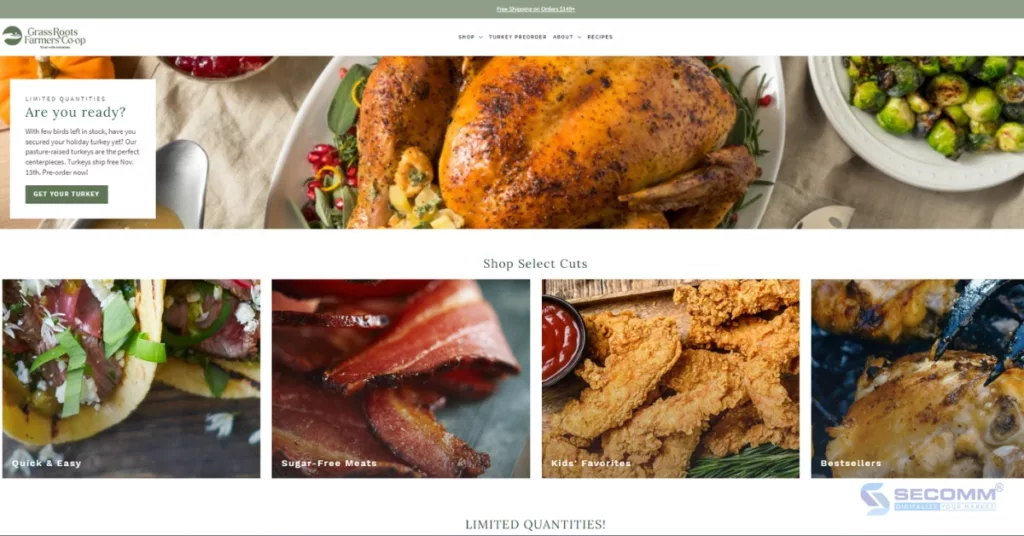
- Website: https://grassrootscoop.com/
- Industry: FnB
- Traffic: 68.7K/month
- Ranking: 105,894 (USA) & 649,318 (Worldwide)
Go Headless with Shopify Plus today!
Here are specific examples showcasing the unique and engaging customer experiences of 15 brands across various industries when implementing Headless on the Shopify Plus platform.
With its outstanding customization and scalability capabilities, Shopify Plus is one of the preferred SaaS platforms for large enterprises considering the adoption of Headless Commerce models, thanks to optimal solutions like Storefront API, Hydrogen + Oxygen, and Commerce Components.
Over the years, SECOMM has become a reliable partner for many large enterprises such as Vinamilk and Suzuverse in establishing Headless architectures for eCommerce websites. We take on the roles of consulting, planning, and accompanying businesses in building Headless Shopify Plus websites through each stage.
Contact SECOMM or call directly on the hotline (028 7108 9908) to start your Headless deployment project with Shopify Plus today!

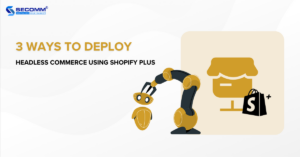
3 WAYS TO DEPLOY HEADLESS COMMERCE USING SHOPIFY PLUS
 08/01/2024
08/01/2024
 341
341
 2
2
 0
0
 1
1
Freedom in creativity and technical flexibility have ushered eCommerce into a new era with the Headless Commerce trend. In this scenario, Shopify Plus shines with its exceptional solutions that have positioned numerous businesses at the forefront of this trend.
Learn more: Brands go Headless with Shopify Plus
The combination of Shopify Plus infrastructure and the Headless architecture opens up various ways for businesses to create unique and customizable shopping experiences for their customers. Below are three common methods for implementing Headless Commerce with Shopify Plus.
Method 1: Employ the Storefront API
The Shopify Storefront API is a GraphQL-based API – a query language for APIs. It enables businesses to connect the frontend of their website to the backend of Shopify, facilitating easy access to data and eCommerce functionalities. Therefore, businesses can use the Storefront API to create unique and personalized customer experiences across various digital channels.
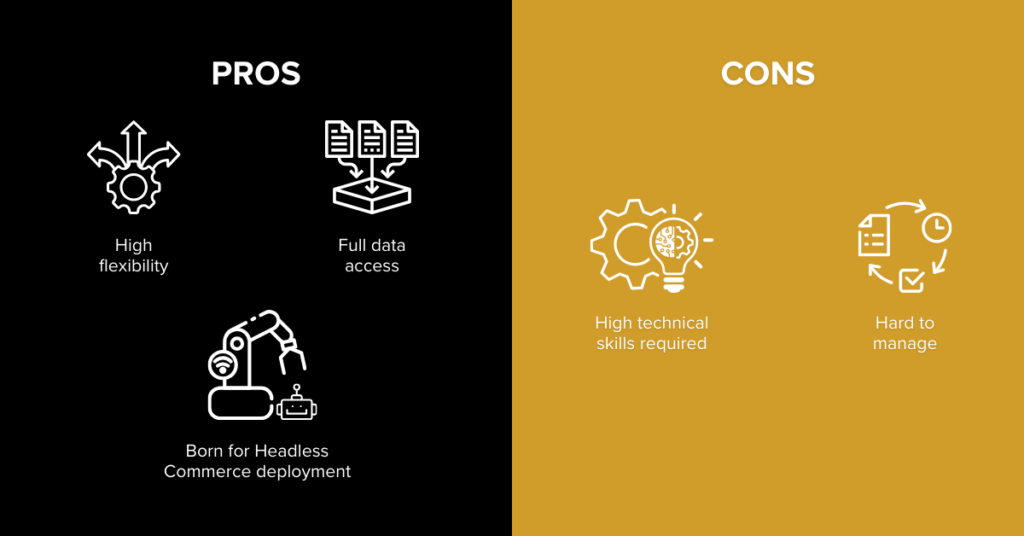
Pros
High flexibility: The Storefront API allows you to create independent websites. Instead of adhering to the constraints of pre-built themes, you can flexibly design product pages, homepages, and shopping carts in a style that accurately reflects your brand. The Storefront API also ensures flexibility in integrating with third-party systems while easily adapting the website to embrace new design trends.
Full data access: Through the Storefront API, you can access every aspect of the Shopify Plus database, including detailed information about products, orders, and customer data. This helps manage, monitor, assess trends, and optimize eCommerce data accurately.
Born for Headless Commerce deployment: Embracing the Headless Commerce model, which decouples the frontend and backend, allows for significant flexibility in eCommerce development and operations. The Storefront API is strategically optimized to seamlessly connect Shopify Plus’ backend with diverse frontends, ensuring a cohesive user experience across various channels and devices.
Cons
High technical skills required: Deploying Headless Shopify Plus using the Storefront API is a complex process that demands in-depth knowledge of the Shopify Plus platform, programming languages, and frameworks, as well as problem-solving skills to quickly address technical requirements. Particularly, you need to understand the data structure of Shopify, including how customer data, product information, and transactions are organized and stored within the system.
Hard to manage: The flexibility of the Storefront API complicates the process of managing and maintaining the system. While the flexibility of the Storefront API allows to customize every aspect of the eCommerce website, from the homepage to the checkout process, these custom configurations need to be well-managed. When there are too many custom configurations, updates may lead to compatibility issues within the overall system.
Method 2: Utilize the Shopify Hydrogen solution
The Shopify Hydrogen + Oxygen solution was introduced in 2021, and designed for large enterprises implementing Headless Commerce with Shopify Plus. Specifically, Hydrogen is a React-based framework – a popular framework for building user interfaces, enabling businesses to construct unique and visually appealing storefronts.
On the other hand, Oxygen is a global hosting solution capable of storing custom content. Shopify Oxygen is backed by Shopify’s infrastructure with over 100 server locations positioned worldwide. You don’t need to worry about finding third-party hosting providers or managing technical issues.
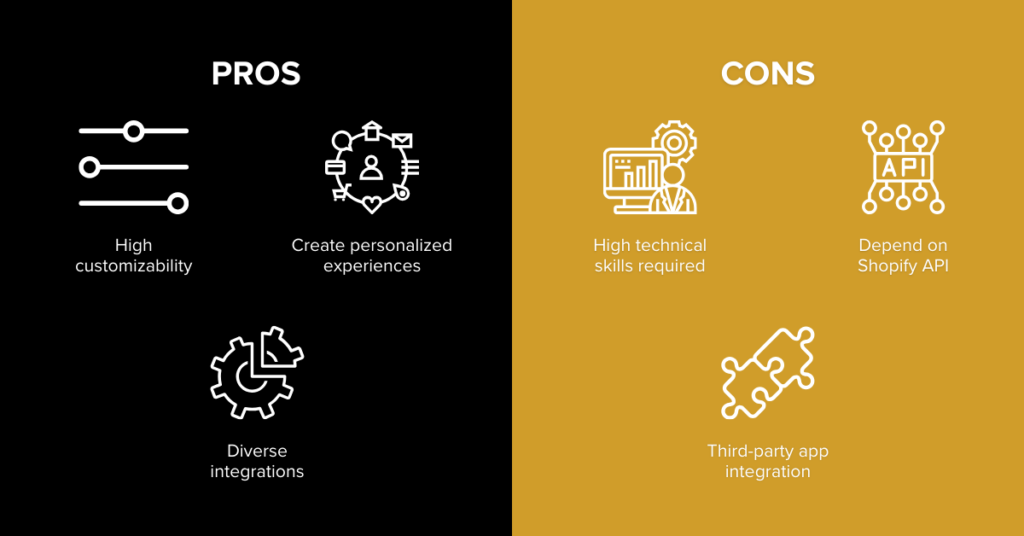
Pros
High customizability: Shopify Hydrogen allows you to customize the Headless website interface and implement necessary extensions. This means that merchants can use the latest technologies to build a Headless eCommerce website without worrying about impacting the system’s functionality.
Create personalized experiences: The Shopify Hydrogen solution offers high flexibility and customization, enabling you to implement Headless Commerce with this solution to easily create and deliver personalized shopping experiences for customers.
Diverse integrations: To help you create a seamless omnichannel experience, Shopify provides the capability to integrate the Headless Hydrogen website with various third-party applications such as Klaviyo, Gorgias, etc., as well as Headless CMS systems like Contentful, Sanity, Builder.io, etc.
Cons
High technical skills required: Shopify Hydrogen is a technically intensive solution and doesn’t have a drag-and-drop builder. Therefore, the process of implementing Headless Commerce with Shopify Hydrogen will demand a high level of technical expertise from the business.
Depend on Shopify API: This solution is developed exclusively for Shopify’s API. This means that the Hydrogen framework can only be used to build the Shopify website interface.
Third-party app integration: While Shopify allows you to easily integrate with 3rd-party apps and CMS, if you want to use a CMS or app for your online store that isn’t compatible with the Hydrogen framework, you’ll need to integrate it through a middleware app.
Method 3: Leverage the Commerce Components solution
The third method to adopt Headless Commerce with Shopify Plus is by using Shopify’s latest solution – Commerce Components. This is a modular component tech stack developed by Shopify specifically for large enterprises aiming to build Headless eCommerce websites. Shopify Commerce Components offer 30 components, encompassing core features across various business aspects such as Cart, Checkout, Data, Shipping, and more.
You can integrate these components based on deployment needs to create a customized solution for your Headless Shopify website. Since its launch, many world-leading businesses, including Mattel, JB Hifi, Glossier, Coty, Steve Madden, Spanx, and Staples, have utilized this new tech stack from Shopify.
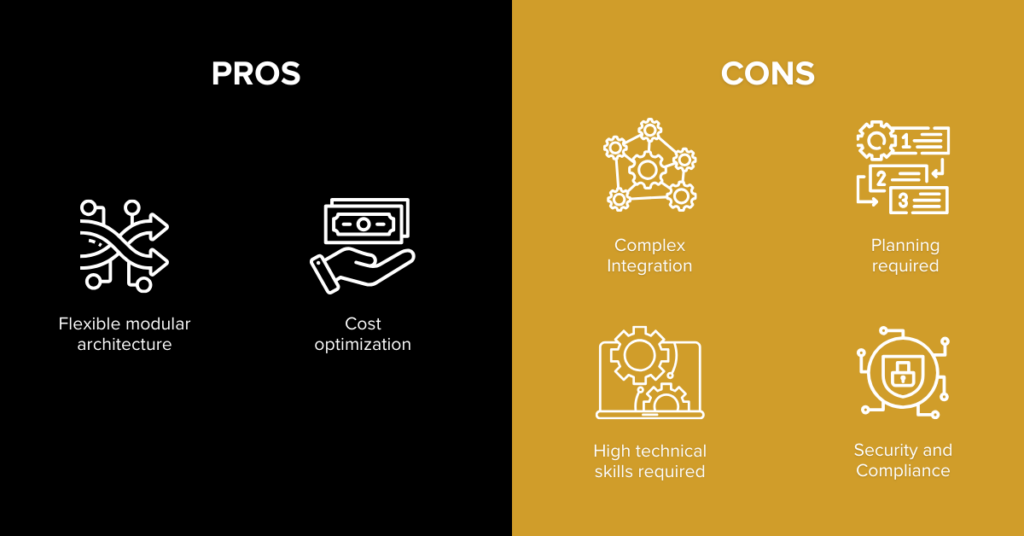
Pros
Flexible modular architecture: Commerce Components with a modular architecture provide unlimited API connections. This means you can integrate and use an unlimited number of components, while also easily adding, removing, and customizing these components without fear of affecting the system.
Cost optimization: Commerce Components have a pricing model based on the number of components used, meaning businesses pay for exactly what they use. Additionally, the cost of Commerce Components is billed annually, making it easier for businesses to accurately predict the fees they will incur.
Cons
Complex Integration: The process of integrating multiple components can be complex and time-consuming. Businesses need to ensure that the components operate independently and seamlessly within the same system efficiently.
Planning required: To ensure the effective operation of the components on the system, you need to meticulously plan which eCommerce components will be integrated, choose suppliers, deployment solutions, and deployment stages.
High technical skills required: Building and maintaining a Headless website system using the Commerce Components solution will demand a certain level of technical expertise and knowledge of integration and technology. You can invest in developing an in-house technical team or collaborate with highly specialized agencies.
Security and Compliance: Each provider for each eCommerce component will have its security protocols and compliance rules. You must ensure compliance with these rules when integrating their components, while also ensuring that this compliance doesn’t impact the operation of the remaining components and the entire system.
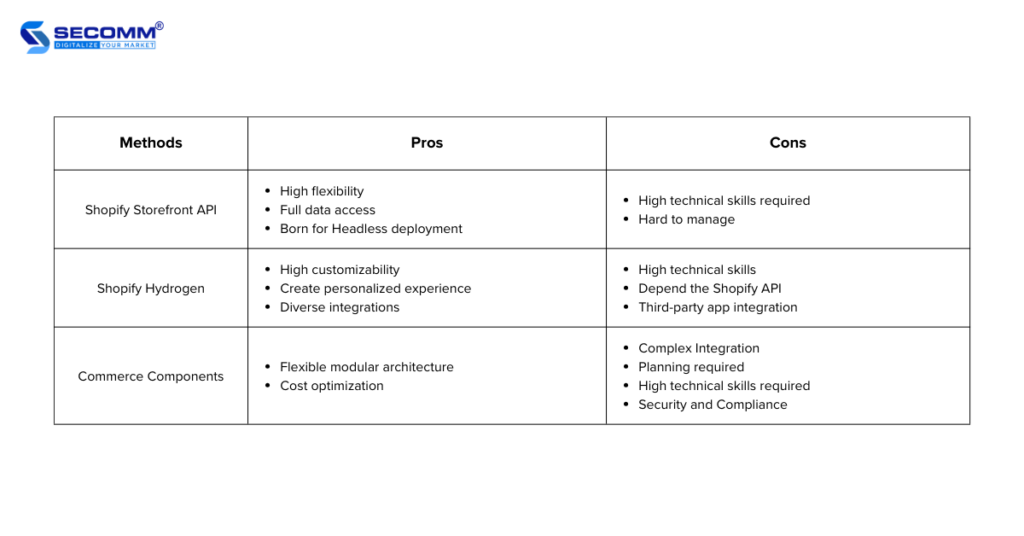
Choose your best-fit Headless Commerce deployment!
On the journey of building a Headless eCommerce website with Shopify Plus, choosing the deployment method is a crucial decision to ensure system flexibility and performance while providing the optimal customer experience.
If you need detailed guidance or want to explore how Shopify Plus can support your Headless deployment strategy, please contact SECOMM or call directly at (+84)28 7108 9908 to receive advice and assistance from our experts in choosing the right Headless Shopify Plus deployment method for the business model and goals.

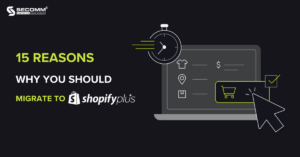
15 REASONS WHY YOU SHOULD MIGRATE TO SHOPIFY PLUS
 08/01/2024
08/01/2024
 3,334
3,334
 2
2
 0
0
 1
1
According to the Deloitte 2022 Retail Industry Outlook, up to 67% of businesses acknowledge that the eCommerce platform is their top investment priority due to issues they face with deploying outdated platforms.
Plus, a survey by Digital Commerce 360 revealed that about 27% of businesses are trying to switch their eCommerce platforms despite the associated costs.
Among the myriad of leading platforms today, Shopify Plus stands out as a perfect choice for businesses when deciding to re-platform.
This article will show you 15 reasons why you should migrate to Shopify Plus. Why the platform gains the attention of business leaders and how it can be the key to your development and success in today’s eCommerce landscape.
What is Shopify Plus?
It is a premium solution of the popular eCommerce platform – Shopify. This version is specifically designed to meet the needs of large businesses with a high investment budget for eCommerce.
It offers flexibility, scalability, and integration, not only helping efficiently build and run an eCommerce website but also providing advanced tools and features to optimize the customer shopping experience.
Why Re-platforming to Shopify Plus?
Here are 15 notable advantages that the platform offers for your business growth, laying the groundwork for you to consider migrating to Shopify Plus.
Intuitive Interface
The dashboard interface is designed to be intuitive and user-friendly, catering to end-users and administrators who directly manage the Shopify store. The intuitive interface allows you to concentrate on developing business strategies and enhancing the customer experience, minimizing the learning curve on how to use the system.
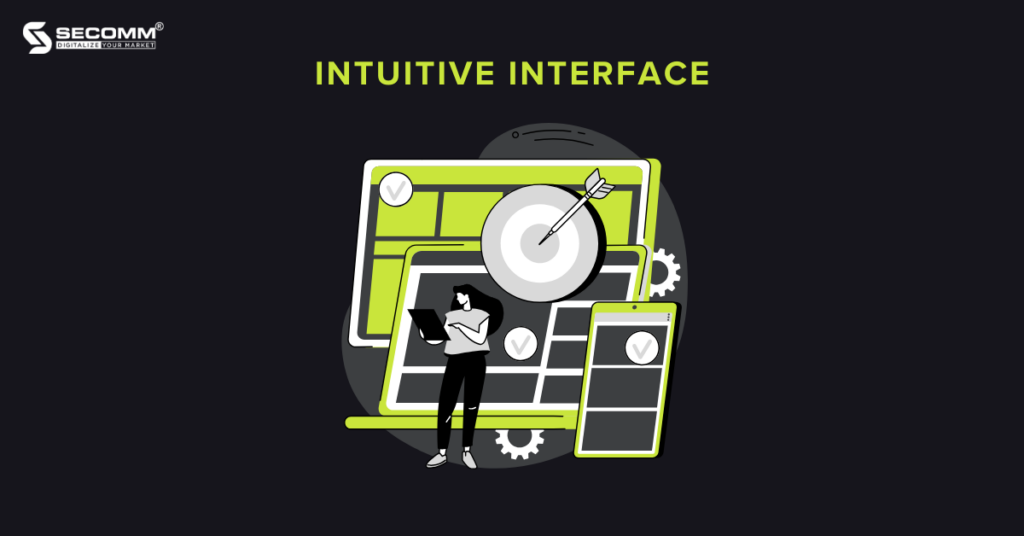
Easy-to-Estimate Costs
The second reason to migrate to Shopify Plus is the transparency in estimating and managing deployment costs. Typically, when using this platform, you may consider platform fees, transaction fees, app and add-on fees.
- Platform fee: Starting at $2000/month and increasing based on revenue
- Transaction fee: 0.15% when employing third-party payment gateways, with no charge when using Shopify Payments.
- App and add-on fee: These vary depending on the number of apps and extensions you use, ranging from a few dollars to several hundred dollars per month.
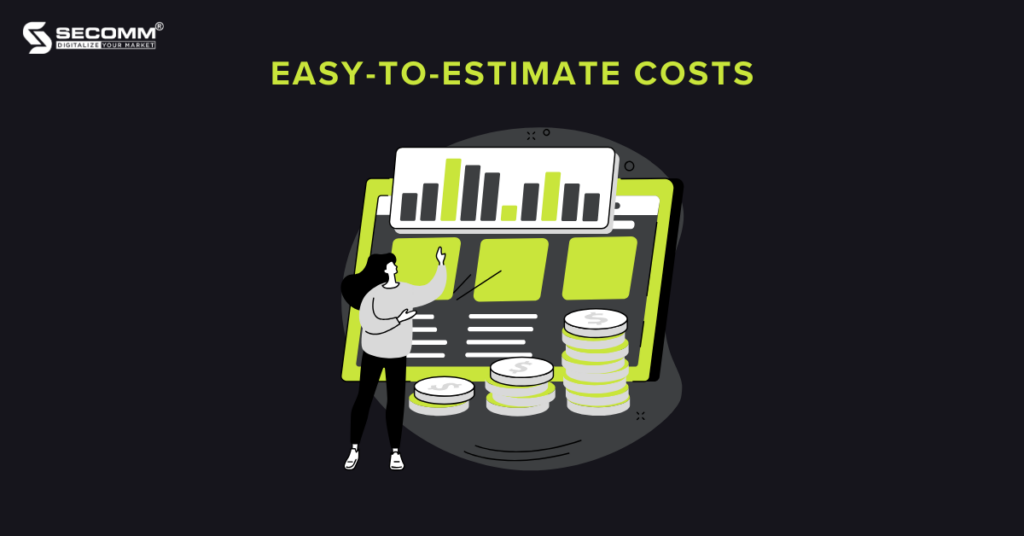
The Shopify Plus pricing system is clear and understandable, helping you know all the fees you need to pay monthly. This helps financial planning, avoiding unexpected fees during the deployment process.
Plus, if you partner with highly specialized technical development teams like SECOMM, we’ll conduct a detailed analysis and propose a phased deployment plan for the Shopify Plus eCommerce website. This approach allows you to gain clarity on how your system will be deployed at each stage, facilitating easy adjustments and flexible optimization of financial resources.
Automation
Another advantage of Shopify Plus is the automation feature. The platform provides two exclusive tools to help you facilitate this process: Shopify Flow and LaunchPad.
- Shopify Flow: A comprehensive automation tool that addresses various aspects of the Shopify Plus store. You can create automated rules to handle tasks such as automatic order identification and categorization, automated email sending, and automatic inventory updates.
- Shopify Launchpad: A tool for managing and coordinating significant events, from product launches to major promotional campaigns. You can automate tasks such as changing product prices, managing website content, and even opening/closing the Shopify Plus store based on preset schedules.
These automation tools help enhance efficiency and save time by streamlining various processes, allowing you to focus on strategic aspects of your operations.
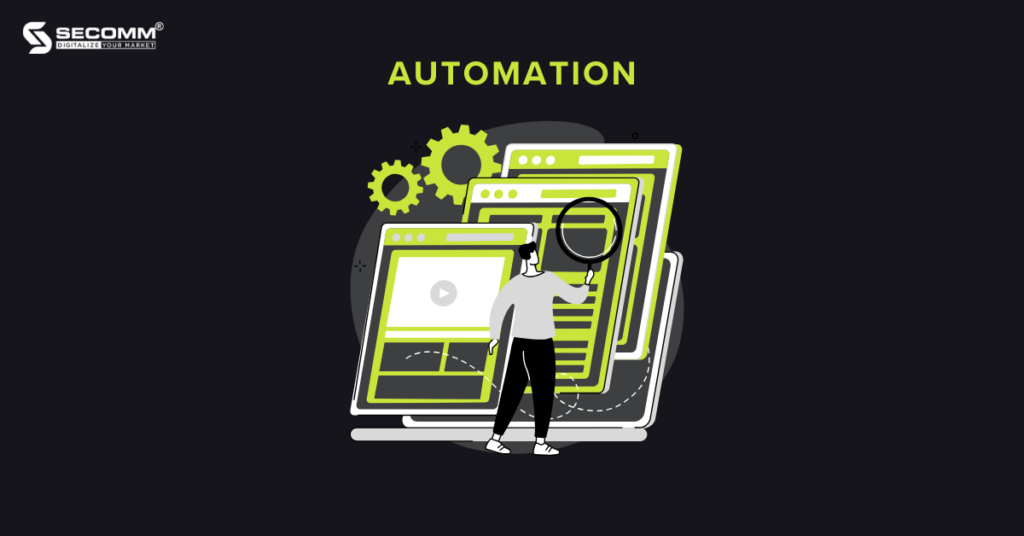
Omnichannel
Shopify Plus allows you to reach a broader audience through various sales channels, spanning from offline to online, including leveraging social media for sales and implementing B2B business models.
Plus, you can integrate the Shopify POS solution into their offline stores to offer services such as BOPIS (Buy Online, Pick Up In-Store) and BORIS (Buy Online, Return In-Store). This allows customers to shop in the manner that suits them, combining both online and in-store shopping experiences.
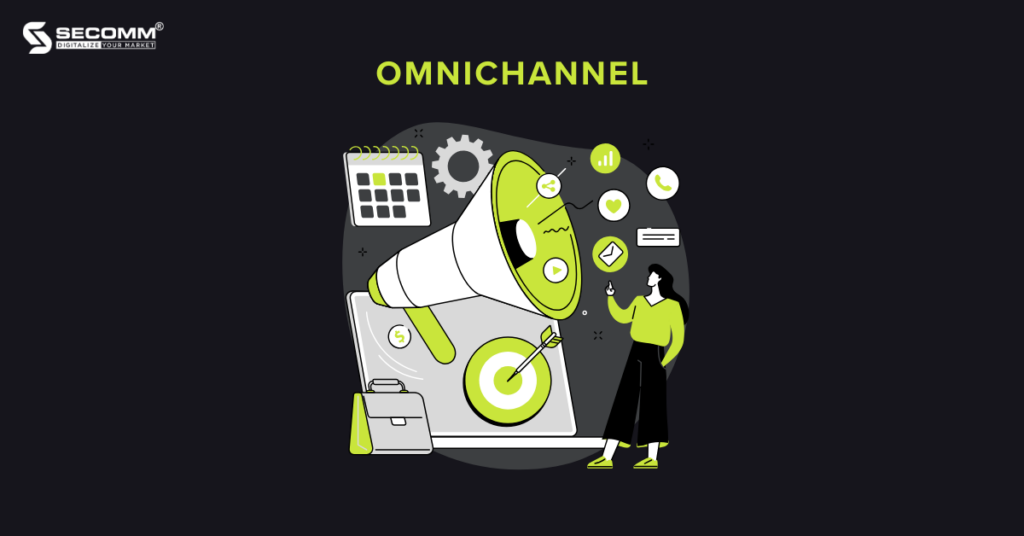
Global Selling
In 2021, Shopify introduced a comprehensive cross-border selling solution called Shopify Markets. With Shopify Markets, you can easily customize their stores for each specific target market. This includes setting prices, languages, payment methods, and delivery options to align with the preferences of local customers.
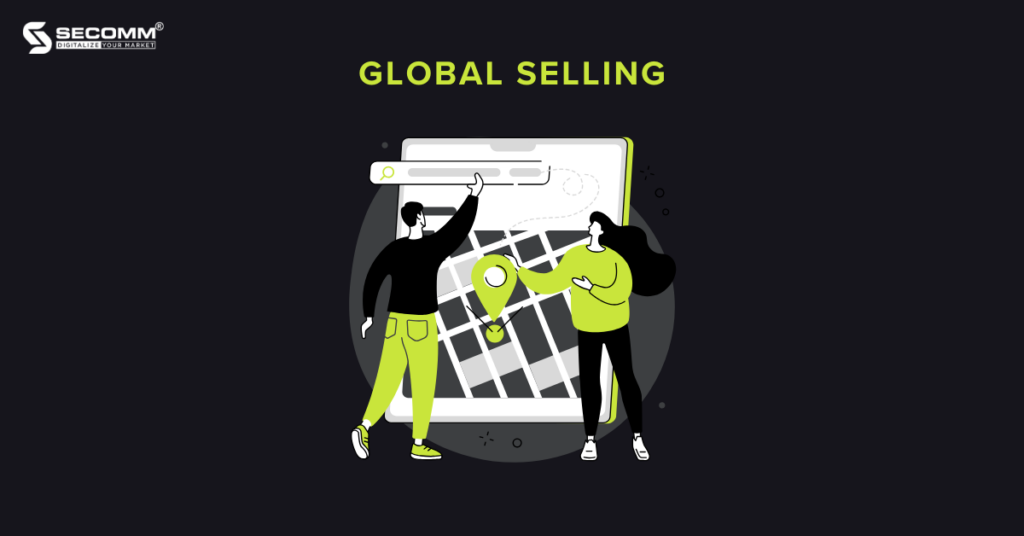
Flexible Customization
The robust customization is another reason for businesses to switch to Shopify Plus. This platform allows you to freely customize from the frontend to the backend without being constrained by any limits. In particular, you can easily customize the backend with Shopify Functions and Function APIs. Some use cases for Shopify Functions include:
- Customizing discounts
- Customizing the shopping cart and checkout
- Customizing payment options
- Customizing order fulfillment and delivery
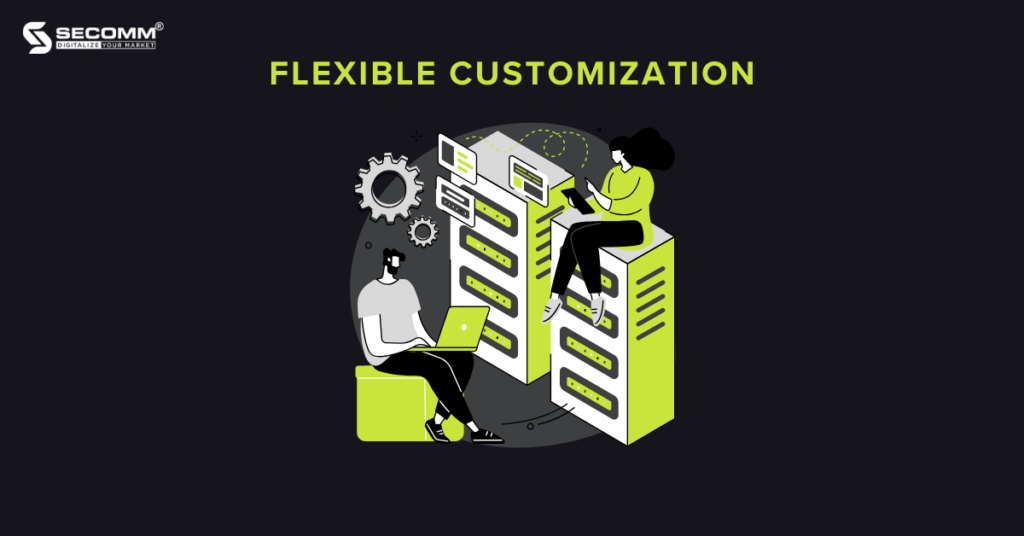
Extensive App Store
With the popularity of Shopify and Shopify Plus globally, it’s not surprising that Shopify owns a host of useful applications, some of which are specifically developed for businesses deploying Shopify Plus. Moreover, the ‘Plus’ provides diverse documentation and resources (Shopify Plus Certified App Program) for developers to create applications and extensions, contributing to the vast ecosystem of Shopify applications.
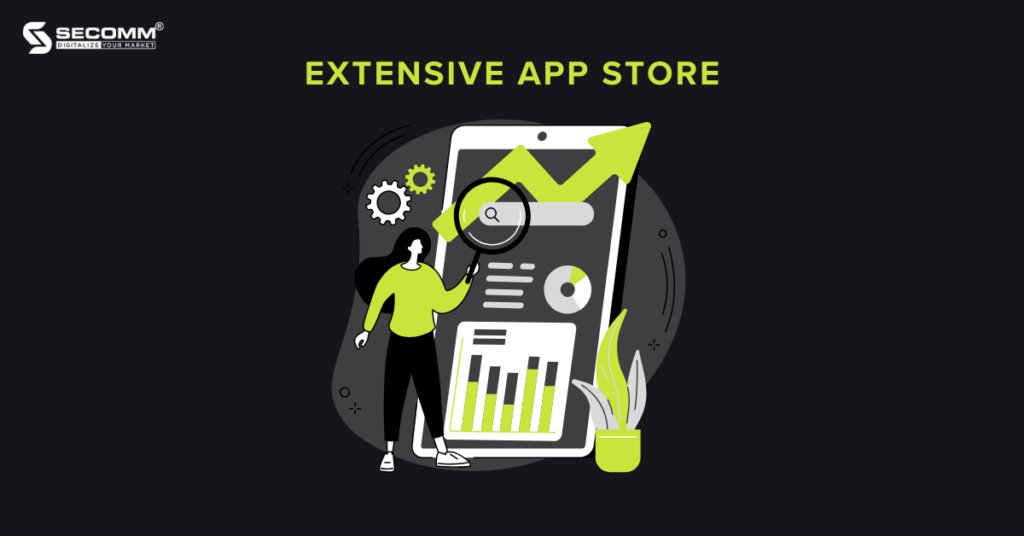
Rich Integration with Third Parties
Beyond integrating with solutions within Shopify, you can also integrate with third-party systems such as:
- Management software: ERP, CRM, PIM
- Social media platforms: Facebook, Instagram, Snapchat, Twitter, Pinterest
- Online marketplace: Amazon, Walmart, Ebay, Etsy
- Payment systems: Apple Pay, PayPal, Google Pay
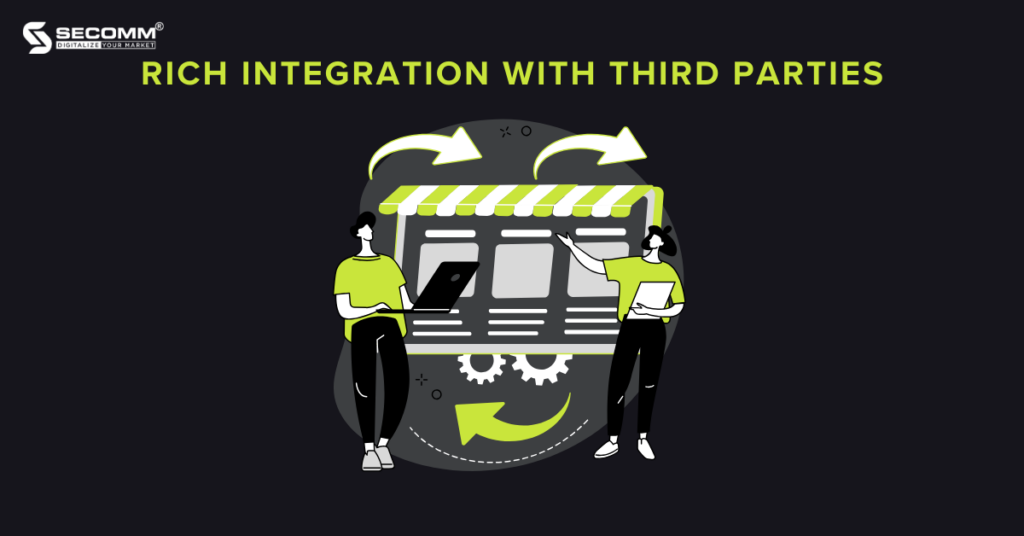
High Performance and stability
Shopify’s cloud infrastructure can cater to over 600,000 merchants and process speeds of up to 80,000 requests per second during peak periods. This system is built on a dedicated server cluster running Docker and utilizes Rails applications, alongside integrated additional features based on the AWS platform.
Therefore, Shopify Plus can provide powerful processing speed not only for the website but also during the checkout process. It can handle a massive number of visits while maintaining speed and ensuring a positive customer experience, processing over 10,000 orders per minute.
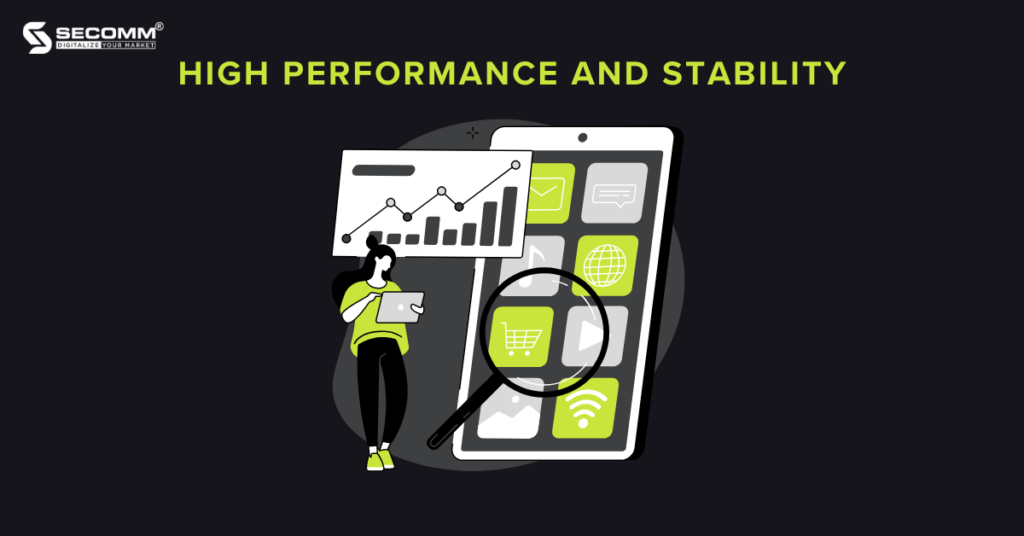
With unlimited bandwidth and flexible infrastructure, Shopify Plus can effortlessly scale to manage increased traffic during peak shopping seasons such as Black Friday, Cyber Monday, and Christmas. This enables you to handle high volumes of customers during peak times without concerns about technical issues or website disruptions.
Deploy Headless Commerce
The flexible customization of Shopify Plus also extends to providing maximum support for deploying Headless Commerce. Moreover, in 2021, the platform introduced the Hydrogen solution – an outstanding tech stack that can meet the highest requirements for building a Headless Commerce system.
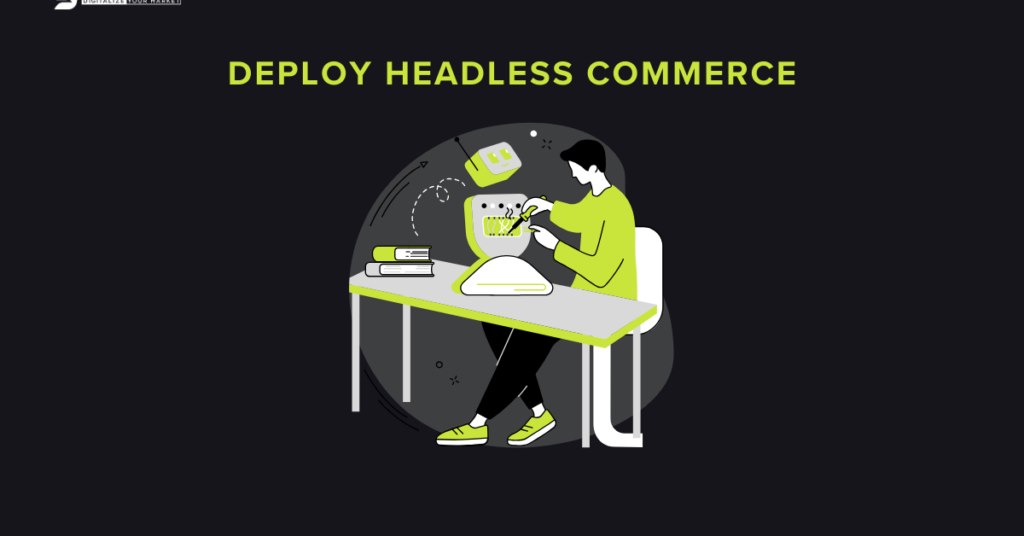
Deploy Composable Commerce
As the demand for flexibility and scalability continues to rise, alongside Headless Commerce, large businesses worldwide are increasingly focusing on the Composable Commerce model. Fortunately, Shopify is keenly attuned to customer needs and has recently introduced the Commerce Components by Shopify solution in early 2023.
As of the time of writing, Shopify stands as the first SaaS platform to provide a tech stack that can address nearly all the development needs of Composable Commerce.
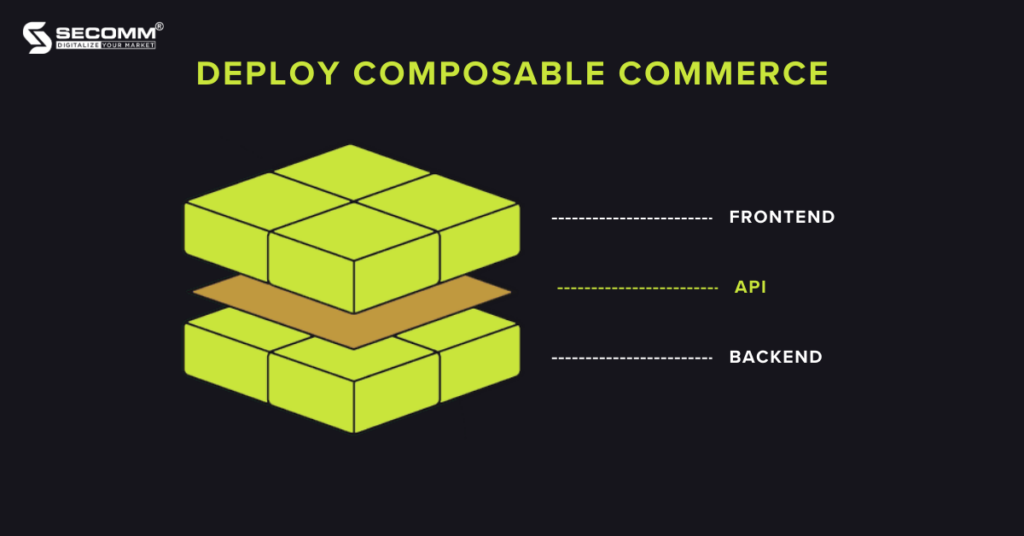
Quick to Go-live Process
While you may require considerable time to tailor your Shopify Plus store to your specific needs, the nature of SaaS ensures that the go-live process for Shopify Plus remains quicker compared to open-source platforms like Magento.
On average, the deployment and go-live time for the Shopify Plus platform is around 2-5 months, whereas with Magento, businesses take from 6-12 months to deploy and go live.
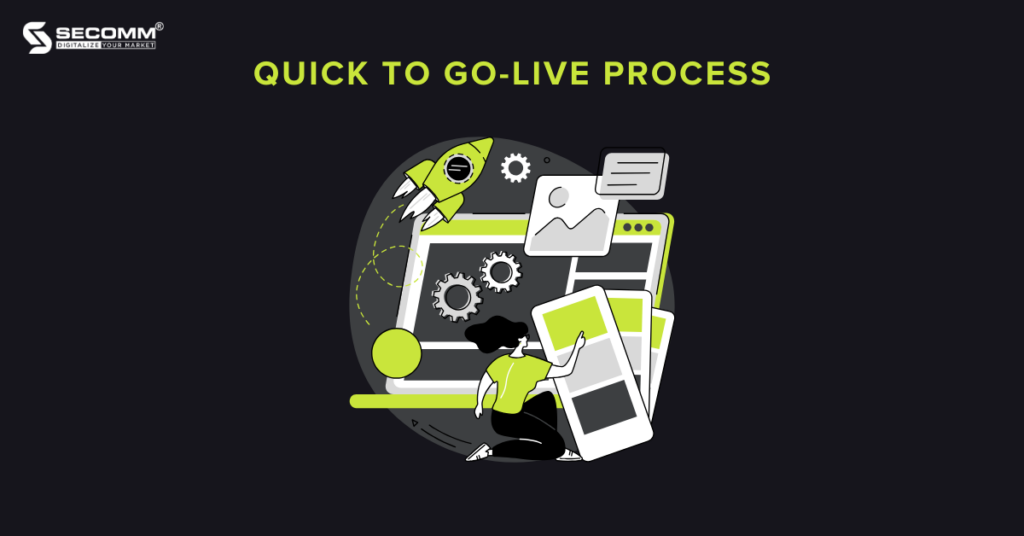
High Security
Shopify Plus provides a range of security measures and features to ensure that business data, customer information, and payment transactions are safeguarded to the highest extent possible. This includes:
- Compliance with 6 types of PCI standards (Payment Card Industry).
- Implementation of the highest level of data encryption.
- Provision of tools to detect potentially fraudulent transactions.
- Automated verification and adjustment of payment information to ensure actual transactions match payment profiles.
- Automatic data backups.
- Protection against Bot and DDoS attacks.
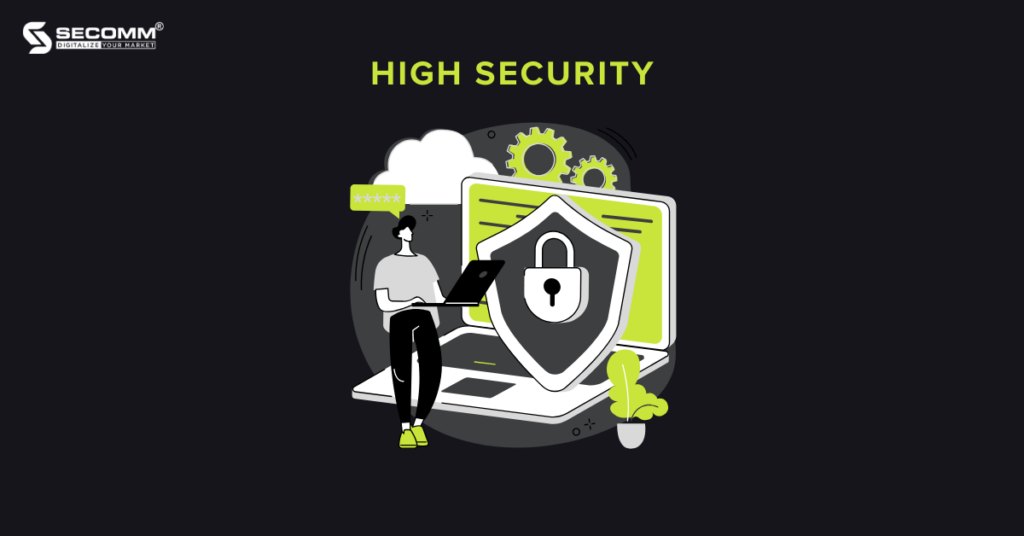
24/7 Customer Support
Similar to other eCommerce platforms, Shopify Plus provides businesses with 24/7 support through hotlines, emails, and video calls in various languages. Additionally, this platform offers instructional materials, API documentation, and the Shopify Plus Merchant Success program where businesses can access:
- Shopify Plus Academy
- Exclusive events and workshops
- Shopify Experts & Shopify Plus Partners
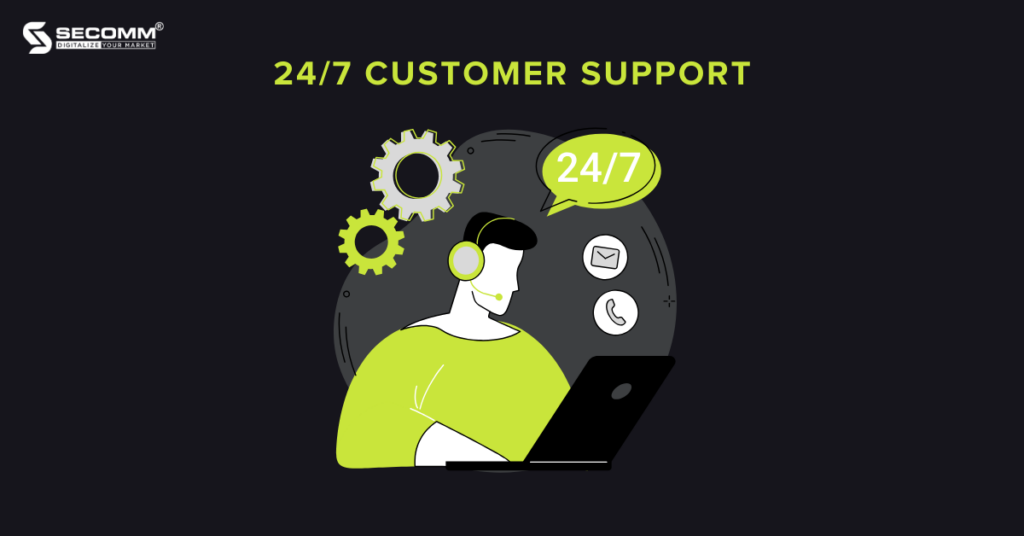
User-friendly ecosystem
Shopify Plus has a vast and diverse user ecosystem, including businesses, developers, and marketing experts. With numerous leading global businesses choosing Shopify Plus as a key tool to drive their growth and success, it is undoubtedly a testament to the excellence of this platform.
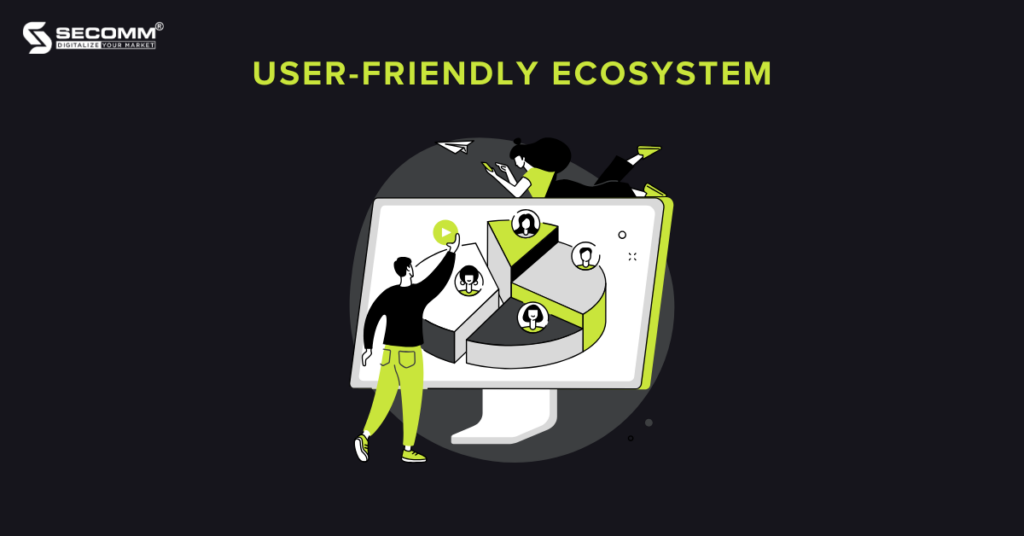
Renowned names such as Gymshark, Glossier, MZ Wallace, and Emma Bridgewater have leveraged the power of Shopify Plus to create customized shopping experiences, expand sales volumes, and reach a broader customer base. Their presence has added another reason encouraging you to switch to Shopify Plus.
Ready to migrate to Shopify Plus?
With flexible customization, scalability, and support from a reliable team of experts, the decision to deploy eCommerce with Shopify Plus or migrate from another platform to Shopify Plus has been right for sustained and competitive growth in the eCommerce landscape.
Contact SECOMM or call the hotline at 028 7108 9908 for advice and support to swiftly and effectively switch to Shopify Plus.


WHAT OPPORTUNITIES ARE OPEN TO THE JEWELRY ECOMMERCE?
 29/12/2023
29/12/2023
 7,149
7,149
 2
2
 0
0
 1
1
The jewelry eCommerce sector is a promising market experiencing swift growth. According to statistics, the global eCommerce jewelry market is currently valued at about 57.4 billion USD and is anticipated to reach approximately 117 billion USD by 2027.
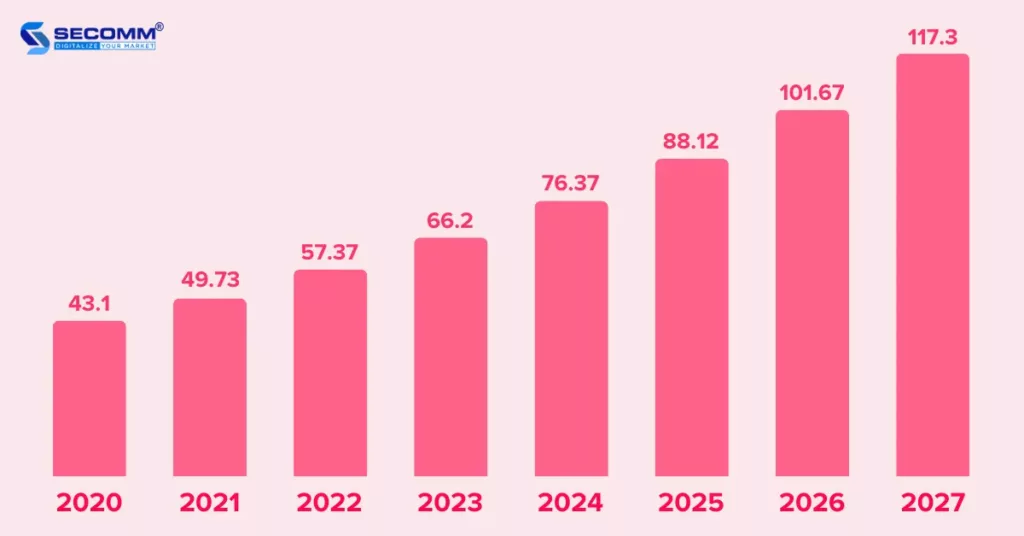
What is Jewelry eCommerce?
Jewelry eCommerce involves selling various jewelry items, including necklaces, rings, earrings, bracelets, gold, silver, diamonds, pearls, gemstones, and other pieces, conducted through online channels.
This type of eCommerce involves the purchase and sale of jewelry products through websites, applications, or online marketplaces.
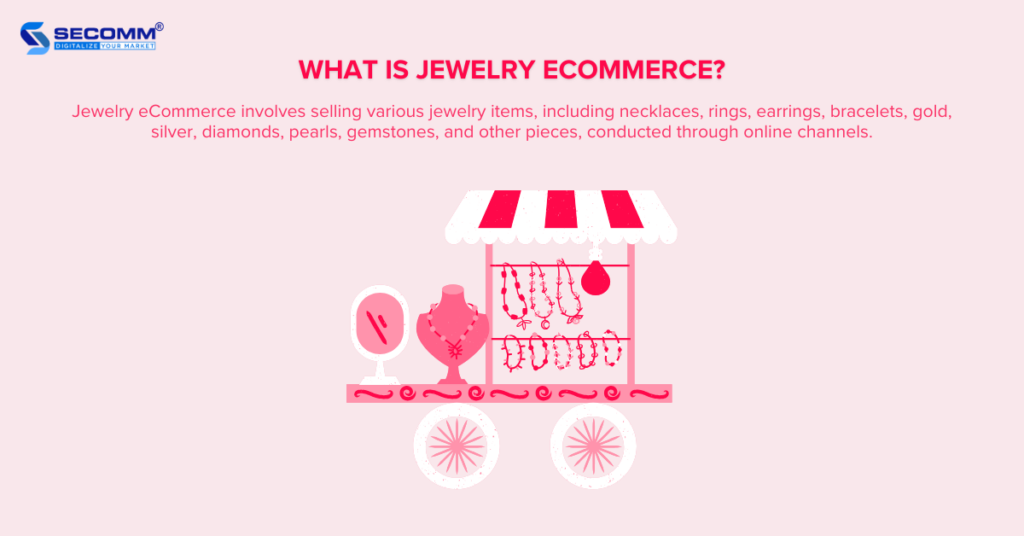
Opportunities for the jewelry eCommerce
Jewelry eCommerce is increasingly thriving, especially in the context of the COVID-19 pandemic. According to a report from the Vietnam eCommerce Association (VECOM), the Vietnamese jewelry eCommerce market is estimated to reach 10 trillion VND in 2022, showing a growth of 25% compared to 2021.
Several factors are driving the potential of jewelry eCommerce, including:
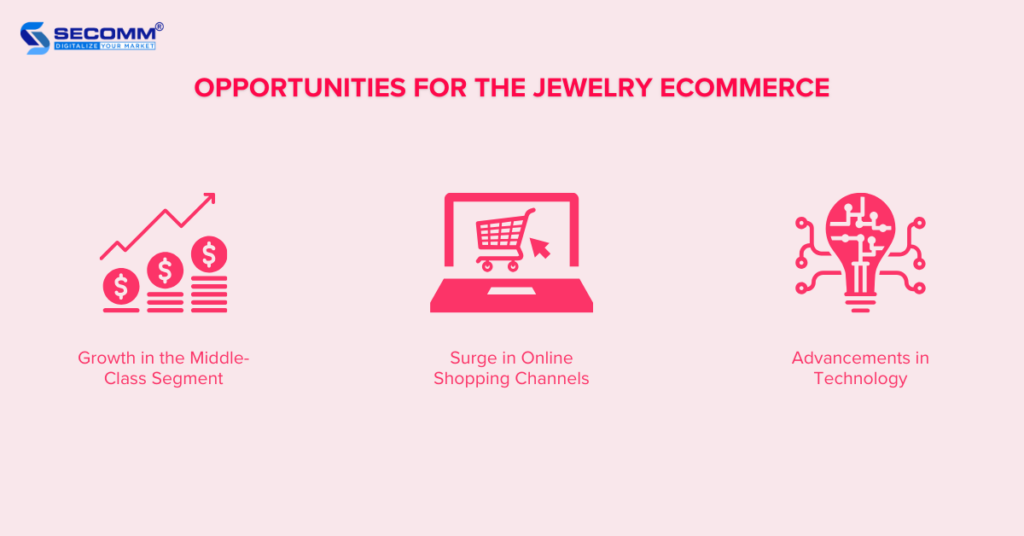
Growth in the Middle-Class Segment
According to the World Bank report, the middle class in Vietnam is steadily increasing, from 13% of the population in 2016 to 26% in 2026. It is expected that the middle class in Vietnam will continue to grow in the coming years.
On a global scale, according to the McKinsey Global Institute report, the global middle class is projected to increase from 1.8 billion people in 2020 to 4.9 billion people in 2030. This growth will generate significant demand for premium products and services, including jewelry and gemstones.
Surge in Online Shopping Channels
According to Metric report, as of June 2023, Vietnam has over 100,000 eCommerce websites, a 20% increase compared to 2022. The most popular product categories on Vietnam’s online marketplaces include fashion, home appliances, electronics, and jewelry.
On the international market, according to Statista’s report, as of June 2023, there are over 280 million active eCommerce websites worldwide.
The growth of online shopping channels, specifically individual eCommerce websites, has created many opportunities for jewelry eCommerce businesses to reach a larger audience, including customers in distant regions away from the main stores.
Advancements in Technology
The advancement of technology is one of the crucial factors driving the potential of jewelry eCommerce. When integrating innovative technologies like VR/AR, and AI into your jewelry website will enrich the online shopping experience, making it more engaging and appealing to customers.
- Using VR/AR: To create a shopping experience similar to traditional stores, making it easy for customers to choose and shop for jewelry online.
- Using AI: To develop algorithms to recommend jewelry products tailored to customer’s preferences and needs.
- Using chatbot: For enhancing 24/7 customer service, helping staff address customers’ inquiries or issues effectively.
Challenges of Jewelry eCommerce
Alongside the opportunities, jewelry brands still have to confront the challenges of the market
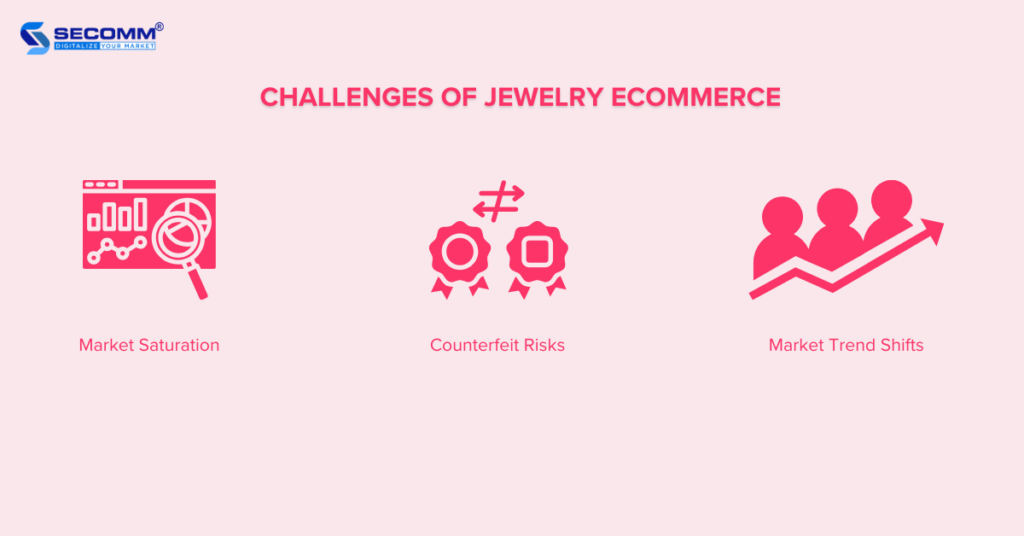
Market Saturation
The jewelry industry faces intense competition, with numerous businesses, both large and small, vying for market share. This requires jewelry brands to exert efforts to compete in terms of pricing, product quality, and the services they provide on their eCommerce website.
Counterfeit Risks
Counterfeit goods are often made from low-quality materials and are significantly cheaper than genuine products. This poses a significant challenge for the online jewelry market, as consumers struggle to differentiate between authentic and fake items, leading to adverse effects on jewelry brands.
Market Trend Shifts
Market trends are always changing, particularly in the jewelry eCommerce industry. It requires you to stay constantly updated to cater to evolving customer demands.
When purchasing jewelry products, customers desire an online shopping experience similar to in-store shopping. Because they want to view products directly, read reviews from other customers, and receive guidance from sales staff.
Jewelry brands deploying successful eCommerce
Tiffany & Co. (USA)
Tiffany & Co. is a premium jewelry brand headquartered in New York, USA, established in 1837 by master jeweler Charles Lewis Tiffany. The company embraced eCommerce early on and has become one of the largest online jewelry retailers globally.

Tiffany & Co.’s eCommerce website is built on the Adobe Enterprise Cloud platform, enabling the business to provide flexibility and scalability to meet customization needs and long-term development goals.
Leveraging resources from the leading Adobe Commerce eCommerce platform, the business has utilized Adobe Experience Platform Launch, Adobe Target, Adobe Experience Platform Identity Service, and more to deliver customized and personalized services for its customers.
Pandora (Denmark)
Pandora is a retail jewelry brand established in 1982 by Per Enevoldsen in Copenhagen, Denmark. The brand is known for customizable bracelets and other specially designed jewelry lines.
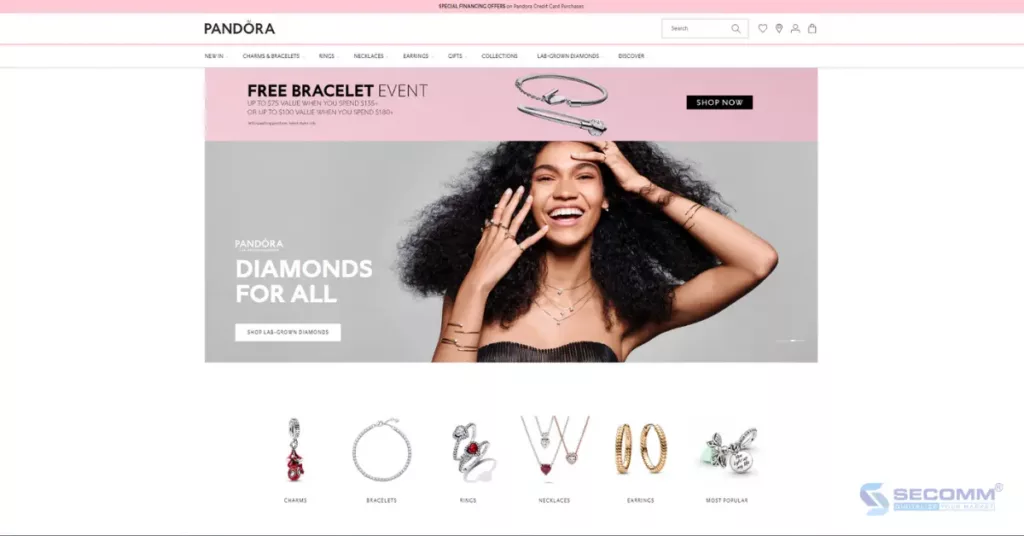
Pandora’s eCommerce website for the US and UK markets is built on the Salesforce Commerce Cloud platform, while the Vietnamese market utilizes Haravan. Therefore, the US and UK versions will have more specialized features such as wishlists, quick view, product comparison, loyalty programs, etc.
PNJ (Vietnam)
PNJ, or Phu Nhuan Jewelry, is a reputable jewelry brand with a long history and a widespread network of stores across Vietnam. Founded in 1988 in Phu Nhuan District, Ho Chi Minh City, Vietnam.

Initially, PNJ’s eCommerce website was built on the CS-Cart platform. As it grew, PNJ re-platform to WooCommerce to design its eCommerce website. This move benefits the PNJ website with many amazing features, including diverse payment method integration, product size customization, store location search based on province/city and district, and the flexibility of choosing between home delivery and in-store pickup.
The Bottom Line
In general, jewelry brands face numerous challenges and opportunities to make strides in the eCommerce landscape. Achieving success in this industry requires innovation, responsiveness to customer demands, and staying abreast of the latest technological trends.
Learn more: 10 Jewelry eCommerce Websites in Vietnam & Worldwide
Understanding both the opportunities and challenges when deploying jewelry eCommerce websites, SECOMM has a team of experts and a wide range of solutions to help you make it a reality.
Contact us or call the hotline at 028 7108 9908 to get started!


10 JEWELRY ECOMMERCE WEBSITES IN VIETNAM AND WORLDWIDE
 29/12/2023
29/12/2023
 5,691
5,691
 2
2
 0
0
 1
1
Jewelry eCommerce is a significant playground for many players. Exquisite jewelry pieces made from gemstones, gold, and silver are brought closer to consumers through eCommerce websites.
Brands worldwide, including those in Vietnam, not only strive to introduce a series of creatively innovative collections but also emphasize providing a better online shopping experience for customers.
Learn more: What opportunities are open to the jewelry eCommerce?
Let’s explore the allure of the jewelry world through the list of the 10 most notable jewelry eCommerce websites in Vietnam and around the world.
Cartier
With a history spanning over a century, Cartier has firmly established itself as a symbol of luxury and sophistication in the jewelry market.
Renowned for its exquisite and unique jewelry creations made from the finest gemstones and precious metals, including gold and silver, Cartier goes beyond merely producing and selling products.
The brand also offers services such as care, repairs, and gift packaging.

Cartier’s eCommerce website is meticulously crafted on the Salesforce Commerce Cloud, a leading open-source platform for eCommerce development. This choice ensures that the online shopping experience on Cartier’s platform is optimized to reflect the brand’s spirit and values.
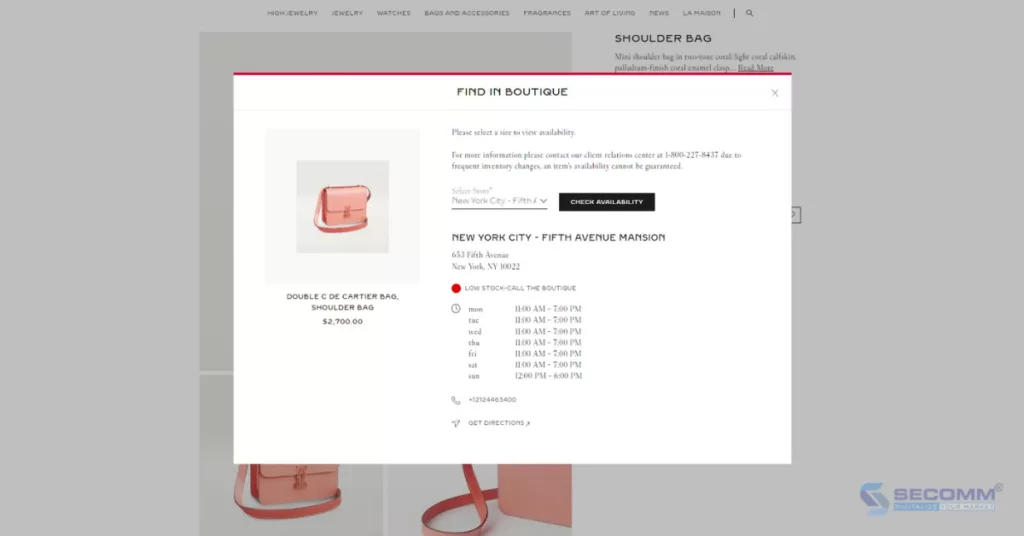
The website design embraces a minimalist approach and incorporates various features such as AR, allowing customers to examine products from different angles visually. Additionally, it features an intelligent search system that provides accurate results even if customers make typing errors and allows for checking product availability at any store.
- Website: https://www.cartier.com/en-us/home
- Platform: Salesforce Commerce Cloud
- Traffic: 4.5M/month
- Ranking: 6,451 (USA) & 13,088 (Worldwide)
Tiffany & Co
Tiffany & Co. stands as a premier and globally renowned jewelry brand. Its product range includes exquisite jewelry items such as rings, necklaces, earrings, and watches, crafted from precious metals like silver, gold, and platinum, along with precious gemstones such as diamonds, pearls, and green beryl.

Tiffany & Co.’s eCommerce website is built on the Adobe Commerce platform. offers flexibility and scalability to meet custom needs and long-term development goals. Similar to Cartier, Tiffany also provides customers with various services, including product selection advice and product care.
Notably, Tiffany’s website includes an outstanding store locator feature based on the radius, enabling customers to easily identify the nearest stores based on city, zip code, and offered services, facilitating a seamless shopping experience.
- Website: https://www.tiffany.com/
- Platform: Adobe Commerce
- Traffic: 3.9M/month
- Ranking: 3,859 (USA) & 15,330 (Worldwide)
PNJ
With over 30 years of reputation in the crafting and selling of high-end jewelry, PNJ is one of the most renowned jewelry and diamond brands in Vietnam.
PNJ offers customers a diverse and extensive selection of jewelry, catering to every need and aesthetic preference, from wedding jewelry, feng shui jewelry, diamond jewelry, colored stone jewelry, and Italian gold jewelry, to Disney and STYLE by PNJ jewelry.

PNJ’s eCommerce website is built using the PHP programming language, a popular and effective language for developing web applications. The website features a user-friendly interface, allowing customers to quickly and conveniently view, search, compare, and purchase jewelry products.
The website also includes several notable features, such as integrated diverse payment methods, product size selection, store search by province/city and district, and options for home delivery or in-store pickup.
- Website: https://pnj.com.vn/
- Platform: WooCommerce
- Traffic: 1.5M/month
- Ranking: 609 (Vietnam) & 31,342 (Worldwide)
ANA LUISA
Originating from New York, USA, ANA LUISA is a prominent jewelry brand with a vision of enhancing life through unique and luxurious jewelry pieces. ANA LUISA selects premium materials such as 14k gold, 925 sterling silver, lab-grown diamonds, and cultured pearls to create diverse collections suitable for every style and personality.
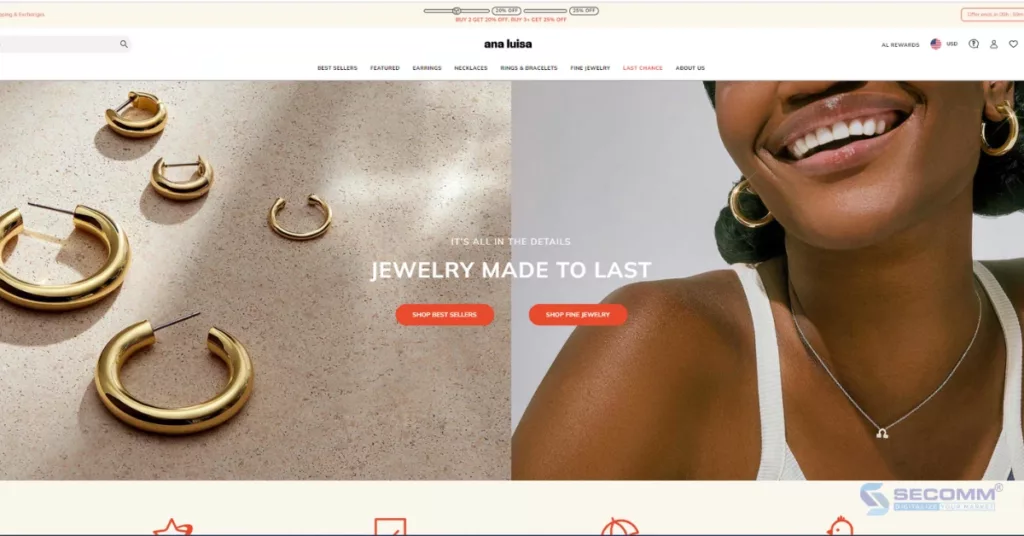
The eCommerce website of ANA LUISA is built and developed on the Shopify SaaS platform. The website features a simple and elegant design with a white color scheme, fitting seamlessly into the accessory and jewelry industry. ANA LUISA focuses on enhancing features to provide the best online shopping experience for customers.
Features include order tracking by order number and zip code, quick product view, pre-ordering with notifications upon availability, product recommendations based on viewing history, and displaying the number of products sold within the last 24 hours.
- Website: https://www.analuisa.com/
- Platform: Shopify
- Traffic: 766.5K/month
- Ranking: 16,224 (USA) & 63,302 (Worldwide)
Missoma
Missoma is a jewelry brand hailing from London, UK, specializing in gold and silver recycled jewelry with modern, refined, and distinctive designs. The brand features several standout jewelry collections, including Lucy Williams, Harris Reed, Savi, Zenyu, Molten, and many more.

The eCommerce website design of Missoma reflects the inherent sophistication and minimalism of the jewelry industry. The website is built and developed using Shopify, facilitating easy integration with a variety of third-party applications to enhance the customer shopping experience with richness and quality.
Some notable features of Missoma include the integration of diverse payment methods, including Buy Now Pay Later with Klarna; an automatic multi-currency conversion feature based on the user’s IP; product filtering based on material and size; and the incorporation of the loyalty program “The Rewards Stack” for loyal customers.
- Website: https://www.missoma.com/
- Platform: Shopify
- Traffic: 677.9K/month
- Ranking: 41,016 (USA) & 71,199 (Worldwide)
Miansai
Founded by Michael Saiger in 2008, Miansai is a leading American jewelry brand. Miansai specializes in creating simple, elegant, and unique designs for both men’s and women’s jewelry, using carefully selected and handcrafted raw materials. The brand offers various jewelry collections, including necklaces, bracelets, rings, earrings, keychains, and many other accessories.

Miansai also utilizes the Shopify platform to build its eCommerce website, incorporating industry-specific features such as product size selection, product and collection filtering and searching, automatic currency conversion based on the user’s IP, search suggestions, and integration with social media platforms like Facebook, Pinterest, and Instagram.
- Website: https://www.miansai.com/
- Platform: Shopify
- Traffic: 492.8K/month
- Ranking: 25,554 (USA) & 85,542 (Worldwide)
Catbird
Catbird is a high-end jewelry brand established in 2004 in New York City, USA. The brand is known for its sophisticated and artistic designs. Catbird’s products are crafted from various materials, including gold, silver, gemstones, and more.

The eCommerce platform of the Catbird jewelry website is Magento Open Source, offering exceptional flexibility that allows the brand to build a range of enhanced features for a smooth and enriching shopping experience for customers.
Some notable features on the Catbird eCommerce website include product search and filtering, product size selection, personalized jewelry customization options, and automatic currency conversion based on the user’s IP.
Notably, the Catbird website includes a “Web Accessibility” feature, allowing customization of website accessibility, including adjusting viewing modes for users, modifying content size and alignment, and changing interface colors.
- Website: https://www.catbirdnyc.com/
- Platform: Magento Open Source
- Traffic: 487.6K/month
- Ranking: 20,501 (USA) & 95,772 (Worldwide)
Huy Thanh Jewelry
Huy Thanh Jewelry is one of the renowned jewelry brands in Vietnam. With a mission to bring beauty and value through each piece of jewelry, the brand has made a mark in the hearts of consumers with its exquisite and unique products, handcrafted from precious gemstones and metals such as gold and silver.

The Huy Thanh Jewelry eCommerce website is built on the Haravan Enterprise platform, one of the popular eCommerce platforms in Vietnam. Some notable features of the Huy Thanh Jewelry website include product filtering and search, customization of size, material, and color, as well as integration with various social platforms and payment methods.
- Website: https://www.huythanhjewelry.vn/
- Platform: Haravan Enterprise
- Traffic: 103.8K/month
- Ranking: 8,851 (Vietnam) & 392,057 (Worldwide)
EROPI
EROPI is another prominent jewelry brand in Vietnam specializing in distributing various types of gold, silver, jewelry, gemstones, pearls, wedding jewelry, and feng shui jewelry. After many years of operation, the company has expanded its chain of stores nationwide and developed an online sales channel to meet the shopping needs of customers.
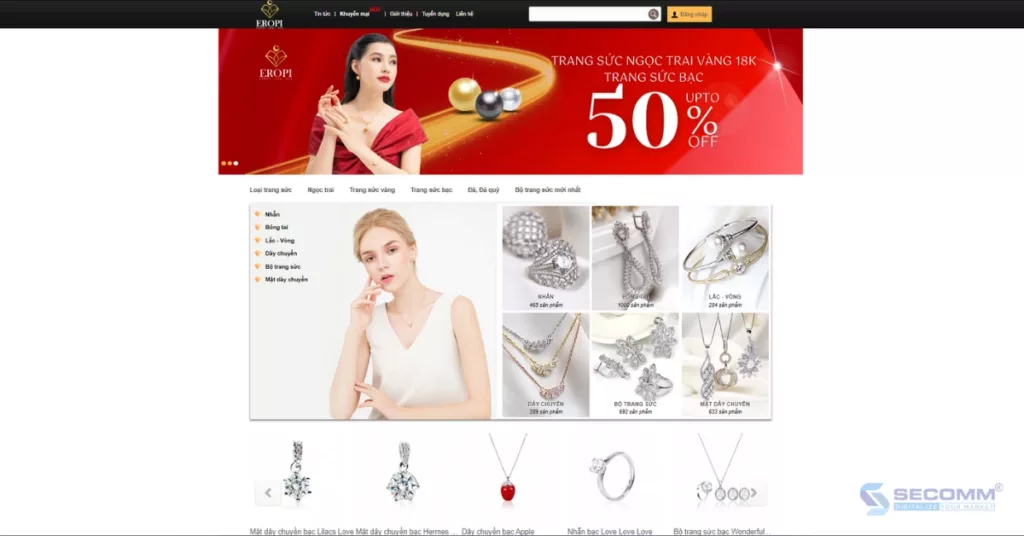
EROPI’s primary online channel is its eCommerce website, which has been invested in and built on the Magento Open Source platform. With excellent customization capabilities, this platform allows EROPI to create advanced features and flexible expansion capabilities, ensuring the long-term development goals of the business.
- Website: https://eropi.com/
- Platform: Magento Open Source
- Traffic: 95.8K/month
- Ranking: 13,832 (Vietnam) & 602,063 (Worldwide)
STONE AND STRAND
STONE AND STRAND is a jewelry brand established in 2013 in the United States. STONE AND STRAND offers a range of jewelry products, including rings, necklaces, earrings, and various other jewelry designs. All products are designed with exquisite craftsmanship and perfect details, reflecting the brand’s creative vision.

The STONE AND STRAND website is built on the Shopify eCommerce platform, one of the preferred platforms for many jewelry brands worldwide. In addition to an easily filterable and searchable product portfolio, the website also features order tracking via email and integrates multiple payment methods, including Buy Now Pay Later with Affirm.
- Website: https://www.stoneandstrand.com/
- Platform: Shopify
- Traffic: 76.6K/month
- Ranking: 153,686 (USA) & 578,874 (Worldwide)
Start your jewelry eCommerce website today!
Above are 10 amazing jewelry eCommerce websites in Vietnam and worldwide. This is evident that modern jewelry brands are not only focusing on developing their business through traditional retail channels but have rapidly embraced and expanded in the online space.
A well-designed and appealing eCommerce website not only helps these brands connect with a large pool of potential customers but also reflects their professionalism and vision.
With an in-depth understanding of eCommerce and a wealth of experience in successfully developing jewelry website projects, SECOMM will help you enhance your online presence quickly and effectively.
Contact us or call the hotline at 02871089908 to start deploying your first jewelry eCommerce website today!

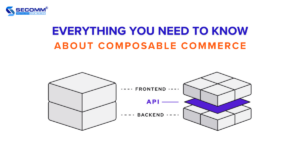
EVERYTHING YOU NEED TO KNOW ABOUT COMPOSABLE COMMERCE
 28/12/2023
28/12/2023
 4,502
4,502
 2
2
 0
0
 1
1
As Monolithic architecture solutions face flexibility, customization, and scalability challenges, businesses are increasingly exploring more adaptable architectures, like Headless Commerce.
Alongside this, the concept of ‘Composable Commerce’ has gained prominence as a robust model to cater to the evolving needs of businesses and the swiftly changing market.
So, what exactly it is, and how does it distinguish itself from Headless Commerce? Let’s investigate these aspects to comprehend why it might represent a revolutionary leap forward.
What is Composable Commerce?
The term ‘Composable Commerce’ was first coined by Gartner Research in June 2020, referring to building a flexible and customizable e-commerce system by integrating various components to build distinct ‘Packaged Business Capabilities’ (PBCs) solutions tailored to the deployment needs. These PBC solutions can connect through APIs.
The PBCs may include:
- Storefront
- Catalog
- Inventory
- Cart
- Checkout
- Payment
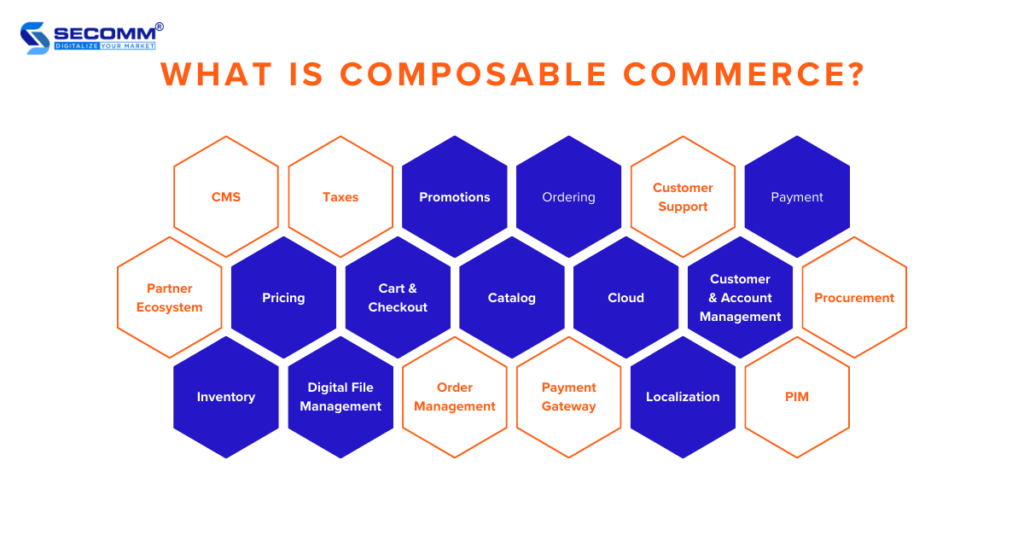
If we consider components as smaller and more intricate elements of the eCommerce system, PBCs represent the integration of each of these smaller components to craft a unique eCommerce solution tailored to each business. In this scenario, components are on an equal footing, and so are the PBCs.
Therefore, any modifications or expansions in any component or PBCs won’t impact the overall operation of the entire system.
To put it more simply, within the composable architecture, you build your eCommerce system much like assembling a Lego set.
Here, each PBC corresponds to a specific Lego block with a designated function. These blocks can seamlessly combine and link through APIs, resulting in a flexible and personalized eCommerce experience that aligns with your initial needs and wants.
Hence, the eCommerce development model allows you to attain the utmost flexibility and optimization for your eCommerce system.
Pros of Composable Commerce
Some benefits to highlight when adopting Composable architecture:
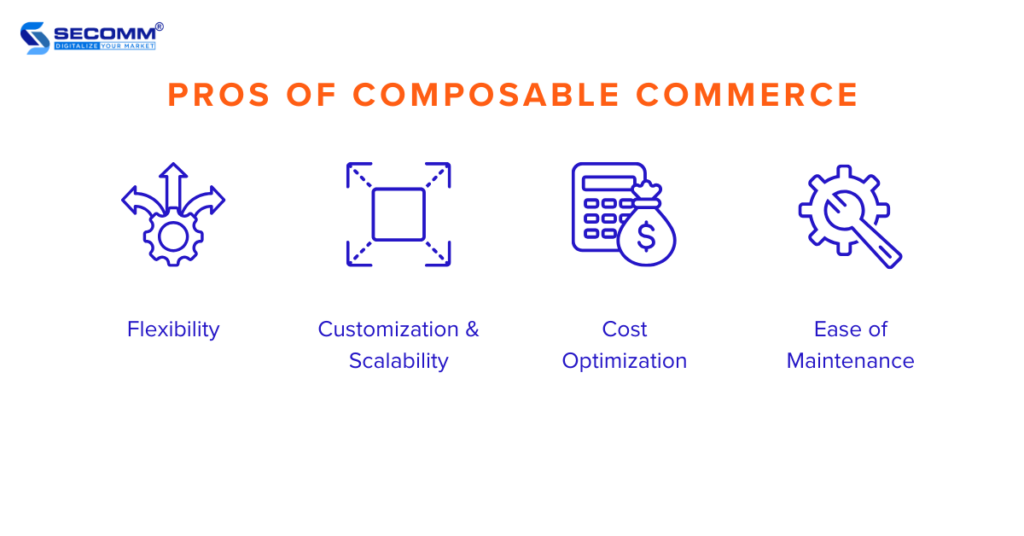
- Flexibility
This eCommerce development model offers high flexibility. You can select to combine the most suitable components for your needs. This flexibility allows you to easily create an eCommerce system that adapts to market trends and ever-changing customer experience expectations.
- Customization & Scalability
The model can meet the highest demands for customization & scalability. You can freely customize each component based on your brand and what you want for customer experience. But you can also scale individual components to handle growing traffic and transaction volumes.
This level of customization and scalability allows you to offer a distinctive shopping experience, boost competitiveness, and expand your operations without the need for a complete overhaul of the system architecture.
- Cost Optimization
Despite the initial setup costs, deploying Composable Commerce can help you save your development costs in the long run. Because you only need to pay for specific components they use and optimize your PBCs to avoid unnecessary expenses.
Most current Composable Commerce solutions offer discounts as more components are integrated, with Commerce Components by Shopify being a prominent example.
- Ease of Maintenance
Components in the Composable Commerce architecture are often separated and become independent of each other, making maintenance and updates for each component easier. This minimizes disruptions and the risk of system downtime during maintenance or upgrades.
Cons of Composable Commerce
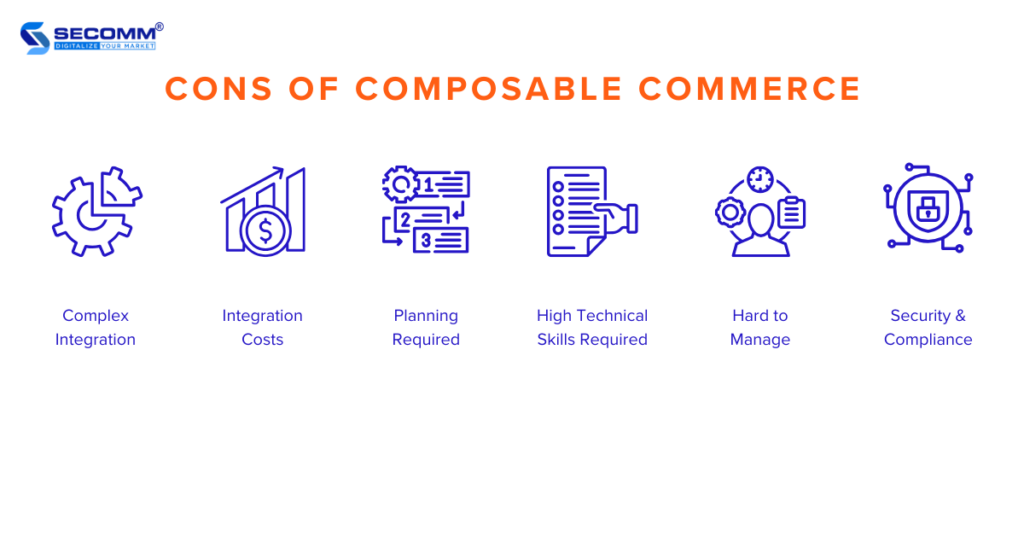
- Complex Integration
Composable Commerce demands the integration of various components, and this process can be complicated and time-consuming. You’ll need to ensure that these independent components operate seamlessly and efficiently within the same system, requiring additional development and customization efforts.
- Integration Costs
At scale, the need for deploying a complex system may increase, and integrating multiple components may lead to high upfront and ongoing costs. So, it’s important to phase resources for continuous development, testing, and maintenance of this integrated operation.
- Planning Required
Implementing a Composable Commerce architecture requires meticulous planning from the number of components, choice of suppliers, and integrated solutions to issues related to maintaining and upgrading these components.
- High Technical Skills Required
Building and maintaining an eCommerce system following the Composable Commerce model demands a high level of knowledge and technical skills in various technologies and integrated solutions. You must invest in training your in-house teams or collaborate with highly specialized entities.
- Hard to Manage
Managing a Composable Commerce system can be a significant challenge, especially when you integrate components from multiple 3rd-party suppliers. While Composable Commerce provides flexibility in integration, it also implies that you have to manage relationships with various suppliers.
When there is a need for expansion, you’ll work with these suppliers to ensure each component can scale concurrently and efficiently, avoiding any adverse impact on system development.
- Security & Compliance
Ensuring the security and following rules for many components at the same time can be tricky. Each supplier has their own security and rule needs. So, how can you follow all the rules from each supplier without messing up the way your Composable Commerce system works? – That’s the point!
What is the difference between Composable Commerce and Headless Commerce?
Both Composable and Headless Commerce architectures separate the frontend and backend, providing a higher level of flexibility and customization. These technology solutions are currently the focus of many large businesses worldwide.
So, what is the main difference between the two?
In the Headless architecture, the separation of the frontend and backend allows you to update and customize either the frontend or backend without affecting each other.
On the other hand, the modular nature of Composable architecture takes it a step further by decoupling all eCommerce components, enabling you to choose and set up perfect PBCs (Packaged Business Capabilities) for your needs.
The key feature of Composable architecture is that, while the frontend can connect to various components at the backend through APIs, these components are highly modular and independent. This means that changes to one component won’t affect other components or the frontend interface.
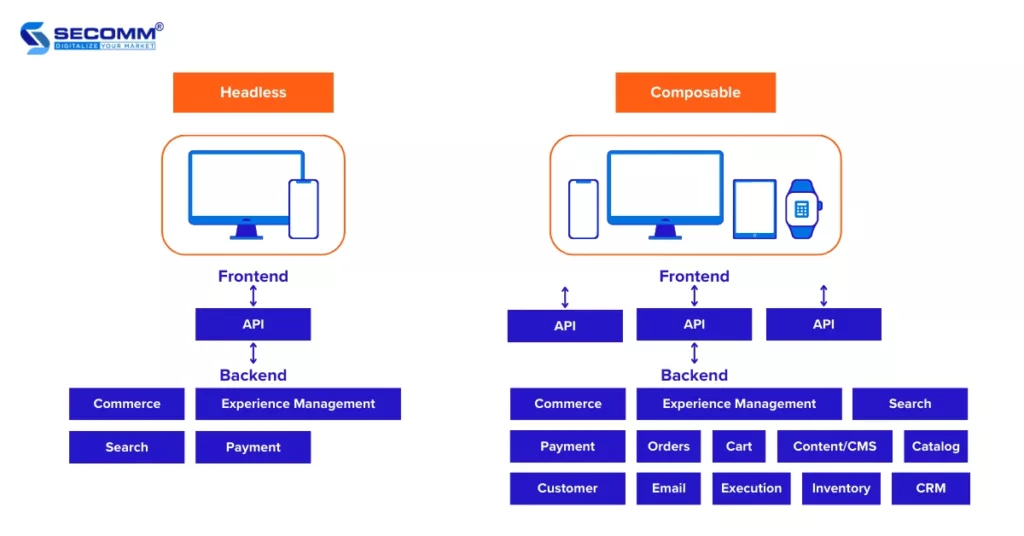
Should we deploy Headless Commerce or Composable Commerce?
When considering the prospects of eCommerce architectures, it is evident that both Composable and Headless Commerce offer superior customization and scalability, allowing you to break free from traditional constraints to adapt to market trends. However, the decision to implement a specific architecture will depend on your business needs, technical expertise, and the goals you want to achieve.
With SECOMM’s extensive expertise and deep experience in successfully deploying numerous Headless Commerce projects, we serve as a reliable partner to advise businesses looking to implement this architecture with innovative solutions.
Contact us or call directly on the hotline at 028 7108 9908 to take a leap forward with SECOMM and unlock the full potential of both Headless and Composable Commerce today!

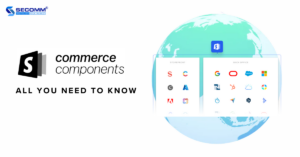
SHOPIFY COMMERCE COMPONENTS: ALL YOU NEED TO KNOW IN 2024
 28/12/2023
28/12/2023
 8,314
8,314
 2
2
 0
0
 1
1
Today, with the growing demand for flexible and scalable eCommerce system development, large-sized businesses turn their attention to solutions like Headless, Microservices, and Composable Commerce. The Composable approach will allow you to integrate independent components to tailor and enhance the eCommerce experience.
Knowing this insight, Shopify has unveiled the Commerce Components solution, offering you — as a large-sized business — the most straightforward approach to deploying Composable Commerce.
Learn more: What is Composable Commerce?
What are Commerce Components?
Commerce Components is an innovative tech stack designed for large businesses. Rather than introducing new features, the company has transformed its infrastructure into modular components that can be combined to build and customize adaptable eCommerce websites. This means you can select components based on your deployment needs and seamlessly integrate them into your existing tech stack using flexible and unlimited API connections, ensuring a smooth customer experience across all devices.
“We’ve always approached innovation by anticipating what retailers need and then providing those solutions,” said Harley Finkelstein, president of Shopify. “Commerce Components opens our infrastructure so enterprise retailers don’t have to waste time, engineering power and money building critical foundations it has already perfected, and instead frees them up to customize, differentiate and scale”
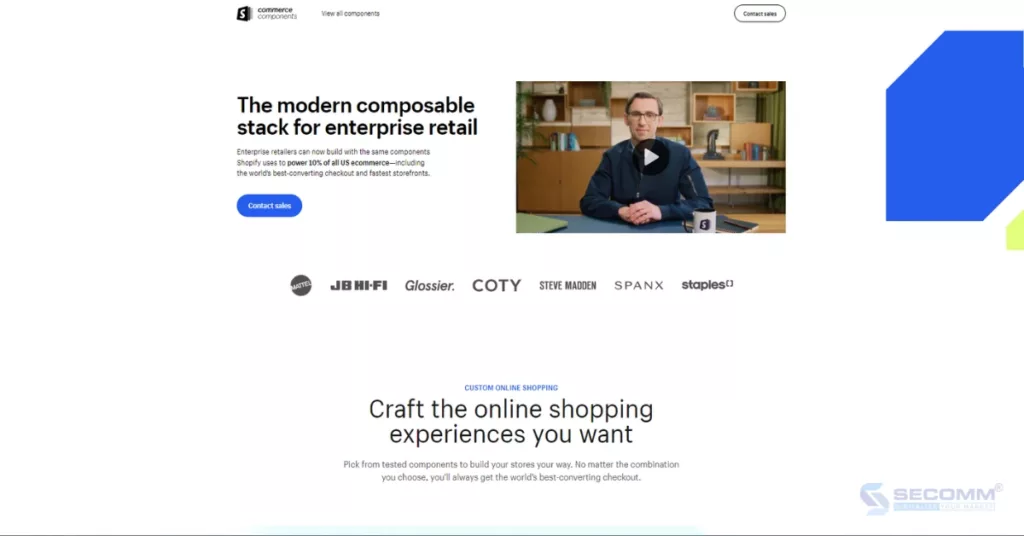
Commerce Components by Category
The solution offers six main categories including over 30 components, allowing you to build a tailored solution that aligns with your needs.
- Storefront: Build custom storefronts using any framework, API, and hosting.
- Cart & Checkout: Optimize the shopping cart and checkout process using APIs and additional utilities.
- Core Commerce: Create products with various data models through APIs.
- Data & Compliance: Provide solutions for leveraging customer insights to boost sales while managing and securing customer privacy data.
- Shipping & Logistics: Offer OMS and IMS solutions to streamline logistics processes.
- Omnichannel: Manage and sell across multiple channels, from POS and eCommerce platforms to social media and chat applications.
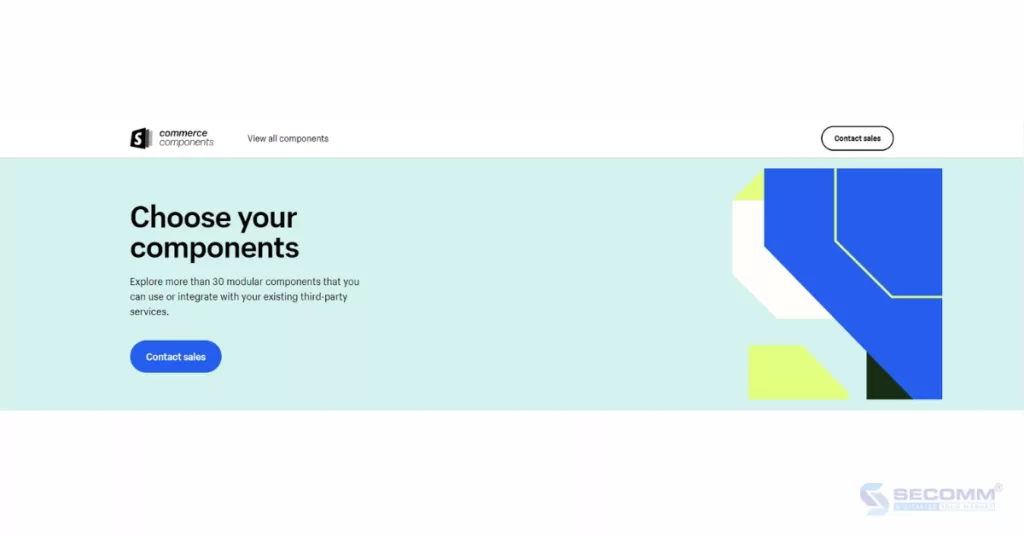
What is the difference between Commerce Components and Shopify Plus?
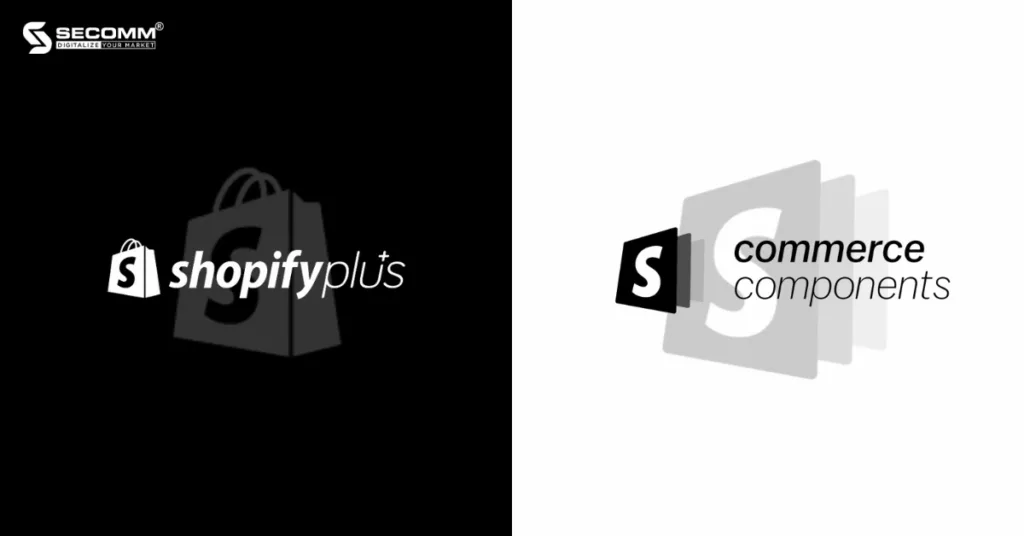
Although both ‘Plus’ and Components are enterprise eCommerce solutions, they differ in several aspects:
- Operations: ‘Plus’ is an all-in-one eCommerce platform, providing numerous advanced features and seamless integrations with third parties. On the other hand, the new tech stack is a collection of components for you to integrate into your existing technology stack, aiming to create and deliver a customized and seamless experience for customers.
- License fee: While ‘Plus’ charges a platform fee starting at $2000 per month, along with transaction and credit card fees, Components charges based on the level of usage of the components, with fees decreasing as more components are utilized.
- Features: ‘Plus’ offers many features and regularly provides updates and feature enhancements, with the latest being Shopify Edition ’23. In contrast, Components, as a new tech stack, provides unlimited API connections, increased product attribute limits, integration with new third-party technology solutions, and enhanced transaction processing capability of up to 40,000 payments per minute per store.
- Customer support: ‘Plus’ businesses can seek guidance and support during deployment through the Merchant Success Program. Components, on the other hand, provides businesses with access to Shopify Professional Services.
Benefits of using Commerce Components
- Flexible Modular Architecture
If you don’t prefer to deploy pre-packaged eCommerce platforms. Composable architecture is the ideal choice. It allows you to select and purchase components based on your needs, integrate them into your existing systems, and customize them.
With its modular architecture, the tech stack provides unlimited API connections, meaning there is no limit to the number of components and add-ons that you can use to build your tech stack.
Moreover, since components are entirely independent, you can add, remove, and modify components without affecting the entire system.
- Cost Optimization
Commerce Components employs a pricing model structured around the level and quantity of components used. This means you only pay for the components you require. Furthermore, as you acquire and utilize more components, you’ll benefit from increasingly significant discounts.
Additionally, the annual payment structure of Components helps you facilitate precise cost predictions.
Brands using Commerce Components
Since its inception, the platform has proudly highlighted the trust and adoption of its solution by major global businesses. Notable among these are Glossier, JB Hi-Fi, Coty, Steve Madden, Spanx, and Staples.
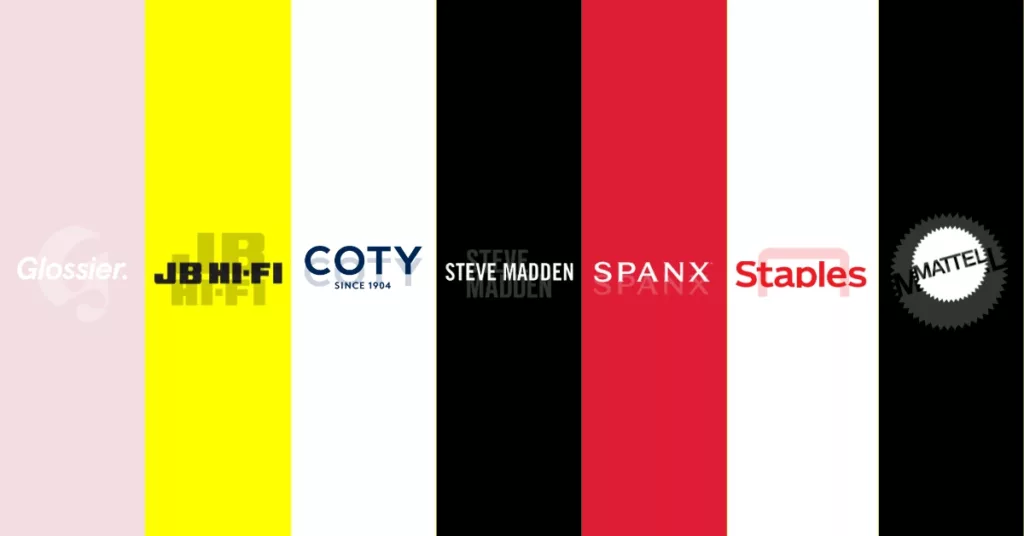
Leading U.S. toy brand Mattel is one of the first enterprises to successfully implement this technology solution. Sven Gerjets, Mattel’s CTO, said in a statement.
“We first worked with Shopify on a project called Mattel Creations, a platform for creators to reimagine the most iconic toys in the world. Creations empowered Mattel to move quickly, meet our customers where they are, and most importantly leverage its infrastructure to scale globally. It was hugely successful, and we’re excited to transform our brand offerings using Commerce Components.”
The trust placed by Mattel and other industry leaders forms a solid basis for expecting the ongoing success of this new solution, extending its impact not only within the U.S. market but also on a global scale.
Final Thoughts
In the past, large businesses often favored open-source platforms like Magento or Salesforce due to their customizable and flexible expansion capabilities. However, in today’s landscape, SaaS platforms, particularly Shopify, offer innovative solutions for developing Composable or Headless Commerce.
In 2021, the company launched the Hydrogen + Oxygen solution to enhance Headless Commerce development. Continuing this trend into early 2023, they once again surprise the industry with Commerce Components, designed for deploying Composable Commerce.
This move highlights its commitment to anticipating and responding to customer needs, earning the trust of large enterprises in the face of competitive rivals.
Reach out or call the SECOMM hotline at 028 7108 9908 for a more in-depth understanding of Commerce Components by Shopify and to explore the implementation of Headless Commerce or Composable Commerce.

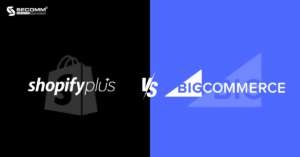
SHOPIFY PLUS VS BIGCOMMERCE ENTERPRISE: FULL COMPARISON 2024
 28/12/2023
28/12/2023
 4,582
4,582
 2
2
 0
0
 1
1
In today’s eCommerce landscape, it isn’t just open-source platforms that can meet the complex development and customization needs of large-scale enterprises, but SaaS platforms are also steadily rising with significant improvements. Among them, two SaaS platforms designed specifically for large enterprises are Shopify Plus and BigCommerce Enterprise.
However, these two platforms have many key differences. This article aims to clarify the pros and cons of each platform and compare the differences between the two platforms to help you — as a business leader — make well-informed decisions.
Learn more: Shopify vs BigCommerce: Which platform is right for you?
Shopify Plus vs BigCommerce Enterprise: Pros and Cons
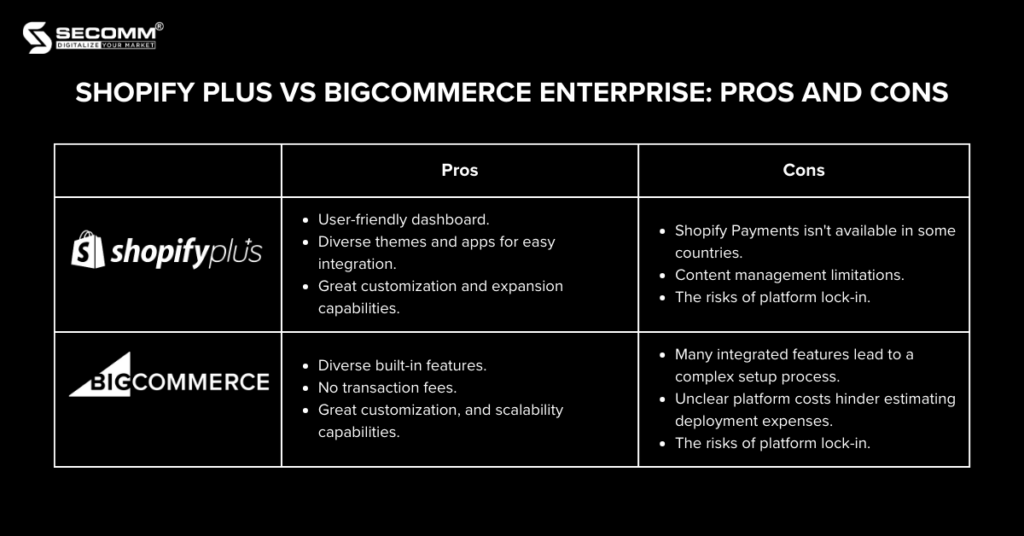
Shopify Plus vs BigCommerce Enterprise: Quick Comparison
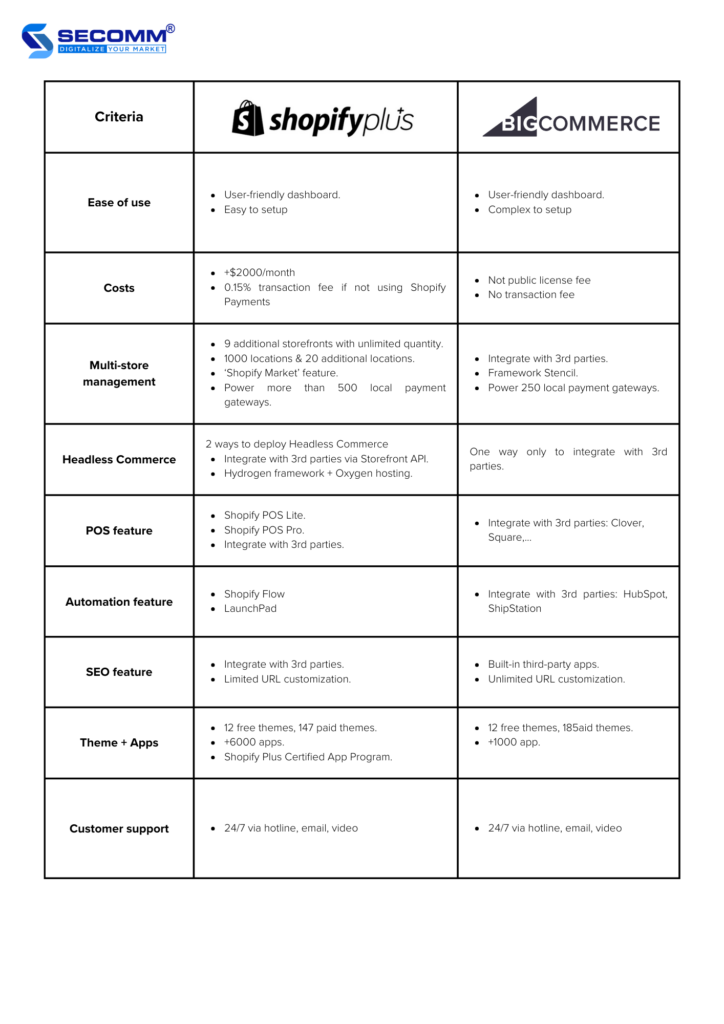
Shopify Plus vs BigCommerce Enterprise: Detailed Comparison
Ease of Use
Both platforms are recognized for their user-friendliness compared to open-source platforms. Their intuitive dashboard and user-friendly navigation, along with features like drag-and-drop editing, extensive documentation, and 24/7 support, make them accessible for users of varying technical expertise.
However, Shopify, known for its inherent user-friendly design, ensures that users, whether using the Plus version or the regular ones, can easily explore and set up their eCommerce website with efficiency.
Both these two premium solution platforms — which are Shopify Plus and BigCommerce Enterprise — cater to the deployment needs of large enterprises, these platforms offer advanced features and technologies that require some learning.
For example, the ‘Plus’ users need to grasp the Liquid template language, while those opting for the ‘Enterprise’ may benefit from understanding the Google Cloud Platform for optimizing website performance.
BigCommerce, renowned for its built-in features, continues this trend with the ‘Enterprise’ version. Some features may suit specific businesses but might be unnecessary for others. While BigCommerce allows flexibility for customizing and configuring these advanced features, it can introduce complexity and intricacy into the setup process.
Pricing
Similarly to other premium solutions on SaaS platforms, the license fee will depend on the deployment requirements and the current scale of the business. BigCommerce doesn’t disclose the fee publicly, requiring businesses to directly contact the platform for tailored consultation and pricing.
On the other hand, Shopify Plus has a license fee starting at $2000 per month. Once you reach a monthly revenue threshold of $800,000, the platform fee becomes revenue-based, amounting to 0.25% of monthly revenue, capped at $40,000 per month or $480,000 per year.
Considering transaction fees is also important. While BigCommerce doesn’t charge transaction fees, Shopify Plus charges a 0.15% transaction fee for not using Shopify Payments.
To estimate deployment costs effectively, you should partner with development agencies and engage in detailed consultations with BigCommerce or Shopify for comprehensive guidance.
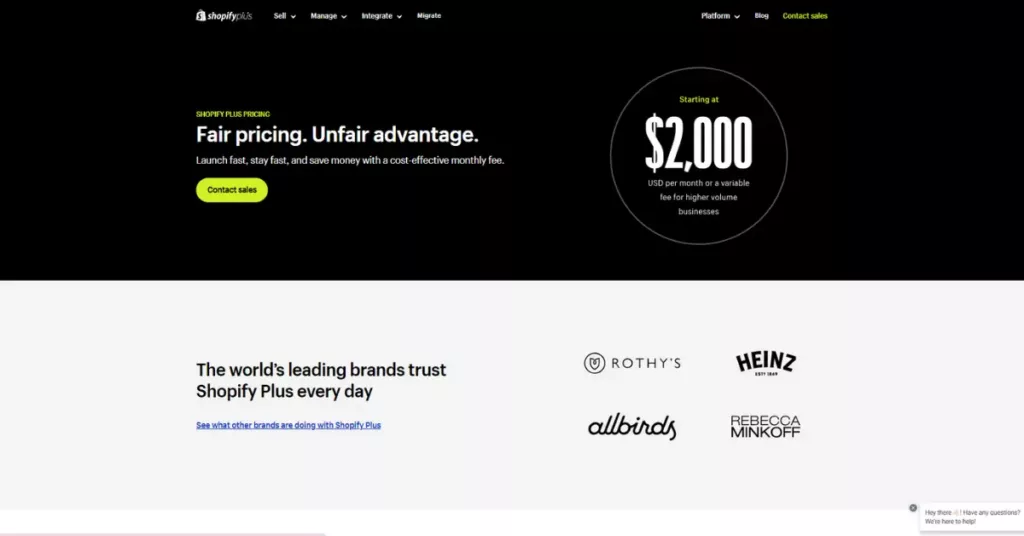
Features
- Multi-store management
For large enterprises, the multi-store management feature is crucial and a primary consideration when selecting an eCommerce platform to sell globally. To engage in sales across various markets worldwide, your eCommerce website needs to be crafted to suit the preferences of each target audience in different markets.
This involves addressing issues related to language conversion, currency units, and payment methods with flexibility. Moreover, stores should be administered efficiently in a centralized manner rather than separately.
Shopify Plus allows you to create up to 9 additional storefronts alongside the main storefront at 1000 different inventory locations and 20 additional inventory locations. All these storefronts can be centrally managed through a single dashboard.
Plus, the Shopify Market feature will help you select the markets you want to sell in. The system will then automatically convert and manage multiple languages, currency units, shipping options, and payment methods based on the user’s IP address. Currently, Shopify Plus supports a range of local payment gateways, and you can refer to the provided list.

BigCommerce Enterprise doesn’t provide many solutions or features for global selling. Instead, it allows you to deploy multiple stores within the platform and then integrate with 3rd-party PIM solutions to manage data across these stores.
Another option is to leverage the BigCommerce Stencil framework to tailor content language for each local market. Also, the Enterprise version supports multi-currency payments through more than 250 local payment gateways.
- Headless Commerce
The demand for adopting Headless eCommerce is on the rise, especially among large enterprises seeking to deliver a seamless and optimized experience for their customers. Both Shopify Plus and BigCommerce Enterprise offer effective solutions for going Headless.
BigCommerce Enterprise allows you to integrate with various frameworks (Next.js, Gatsby.js, Nuxt.js), APIs (REST, GraphQL), and your preferred or previously used tools.
When using Shopify Plus, there are three approaches. You can use the Storefront API to connect and develop with your preferred frameworks, hosting solutions, and tools. Or, you can leverage Shopify Hydrogen framework and Oxygen hosting to facilitate a headless eCommerce website flexibly.
- POS (Point of Sale)
Just like their regular pricing plans, both the ‘Enterprise’ and the ‘Plus’ include Point of Sale (POS) features for eCommerce transactions, catering to both online and offline stores, as well as Omnichannel operations.
POS can be configured on various devices like mobile devices (tablets, smartphones), and other hardware like cash registers and barcode scanners.
BigCommerce Enterprise offers smooth integration with third-party POS systems like Square, Vend, Clover, and Heartland Retail. It’s good for those who already using POS software from these third-party providers.
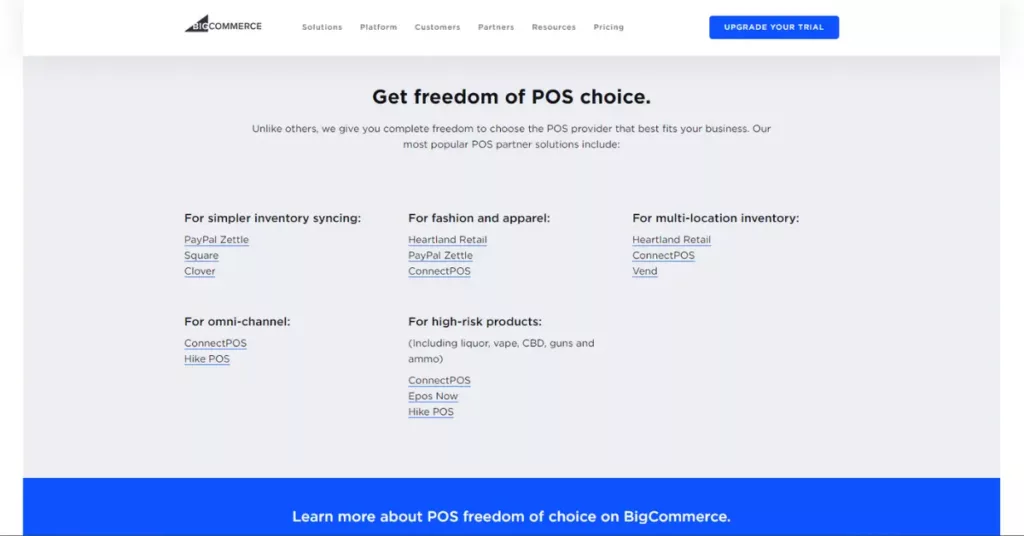
For Shopify Plus, beyond the option to integrate with third-party POS systems like BigCommerce Enterprise (Clover, Square, Zend), Shopify offers its own Shopify POS solution, available in two plans:
- ‘POS Lite’ plan, providing basic integration
- ‘POS Pro’ plan, priced at +$86/month for the first 20 locations for Shopify Plus businesses.
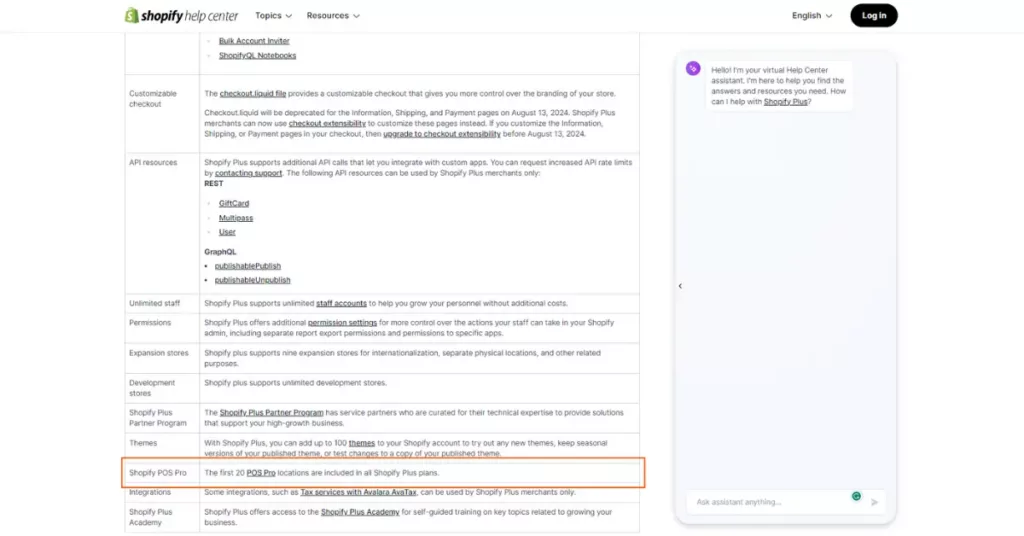
- Automation
Both ‘Plus’ and ‘Enterprise’ offer tools and solutions to help you automate your eCommerce website operations.
Shopify Plus offers an exclusive solution, Shopify Flow, and LaunchPad, allowing you to automate routine tasks and set up automated workflows for tasks like email marketing campaigns or new product launches.
On the other hand, BigCommerce Enterprise takes a different automation approach which enables you to smoothly integrate with 3rd-party apps. Some of them are HubSpot, Avalara, ShipStation, etc.
- SEO
SEO plays a crucial role in improving the search visibility of an eCommerce site and attracting potential customers. Both platforms offer features to enhance SEO efforts.
The ‘Plus’ stands out for its user-friendly interface and an integrated app ecosystem that can enhance SEO, incorporating tools such as Google Search Console and Analytics. However, it comes with limitations in URL control and customization.
The ‘Enterprise’, on the other hand, provides more versatile SEO capabilities, including complete control over URLs and integration with applications like Google Search Console and Analytics. It makes the process more intricate compared to Shopify Plus, involving additional setup operations.
Themes & Add-ons
- Themes
Shopify Plus offers businesses approximately 12 free themes and 147 paid themes, with prices ranging from $150 to $380 per theme. On the other hand, BigCommerce Enterprise provides around 12 free themes and 185 paid themes, with prices ranging from $150 to $400 per theme.
Both platforms offer a wide range of visually appealing and mobile-friendly theme options. While the ‘Enterprise’ themes are characterized by elegant, tidy, and modern designs with highly customizable features, the ‘Plus’ themes can meet higher requirements for user experience, making navigation easier.
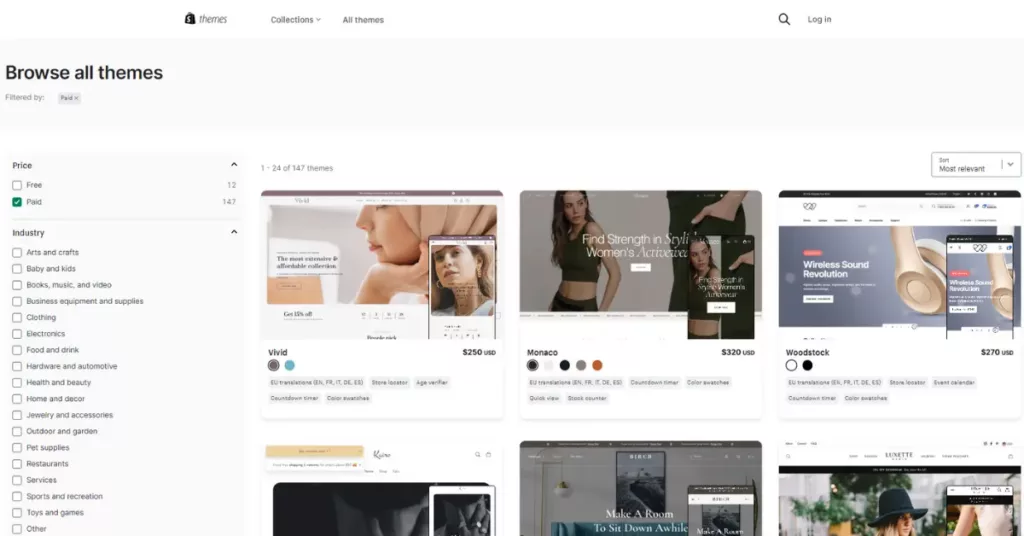
- Add-ons
To facilitate efficient eCommerce deployment, the two provide vast app stores and extensions, tailored for ‘Plus’ and ‘Enterprise’ businesses. While both platforms offer free versions, access to comprehensive features requires a modest monthly fee.
Shopify Plus boasts over 6,000 apps and extensions, while BigCommerce Enterprise has around 1,000. This can be explained by Shopify’s widespread popularity among businesses and developers globally, providing them with ample documentation and resources for app and extension development, including the Shopify Plus Certified App Program.
Customer Support
For businesses that are ready to deploy the ‘Plus’ or the ‘Enterprise’ solutions, the demand for technical support and efficient eCommerce website operations is significant.
Both platforms receive high praise for their customer service. They offer 24/7 support via hotline, email, and video available in multiple languages. However, if you need specialized and complex technical support, Shopify Plus may be the preferable choice.
Final Thoughts
In the competitive business landscape, selecting the right platform for launching an eCommerce website is an important decision. Both Shopify Plus and BigCommerce Enterprise offer distinct advantages and cater to various business models.
Regardless of the platform chosen, you should prioritize the development and delivery of an exceptional shopping experience for your customers. eCommerce platforms serve as tools, and the ultimate key to success lies in an effective deployment strategy and great collaboration with a proficient team.
With extensive experience helping numerous businesses deploy diverse eCommerce development projects on both Shopify Plus and BigCommerce Enterprise, SECOMM boasts a team of seasoned experts capable of collaborating to create exceptional eCommerce experiences and help you enhance your brand positioning.
Reach out or directly call the hotline at 028 7108 9908 to explore how SECOMM can contribute to optimizing the potential of Shopify Plus and BigCommerce Enterprise for enduring your business success.

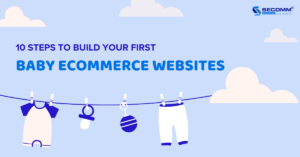
10 STEPS TO BUILD YOUR FIRST ECOMMERCE WEBSITES
 28/12/2023
28/12/2023
 4,344
4,344
 2
2
 0
0
 1
1
Baby eCommerce is a promising market experiencing a steady annual growth rate (CAGR 2023-2027) of 9.86%, projected to reach a market value of approximately USD 129.40 billion by 2027.
To tap into this market, you’ll need to develop a professional and efficient eCommerce website. Here are 10 steps to create an eCommerce website tailored for maternity and baby products.
Identify objectives
The first step is to identify your business goals and prioritize them, forming a plan tailored to develop an effective Baby eCommerce website.
Concerning long-term goals, you may focus on objectives like establishing a strong brand presence, reaching potential customers, and enhancing the efficiency of both online and offline operations.
For short-term goals, businesses can give priority to activities like monitoring, analyzing customer behavior, assessing the effectiveness of marketing campaigns, and boosting revenue.
When it comes to timeline, you can decide to deploy quickly to enter the market or proceed gradually to test and adapt to this eCommerce world.
As for the budget, it depends on your business strategy and financial capacity for this Baby eCommerce development project.
Select eCommerce platform
Currently, there are two types of eCommerce platforms to help you build your first Baby website: SaaS (Software as a Service) and Open-Source platform.
Some popular SaaS eCommerce platforms include Shopify, BigCommerce, Squarespace, and Wix.
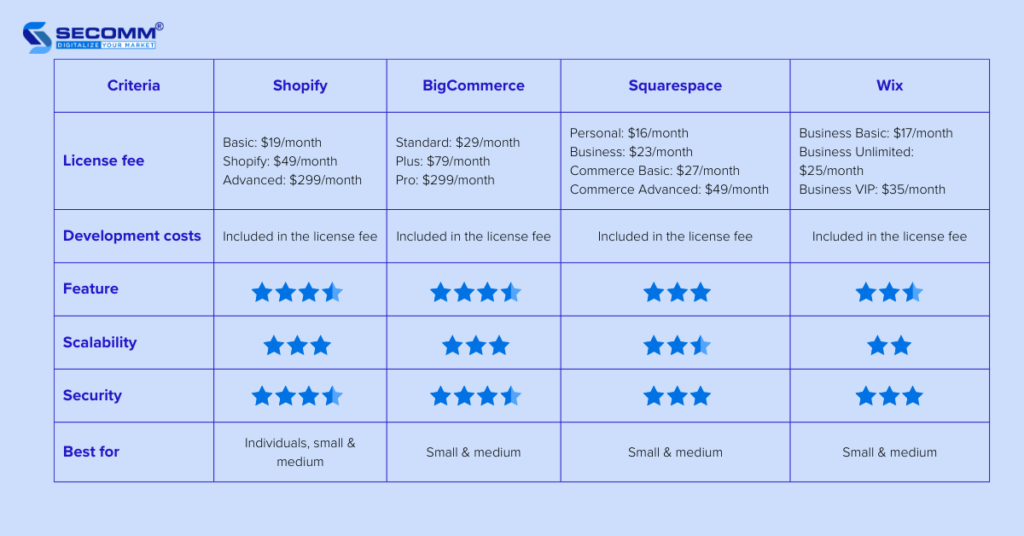
In addition, there are premium versions of these SaaS platforms such as Shopify Plus, BigCommerce Enterprise, and Goflow.
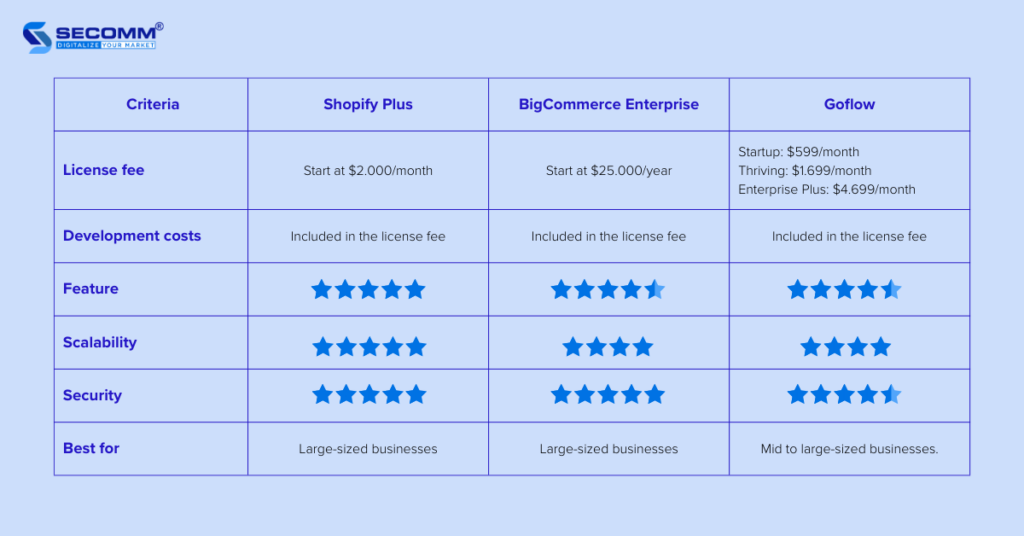
Some open-source platforms are widely used: Adobe Commerce (Magento), WooCommerce, OpenCart, and PrestaShop.
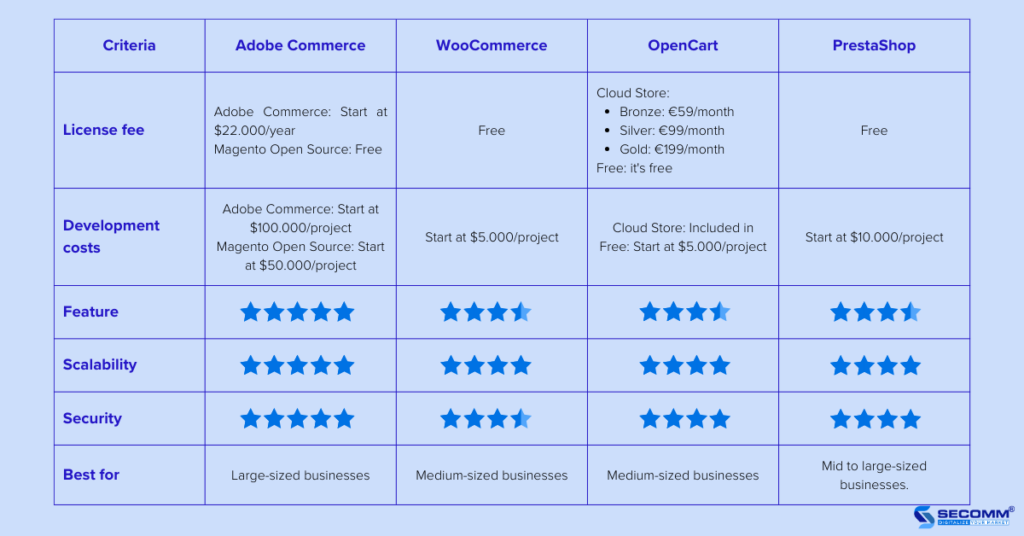
Typically, some new businesses choose basic SaaS platforms to save time and budget in the initial phase of the Baby eCommerce website development. After a while, they may switch to a premium SaaS or an open-source platform to develop their baby websites more advanced.
In another case, some businesses opt for open-source platforms to build a basic eCommerce website and then gradually upgrade the system over time to minimize the need for platform switching in later phases.
In-house team or development agency?
Typically, most eCommerce businesses decide to initially partner with a professional development agency and gradually build their in-house team.
For establishing an in-house team, you’ll need to recruit and train IT and eCommerce professionals for expertise on the chosen platform. It’ll take you significant time and budget but allow you to have full control over your resources. You can develop and adjust your Baby eCommerce website according to your needs and wants.
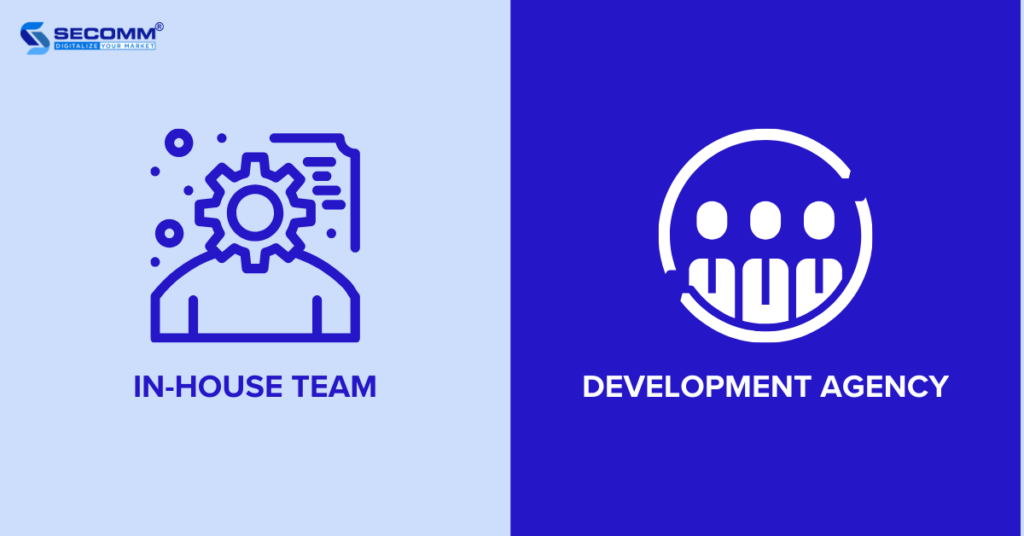
When it comes to partnering with an agency, here are some criteria you need to evaluate:
- eCommerce experience
- High-performing development team
- Clear processes
- Deadline meet
Partnering with a professional development agency gains you specialized eCommerce knowledge, enhances your technical skills, and above all, you’ll facilitate the eCommerce website exactly what you need, tailoring it to the unique features of the maternity and baby industry.
Design UI/UX
When it comes to UI/UX design, it’s important to showcase the brand image, products, user guide, etc. There are three popular ways to make your design:
- Using ready-made themes: Optimizing interface design costs may limit the brand positioning as ready-made themes can be similar to other websites.
- Customizing themes: Balancing cost savings and adding some brand identity elements such as color, font, layout, etc. However, you’ll need a specialized team to customize themes effectively.
- Designing unique themes: The design will tailored to your brand, but it’ll take your time and budget.
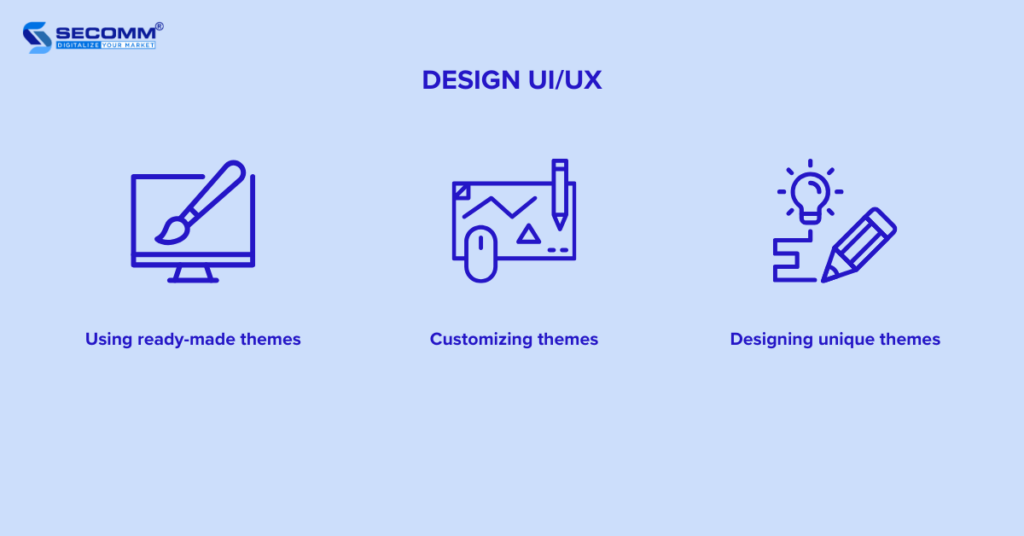
Develop core features
Some essential features that a Baby eCommerce website should have include
- Catalog Management: Control product data, features, categories, prices, inventory quantities, and images/videos for smooth operations and optimal business performance.
- Store Management: Handle product inventory, control the business activities, and manage personnel for each branch.
- Cart & Checkout: Manage the shopping cart and customer checkout information.
- Customer Management: Manage customer information to improve marketing effectiveness, shopping experience, and overall customer satisfaction.
- Marketing Management: Optimize SEO and implement marketing programs using supporting tools to boost sales for the business.
- Sales Management: Establish and operate sales processes, orders, payments, and shipping.
- Content Management: Develop and optimize all content-related aspects for CMS pages, image storage, theme customization, and website design.
- System Management: Administer user roles, and explore best practices in terms of security, maintenance, and system care for the website.
- Analysis & Reporting: Support track, and measure the performance of the eCommerce system and plan for future strategies.
Some advanced features for the baby eCommerce industry:
- Fast delivery: Provides quick delivery services within 2 hours in major cities.
- Personalized Gift Packaging: Gift packages can be designed based on the preferences and needs of each recipient, such as packages for newborns, packages for children, and packages for mothers.
- Buy Now Pay Later: Shop for essential products/services for children without having to pay the full amount immediately, supporting those who may not have the ability to pay a large sum at once.
- Loyalty Program: Allow customers to earn points for each purchase. These points can be used to redeem benefits such as discounts, gifts, or free services.
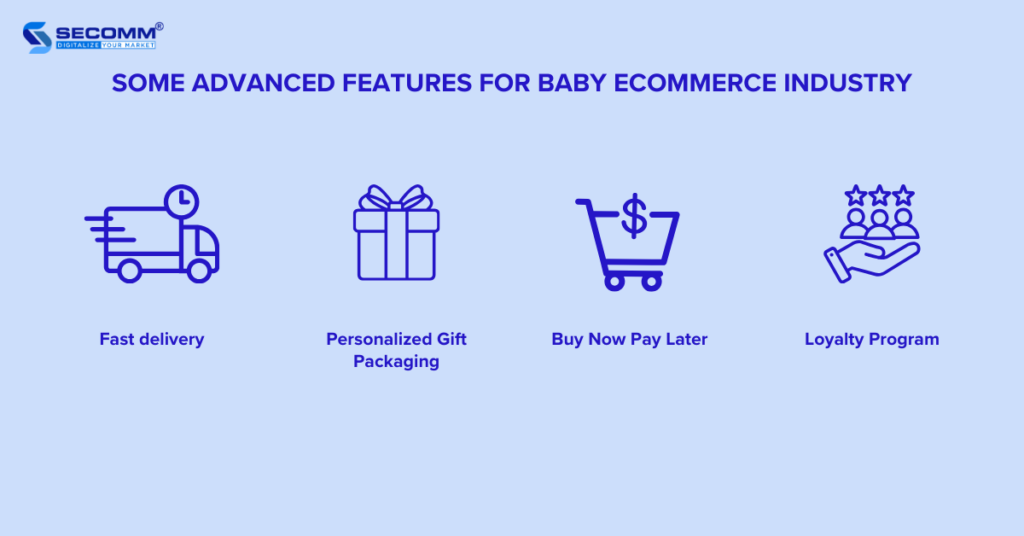
Fulfill Legal Procedures
After developing features and ensuring a successful testing and website launch, you’ll need to complete the legal procedures associated with eCommerce operations.
According to Decree 52/2013/ND-CP by the Government of Vietnam, any individual or organization owning an eCommerce website for sales is required to notify or register with the Ministry of Industry and Trade through the online public service portal of the Ministry of Industry and Trade.
Note: Websites that operate beyond the specified period or fail to register/notify the authorized management agency within the designated timeframe may be subject to administrative penalties as per regulations.
QC/Testing
When QC/testing your eCommerce website, you can leverage either the Waterfall or Agile model to test the entire system.
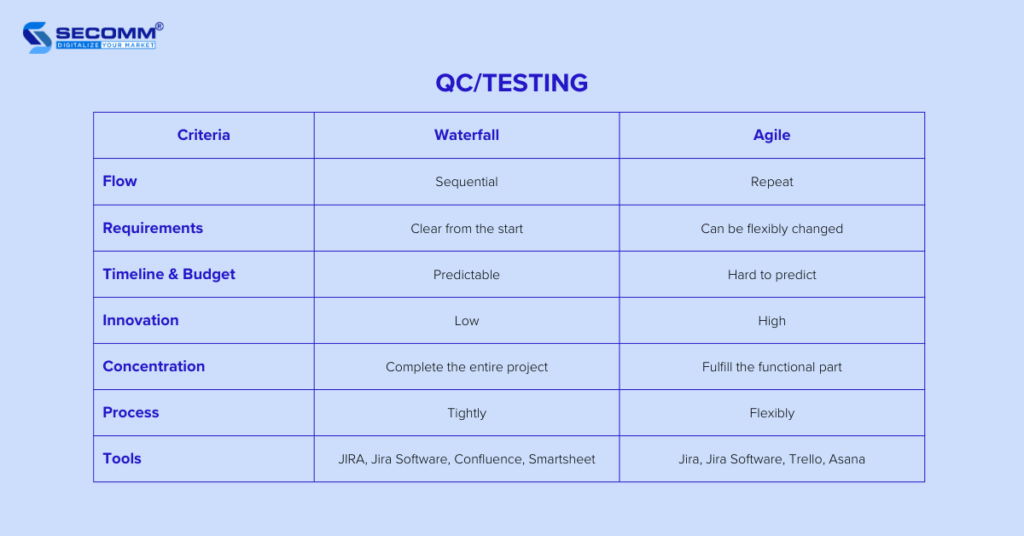
Using these models helps you review and test your entire eCommerce system, functions, and features within a specified timeframe, ensuring optimal order processing speed and overall website stability. In case of any issues, your in-house team or development partner will help you to address them before officially going live.
Go-live
When the QC/testing process is done, your baby eCommerce website is ready to launch. To ensure a smooth go-live process, here are three steps you should prepare:
- Define the go-live objectives: The aims could be system stability, data backup and recovery capabilities, and customer shopping experience.
- Perform testing and error resolution: Conduct comprehensive system testing to identify and rectify functional errors, security issues, and performance issues.
- Create backup plans: Despite conducting testing and resolving errors, unforeseen issues may still arise during the go-live process. To address these issues, backup plans are a must.
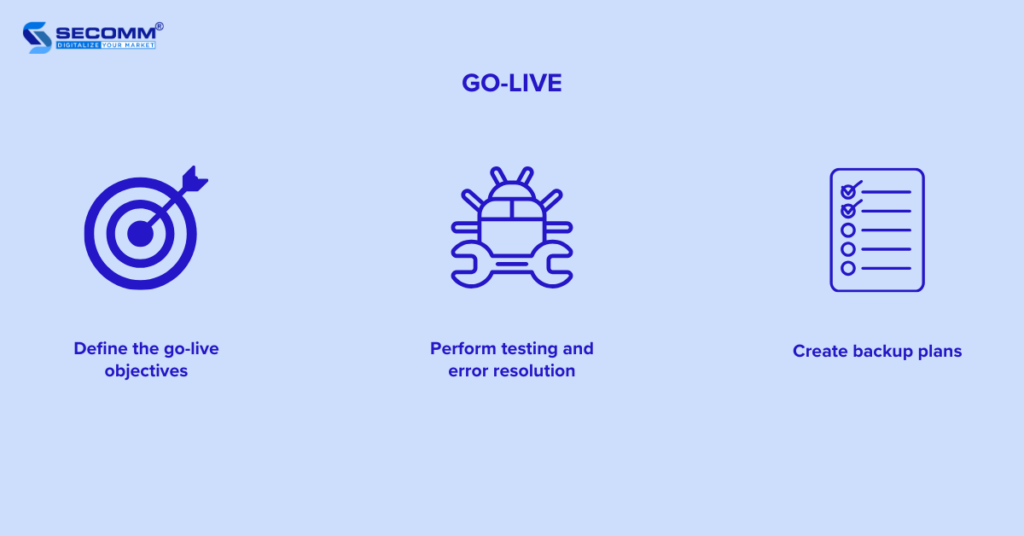
Operate the eCommerce system
Running a baby website is an ongoing effort aimed at ensuring the steady and effective functioning of the system. This involves various activities, including:
- Resource management: Managing the system’s resources, including hardware, software, data, and personnel.
- Process management: Managing all processes within the system, including development, deployment, operation, and maintenance processes.
- Error management: Identifying the causes of errors, quickly and effectively resolving issues, and implementing preventive measures to avoid recurrence.
- Modification management: Assessing the impact of changes on the system and executing modifications safely and efficiently.
Furthermore, you should regularly maintain, update, and upgrade the website system to achieve sustainable growth, adapting quickly to shifts in the eCommerce world or the maternity and baby products market.
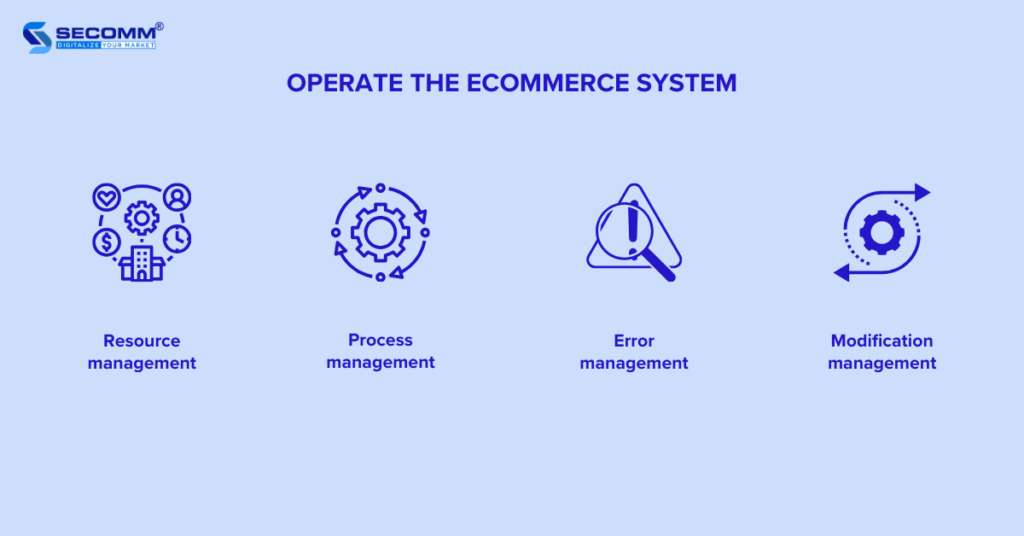
Boost eCommerce growth
After a period of operation, you should shift your focus toward eCommerce marketing strategies or Omnichannel to expand your online presence in the market of maternity and baby products
businesses should redirect their focus toward implementing eCommerce marketing strategies or embracing Omnichannel approaches to expand their online presence in the market of mother and baby products.
Implementing Omnichannel involves setting up a seamless sales, marketing, and management system across channels such as the website, social media platforms (Facebook, Instagram, Zalo, TikTok Shop), and online marketplaces (Shopee, Tiki, Lazada, Sendo) to optimize the customer experience and boost business efficiency.
Developing a comprehensive marketing strategy, centered around key eCommerce marketing channels like Content Marketing, SEO/SEM, Email Marketing, and Affiliate Marketing, becomes crucial for achieving rapid sales growth.
The Bottom Line
In general, the journey of building a baby eCommerce website for the Vietnamese market isn’t an easy task. It requires you to invest a significant amount of time and budget in researching the most fitting strategies tailored to each phase of your eCommerce development.
Understanding the difficulties and challenges that businesses may encounter when building a baby eCommerce website, SECOMM is ready to provide free consultation on detailed eCommerce solutions.
Reach out or call the SECOMM hotline at 028 7108 9908 to get started!

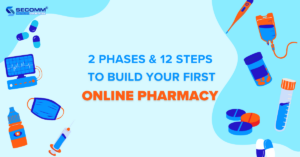
2 PHASES & 12 STEPS TO BUILD YOUR FIRST ONLINE PHARMACY
 25/12/2023
25/12/2023
 5,041
5,041
 2
2
 0
0
 1
1
Since the advent of the COVID-19 pandemic, the pharmaceutical industry has proven the potential of transitioning from offline to online pharmacy. In the United States, the number of remote health consultations surged by 2,600% in March 2020 (during the peak of COVID-19 in the U.S.) compared to the same month in 2019. According to Statista, the global pharmaceutical eCommerce sector is projected to reach 32 billion USD by the end of 2023.
Several brands have successfully embraced eCommerce early on, achieving unexpected successes. Examples include Apollo Pharmacy (India), FPT Long Châu (Vietnam), CVS Health (USA), and Droga Raia (Brazil). The common thread among these brands lies in their comprehensive eCommerce platforms, catering to the shopping needs of customers for healthcare, pharmaceutical, and medical products.
With nearly 10 years of experience in the eCommerce sector, SECOMM has outlined the journey of building pharmaceutical eCommerce websites for the Vietnamese market.
Phase 1: Building a basic online pharmacy
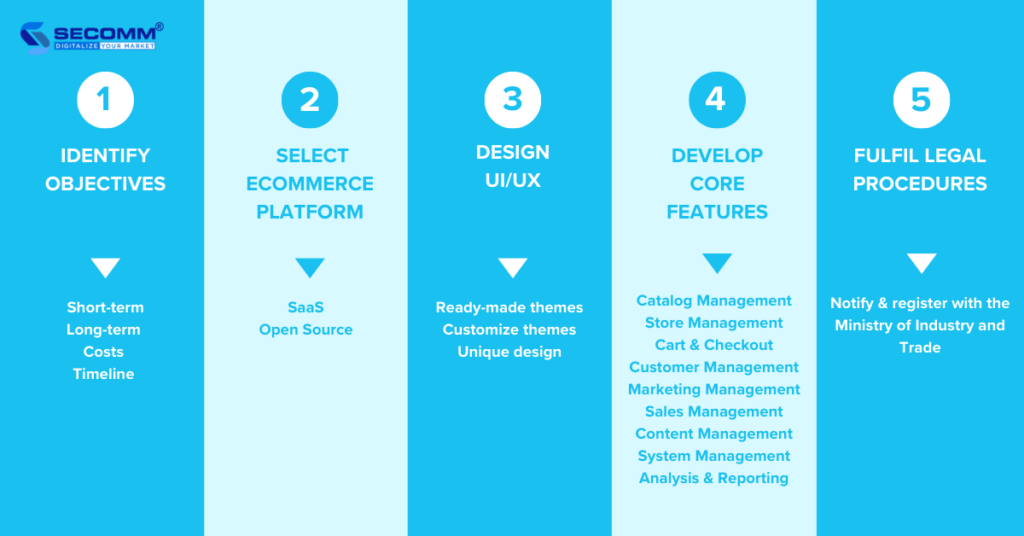
Identify objectives
The first thing to do is identify and prioritize goals to plan the pharmacy eCommerce website development for each phase.
In the long run, businesses can consider goals like branding, generating potential customers, and optimizing online and offline operations.
For short-term goals, businesses should prioritize objectives like monitoring and analyzing customer behavior, evaluating marketing campaigns, and revenue growth.
In the first phase, businesses can decide to deploy quickly to enter the market or proceed gradually to test and adapt to this eCommerce world.
Select eCommerce platform
There are two types of platforms to help businesses facilitate pharmacy eCommerce websites: SaaS (Software as a Service) and open source.
Some popular SaaS eCommerce platforms include
- Haravan: Founded in 2014 based on Shopify, Haravan has become popular in the Vietnamese eCommerce community for B2C businesses or those dealing with low-involvement products. It offers quick deployment with reasonable fees.
- Shopify: It is a widely used eCommerce platform allowing businesses to build, develop, and manage their online stores. Shopify offers an intuitive interface, making it easy for users with limited technical skills to operate eCommerce efficiently.
- BigCommerce: Designed to be easy to use, BigCommerce empowers businesses of all sizes and technical skills to start their journey to build a professional eCommerce website.
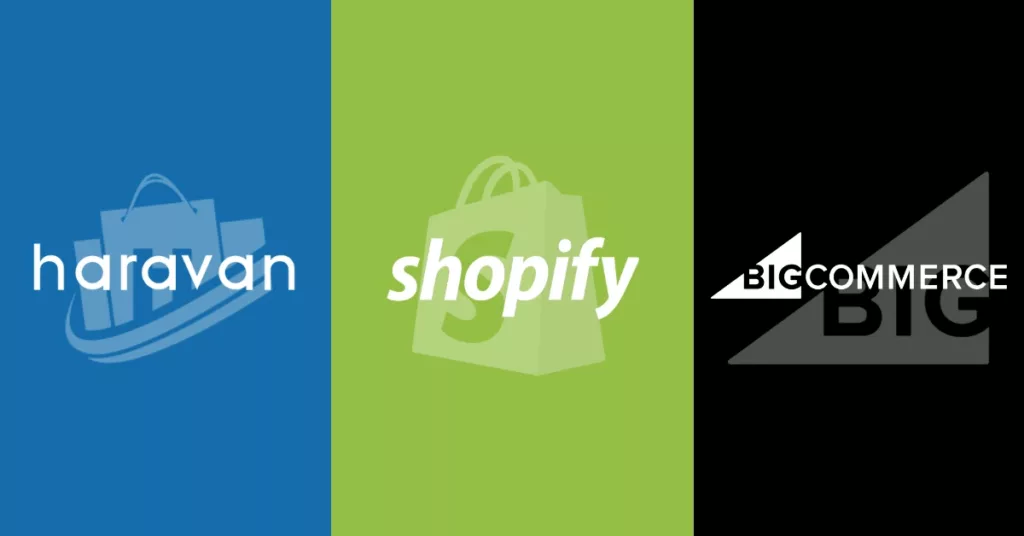
Some outstanding open-source eCommerce platforms include
- Adobe Commerce (Magento): Adobe Commerce is an open-source eCommerce platform designed specifically for businesses ranging from medium to large scale, with high growth and extensive customization and expansion needs. It includes two main versions: Magento Open Source (free) and Adobe Commerce (paid).
- WooCommerce: WooCommerce is a free WordPress plugin that allows brands to set up eCommerce websites by adding eCommerce functionality to an existing WordPress website.
- OpenCart: OpenCart is an open-source eCommerce platform based on the PHP programming language, developed by Daniel Kerr in 1998, with two versions: Free (Open Source) and Cloud Store (Paid).
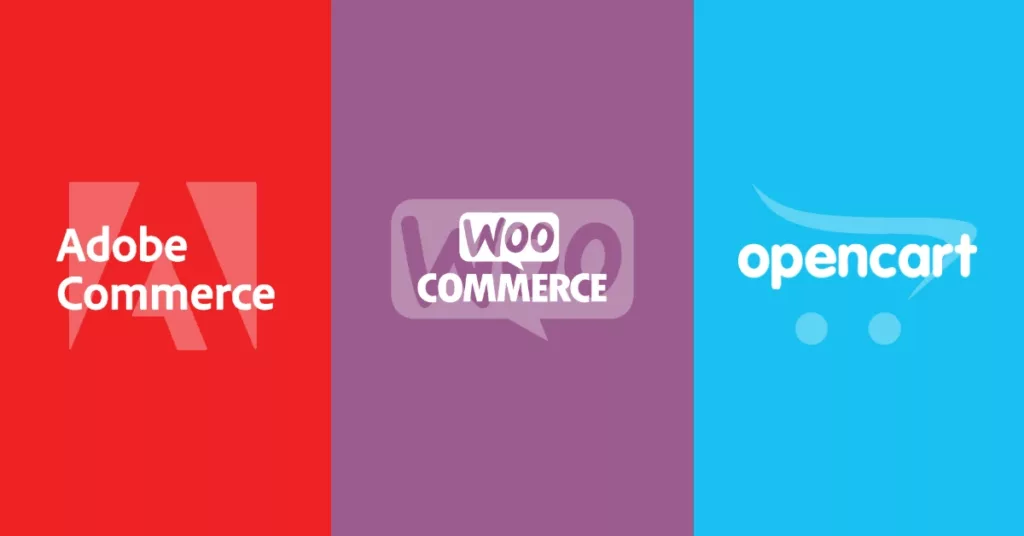
Typically, new eCommerce businesses will choose SaaS platforms to save time and budget in the initial phase of building a basic eCommerce website or an online pharmacy. Then, businesses will re-platform to an open-source platform to develop more advanced eCommerce systems.
However, some businesses decide to build their eCommerce websites in the basic phase on an open-source platform and then upgrade the system over time to remove the re-platforming step in the later phase.
Design UI/UX
When designing the interface, businesses need to meet basic criteria such as UI/UX standards, showcasing the brand’s characteristics, maintaining consistent product presentation, providing sufficient user guidance, etc.
When it comes to UI/UX design, it’s important to showcase the brand image, products, user guide, etc.
There are three ways to design UI/UX:
- Using ready-made themes: This way helps businesses optimize design costs but may limit brand positioning as it can lead to theme duplication with other websites
- Customizing themes: Balancing cost savings and adding some brand identity elements such as color, font, layout, etc. However, to customize themes effectively, a specialized and experienced team is required.
- Designing a custom theme: Businesses will have a website tailored to their brand. However, this approach requires more investment in design costs and time.
In this phase, businesses often choose ready-made themes to minimize costs, but some financially robust businesses may opt for the other two methods to better position their brand.
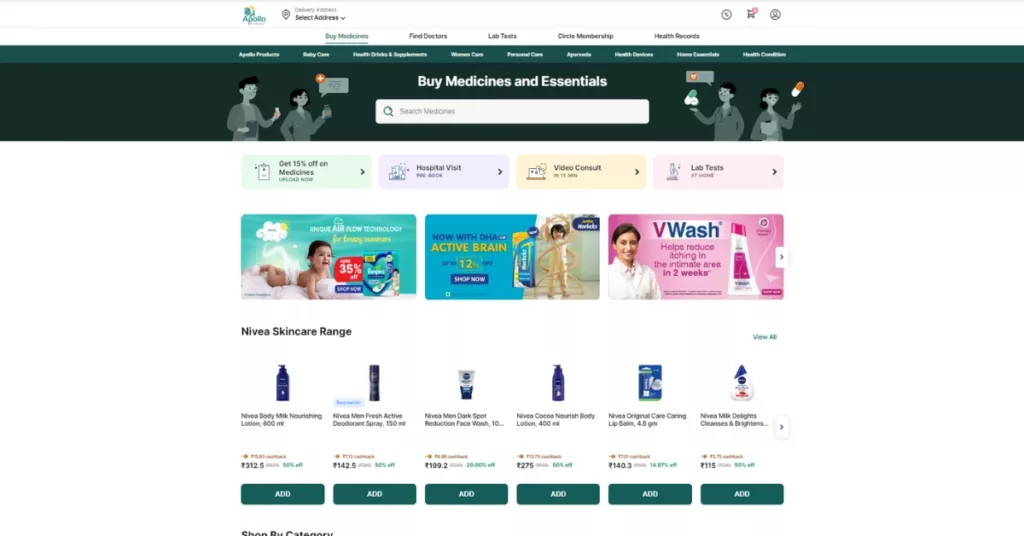
Develop core features
In the basic development phase, businesses should prioritize developing core features for an online pharmacy.
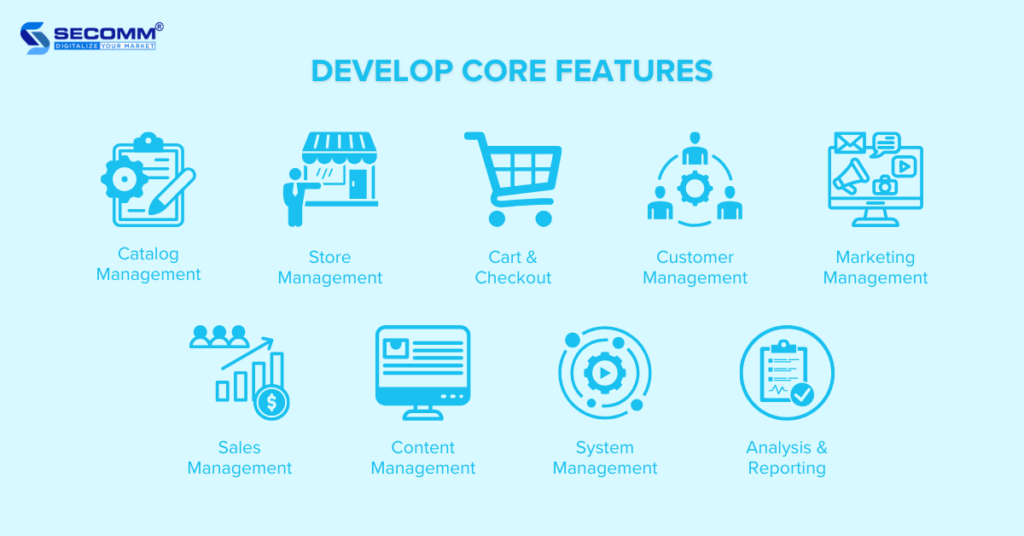
Some essential features that a pharmacy eCommerce website should have include
- Catalog Management: Control product data, features, categories, prices, inventory quantities, and images/videos for smooth operations and optimal business performance.
- Store Management: Handle product inventory, control the business activities, and manage personnel for each branch.
- Cart & Checkout: Manage the shopping cart and customer checkout information.
- Customer Management: Manage customer information to improve marketing effectiveness, shopping experience, and overall customer satisfaction.
- Marketing Management: Optimize SEO and implement marketing programs using supporting tools to boost sales for the business.
- Sales Management: Establish and operate sales processes, orders, payments, and shipping.
- Content Management: Develop and optimize all content-related aspects for CMS pages, image storage, theme customization, and website design.
- System Management: Administer user roles, and explore best practices in terms of security, maintenance, and system care for the website.
- Analysis & Reporting: Support to track, and measure the performance of the eCommerce system, and plan for future strategies
Fulfill legal procedures
After developing features and ensuring a successful testing and website launch, businesses are obligated to complete the legal procedures associated with eCommerce operations.
According to Decree 52/2013/ND-CP by the Government of Vietnam, any individual or organization owning an e-commerce website for sales is required to notify or register with the Ministry of Industry and Trade through the online public service portal of the Ministry of Industry and Trade.
Note: Websites that operate beyond the specified period or fail to register/notify the authorized management agency within the designated timeframe may be subject to administrative penalties as per regulations.
Phase 2: Developing an advanced online pharmacy
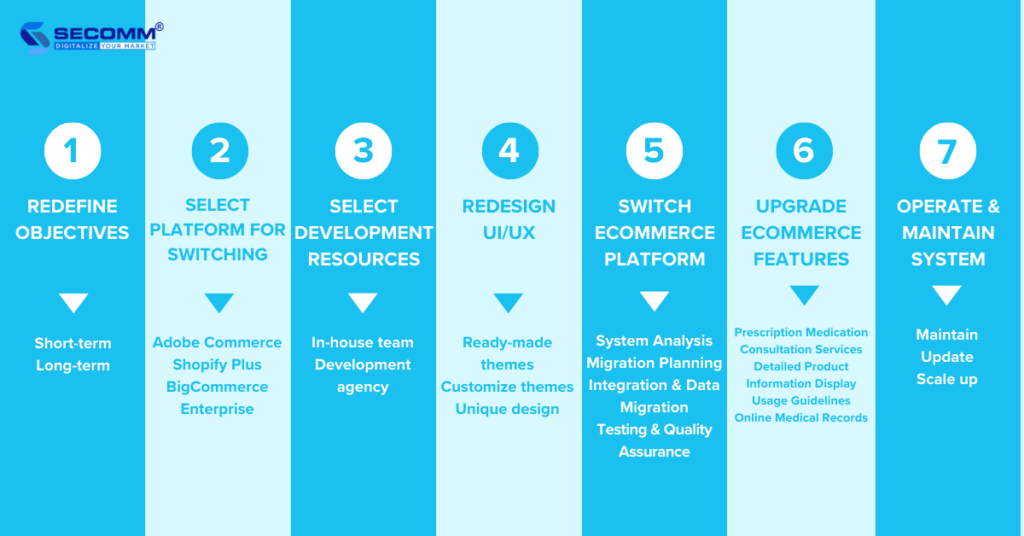
Redefine objectives
In the process of business development and amidst significant market changes, it’s important to realign goals to suit the evolving landscape. This time for business leaders to redefine objectives regarding the overall strategy, timeline, and budget for investing in the pharmacy eCommerce website.
During this phase, businesses often focus on short-term and long-term goals related to expanding the online pharmacy
For long-term goals, businesses may consider goals such as expanding market segments, establishing a loyalty program, and cultivating shopping habits for healthcare products, pharmaceuticals, and medical equipment.
For long-term goals, businesses may prioritize goals related to tapping into new potential customers, revenue growth, and supporting eCommerce marketing strategies such as livestreaming, gamification, affiliate marketing, and influencer marketing.
Select a platform for switching
When SaaS platforms can’t support businesses to expand the system anymore, re-platforming to another robust platform is a top choice. Platforms like Adobe Commerce, Shopify Plus, and BigCommerce Enterprise can help businesses facilitate a deeply custom pharmacy eCommerce website.
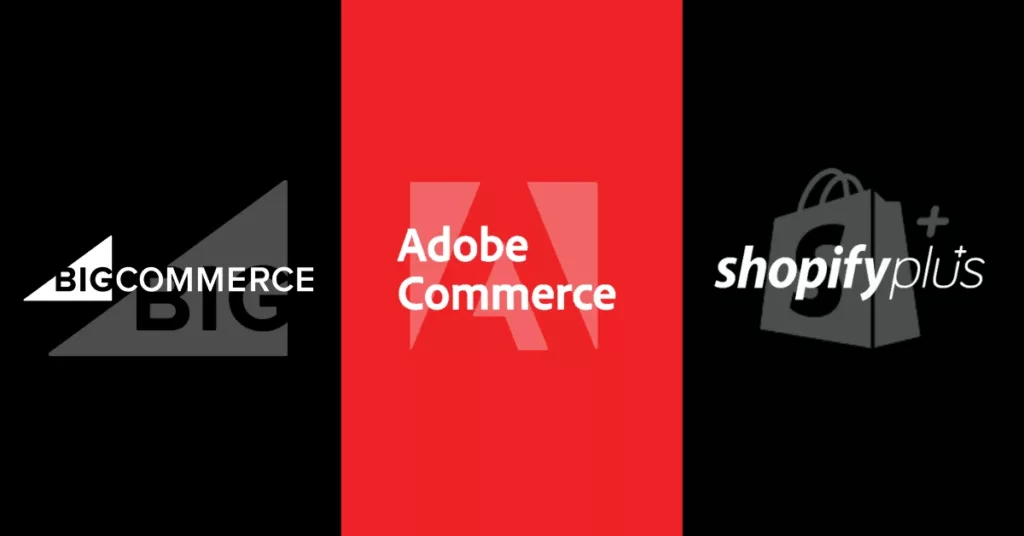
When re-platforming, businesses have challenges such as switching costs, time to train personnel, and data loss throughout the platform migration process.
Select development resources
To build a high-complexity online pharmacy on a professional platform, businesses need resources to facilitate it effectively.
Businesses can decide to build an in-house team or seek a development agency. Regardless of the choice, it requires businesses to have practical experience on the selected platform.
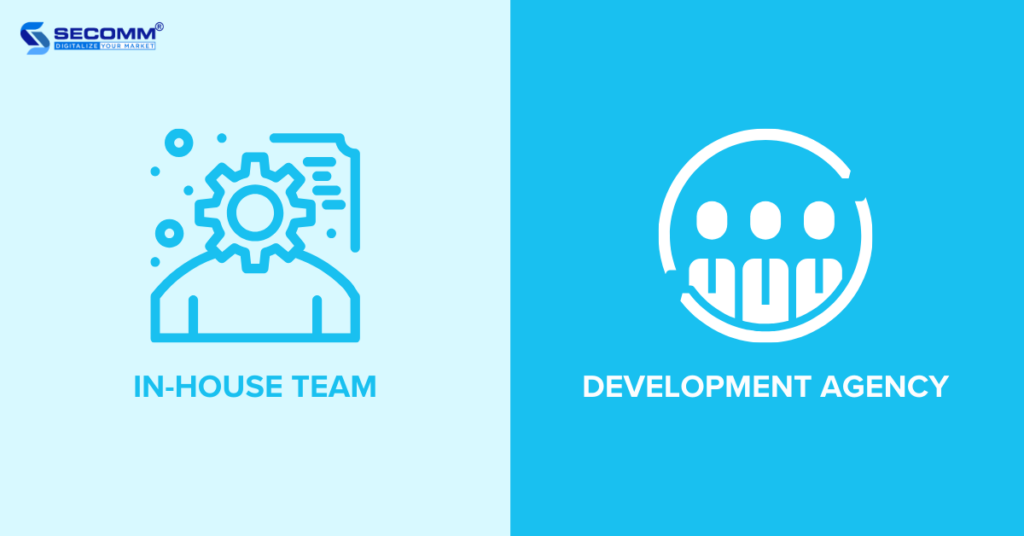
For building an in-house team, businesses need to recruit and train IT and eCommerce personnel to develop on the selected platform. This option may take time and budget to establish a high-performing team but it allows the business to have better control over resources and actively adjust or develop the website system.
In case businesses hire a development agency, here are some criteria to consider:
- Deep Experience in eCommerce: Number of years of experience; Quantity and quality of completed projects; Complexity level of the finished projects.
- Professional Team: Solution consulting specialists; eCommerce specialists; IT personnel; and Customer support.
- Straightforward Process: Analysis; Proposal of solutions; Development timeline; Testing and system maintenance.
- Handling Capabilities: Prompt support; Commitment to warranty and maintenance.
Partnering with a professional development agency will help businesses gain specialized knowledge, enhance experience, and create an online pharmacy tailored to the specific needs of the industry.
Redesign UI/UX
During the platform migration process, businesses can keep the current website design without making any changes. However, some businesses tend to redesign their websites to align with new strategies and the new platform.
Similar to the previous phase, businesses have three options to design their pharmacy eCommerce websites: using ready-made themes, customizing themes, or designing a unique interface.
However, in phase 2, businesses often decide to customize themes or design a unique interface to express the brand image and the pharmaceutical eCommerce industry.
Switch eCommerce platform
After the right eCommerce platform for migrating, businesses should carry out the process to minimize the risk of data loss or errors. Typically, the migration process is automated as much as possible to avoid potential issues.
The migration process includes the following steps:
- System Analysis: Evaluate the current system in detail, including the database, interface design, integrations, and implemented customizations.
- Migration Planning: Develop a detailed plan for the conversion process, including timelines, resources, and participants.
- Integration and Data Migration: Extract data from the old system and transfer it to the new system, including information about products, orders, customers, and other relevant data.
- Testing and Quality Assurance: Conduct comprehensive testing to identify and rectify errors, ensuring that the website operates smoothly and securely.
After re-platforming, the business needs to perform thorough checks to ensure that the data has been migrated completely and accurately according to the plan.
Upgrade eCommerce features
Beyond core features, businesses should focus on building a system with more complex features, including advanced and industry-specific functionalities for pharmaceutical eCommerce.
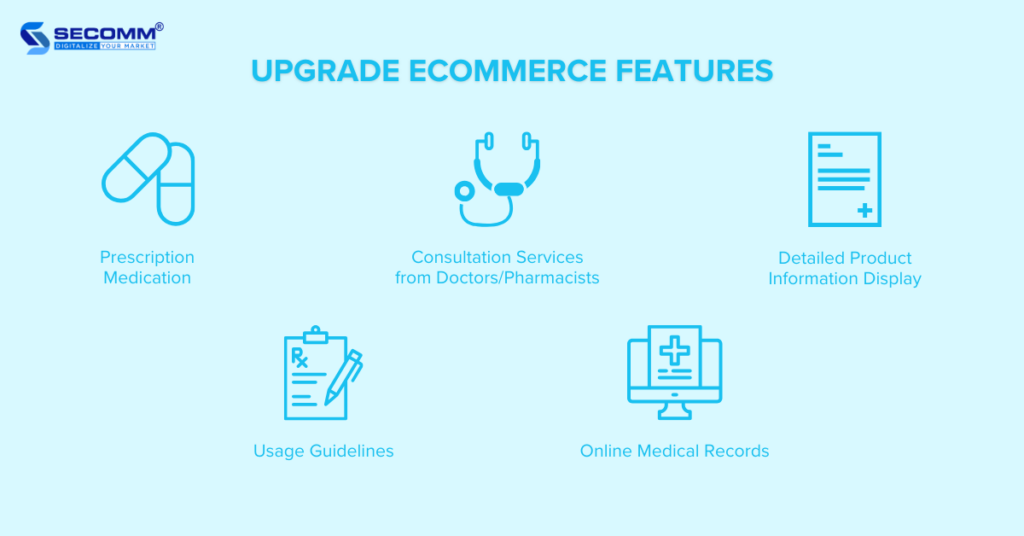
- Prescription Medication: Provide prescription medications based on the doctor’s indications and instructions.
- Consultation Services from Doctors/Pharmacists: Offer health consultation services and online medical examinations as needed.
- Detailed Product Information Display: Provide comprehensive product information, including the name of the medication, ingredients, indications, dosage, usage instructions, side effects, warnings, expiration date, and pricing.
- Usage Guidelines: Provide instructions for the use and dosage adjustment for all medical products, with a reference to the advice of doctors/pharmacists.
- Online Medical Records: Store patient medical records and test results on the system’s information portal.
In addition, businesses need to consistently update and enhance these features to meet user needs and keep pace with market trends.
Operate & maintain system
When testing the eCommerce system, businesses need to thoroughly check the entire website and its features over a specific period to ensure order processing speed and website stability. If any issues arise, businesses should immediately contact the in-house team or development partner to adjust and improve the website accordingly before officially going live.
Once the pharmacy eCommerce website system is stable, businesses should focus on eCommerce marketing strategies or Omnichannel approaches to enhance their online pharmacy.
Additionally, regular maintenance, updates, and continuous system upgrades are essential to sustain growth and quickly adapt to changes in the eCommerce market in general and the healthcare market in particular.
The Bottom Line
In general, the journey of building a pharmacy eCommerce website in Vietnam is not an easy task. This work demands substantial investments of time and budget from businesses to research the most suitable eCommerce strategy for each stage of their development.
Understanding the challenges that businesses may encounter when building an online pharmacy, SECOMM is ready to provide custom solutions for developing an eCommerce system.
Contact SECOMM or call the hotline at 028 7108 9908 for a free consultation.

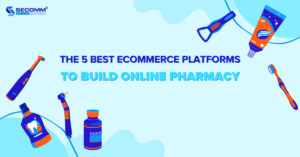
THE 5 BEST ECOMMERCE PLATFORMS TO BUILD ONLINE PHARMACY
 25/12/2023
25/12/2023
 5,218
5,218
 2
2
 0
0
 1
1
According to The Business Research Company, the global pharmaceutical eCommerce market is projected to reach $732.3 billion by 2027. This represents a significant opportunity for pharmacies, healthcare service providers, or hospitals/clinics to implement eCommerce and reach a broader range of potential customers. To achieve this, building an online pharmacy on a professional platform is a great idea to address industry-specific challenges.
Things to keep in mind when building an online pharmacy
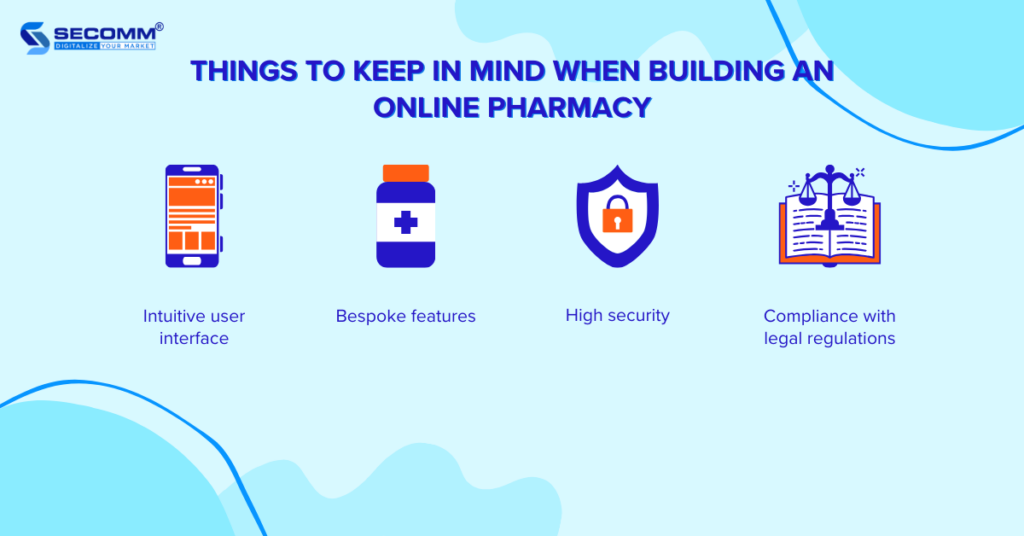
When building a pharmacy eCommerce website, businesses must meet numerous criteria to ensure professionalism, safety, and legal compliance within this industry.
Intuitive user interface
The typical customer profile in the pharmaceutical eCommerce sector consists of individuals seeking to purchase medications, medical equipment, and other healthcare products for themselves, family, or friends.
Thus, the website interface needs to be visually appealing, and user-friendly, and prioritize colors such as blue or white to create a sense of safety and cleanliness.
Other factors, such as layout, font choice, and imagery, should be carefully selected and coordinated to deliver the most professional user experience.
Bespoke features
When building an online pharmacy, beyond default eCommerce features, businesses should focus on developing the following features to address industry-specific needs:
- Prescription Medications: Provide prescription medications based on the doctor’s indications and instructions.
- Consultation Services from Doctors/Pharmacists: Offer health consultation services and online medical examinations on demand.
- Detailed Product Information Display: Furnish comprehensive information about products, including drug names, ingredients, indications, dosage, usage instructions, side effects, warnings, expiration dates, and prices.
- Usage Guidelines: Provide usage instructions and dosage adjustments for all medical products, about the advice of doctors/pharmacists.
- Online Medical Records: Store patient medical records and test results on the system’s information portal.
High security
An online pharmacy is a system that contains various crucial information including personal details, payment information, and the health status of customers. Therefore, the security system of the website needs to be built and deployed carefully to ensure the safety of customer data.
Compliance with legal regulations
Pharmaceutical eCommerce is a specialized business area subject to the regulations of the healthcare/pharmaceutical industry. eCommerce pharmaceutical businesses need to comply with these regulations to ensure that their operations are legal and safe for customers.
Below are some key legal regulations that e-commerce pharmaceutical businesses need to adhere to in Vietnam:
- Pharmaceutical Law: The Pharmaceutical Law regulates the conditions for pharmaceutical business, including requirements for pharmaceutical business licenses, facilities, equipment, personnel, and drug quality.
- Decree 54/2017/NĐ-CP: Decree 54/2017/NĐ-CP provides detailed regulations on pharmaceutical business activities.
- Circular 07/2018/TT-BYT: Circular 07/2018/TT-BYT guides the advertising of drugs, drug ingredients, medical equipment, and cosmetics.
- Circular 04/2016/TT-BYT: Circular 04/2016/TT-BYT guides state management of the pharmaceutical profession.
- Circular 34/2018/TT-BYT: Circular 34/2018/TT-BYT guides state management of drugs and drug ingredients.
In addition, pharmaceutical eCommerce businesses also need to comply with other legal regulations, such as Cybersecurity Law, Consumer Protection Law, and eCommerce Law.
Top 5 eCommerce Platforms to build an online pharmacy
Although this industry has many challenges to deploy, businesses always have eCommerce platforms to create their online pharmacies. Here are the 5 leading platforms for building online pharmacy that businesses may consider.
BigCommerce
BigCommerce is a cloud-based eCommerce platform operating on the Software as a Service (SaaS) model, enabling businesses to create and manage online stores.
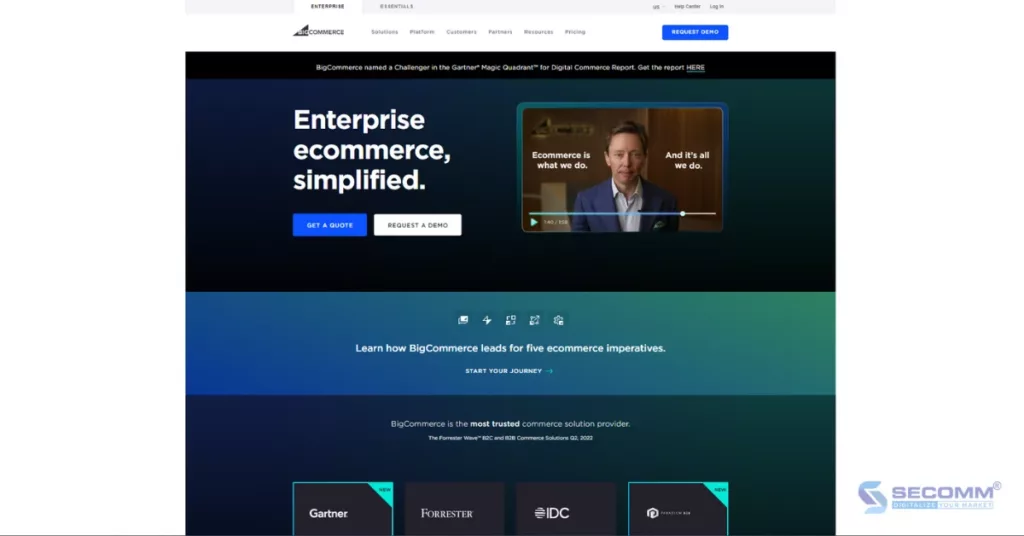
Currently, BigCommerce offers four main solutions, including
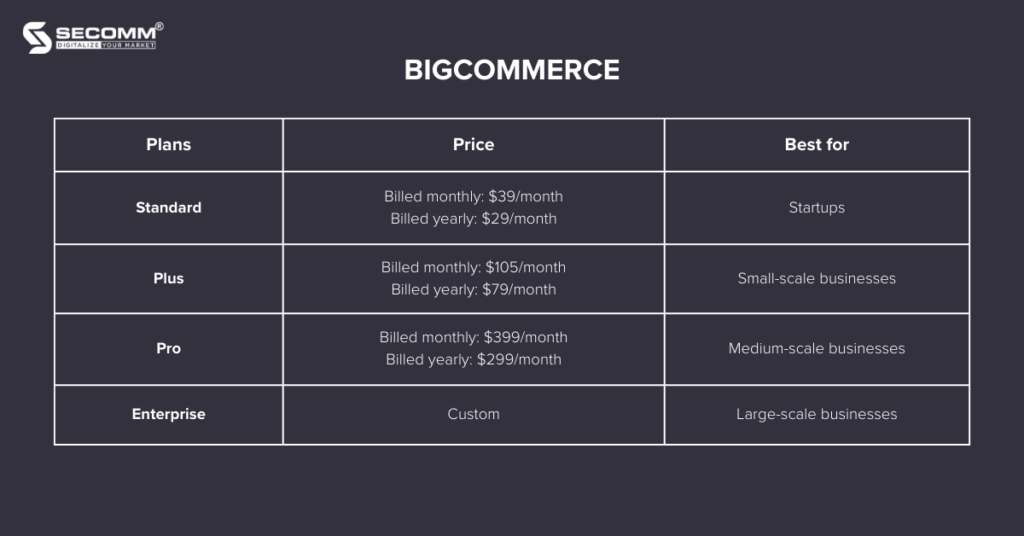
Pros:
- Easy to use: BigCommerce is designed to be user-friendly with a drag-and-drop builder to help businesses create and manage online stores easily without the need for technical skills.
- Multi-channel support: BigCommerce allows pharmaceutical businesses to operate across multiple platforms, including eCommerce websites, social media pages, and online marketplaces.
- Security compliance: BigCommerce is committed to adhering to high-level security standards and protects customer personal information and transaction data.
- Pharmaceutical solutions: BigCommerce offers a variety of features and interfaces specifically designed for the pharmaceutical industry.
Cons:
- Ongoing costs: As a SaaS, BigCommerce requires monthly or annual fees for usage. The value of these fee packages may increase depending on the scale of the business and transaction fees per order.
- Limited customization: While BigCommerce allows customization of eCommerce websites, it limits deeper customization. This could be an issue for businesses with specific customization requirements, such as in the pharmaceutical industry.
- Limited scalability: While BigCommerce can scale, for large businesses or those planning rapid expansion in the future, it may be necessary to consider more specialized platforms to handle these needs.
- Platform dependency: Businesses will rely on BigCommerce’s ecosystem to maintain and update their online stores. This could be a concern if a business needs complete control over its system.
Some famous pharmaceutical eCommerce businesses currently utilizing BigCommerce include Victoria Health, Molton Brown, LARQ, and Zyppah.
Shopify
Shopify is a SaaS eCommerce platform established in 2006. To date, Shopify has rapidly become one of the leading platforms in the eCommerce industry, supporting thousands of businesses worldwide to initiate and grow their online ventures.
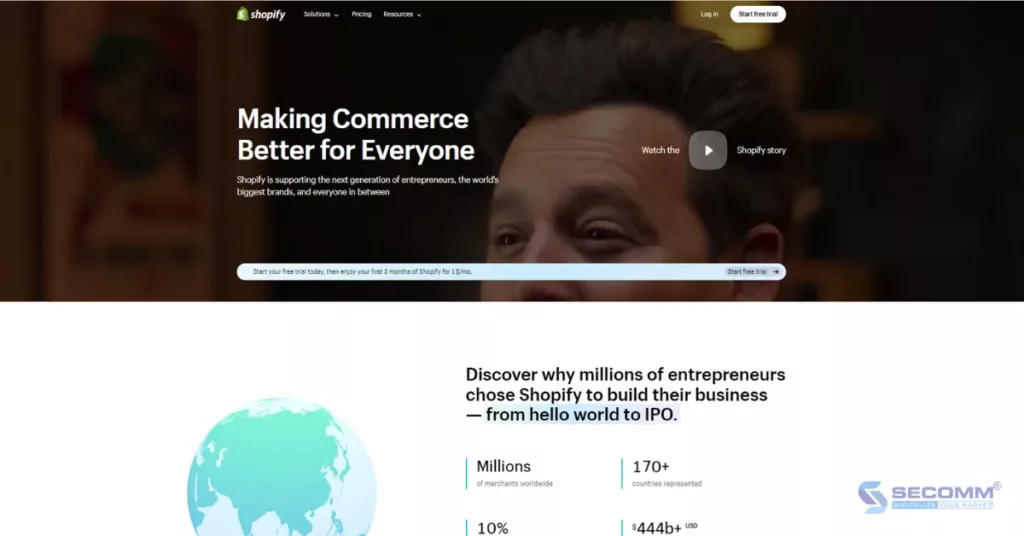
The cost to use the Shopify platform is quite diverse, including these three solutions:
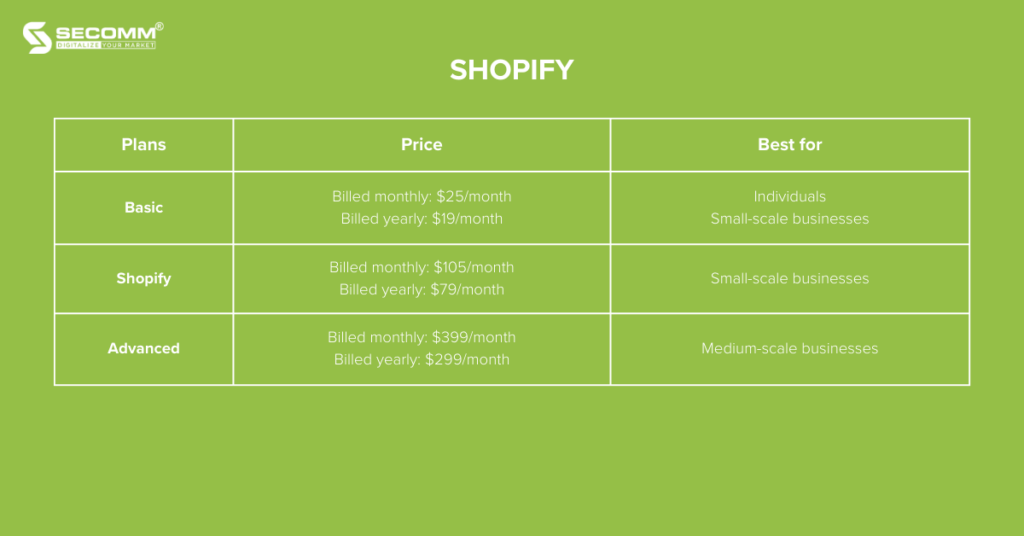
In addition, Shopify provides eCommerce solutions tailored to businesses with different needs and wants, such as:
- Starter: $5/month, leveraging payment features through social networks and messaging apps for businesses.
- Retail: $89/month, includes employee management features, inventory tracking, and loyalty programs for retail stores.
- Commerce Components: Custom pricing, offering third-party modules for integration into the eCommerce website.
- Shopify Plus: Custom pricing, designed for large enterprises.
- Shopify Hydrogen: Custom pricing, for businesses to deploy Headless Commerce.
Learn more: Top 5 benefits of Headless Commerce
Pros:
- Easy to use: Shopify is designed with an intuitive user interface, allowing non-technical users to easily create online stores.
- Diverse pricing plans: Shopify offers a wide range of choices for businesses, catering to small, medium, startup, and large enterprises with various customization needs.
- Data Security: Shopify adheres to important security standards such as PCI DSS (Payment Card Industry Data Security Standard) to keep customer’s personal and healthcare data safe.
- Extensive Feature Set: Shopify provides many features and extensions to meet the needs of building eCommerce websites for various industries, including the pharmaceutical sector.
Cons:
- Ongoing costs: Similar to BigCommerce, Shopify requires monthly or annual fees for service usage, and costs can escalate over time due to transaction fees, expansion of features, etc.
- Limited Customization: Shopify offers a certain level of customization for basic packages like Basic, Shopify, Advanced, Retail, and Starter. If a business requires a highly customized eCommerce website, additional fees must be paid to use other solutions or consider alternative platforms.
- SEO Limitations: While Shopify supports basic SEO optimization, there are some limitations in terms of more advanced SEO optimization and custom URL management.
Healthcare, pharmaceutical, and medical businesses using Shopify include Dr.Axe, 310 Nutrition, Hiya, and BUBS Naturals.
StoreHippo
StoreHippo is a SaaS eCommerce platform established in 2014 in India. Over the years, this platform has consistently updated its technologies to meet the website-building needs of businesses, particularly those in the pharmaceutical eCommerce sector.
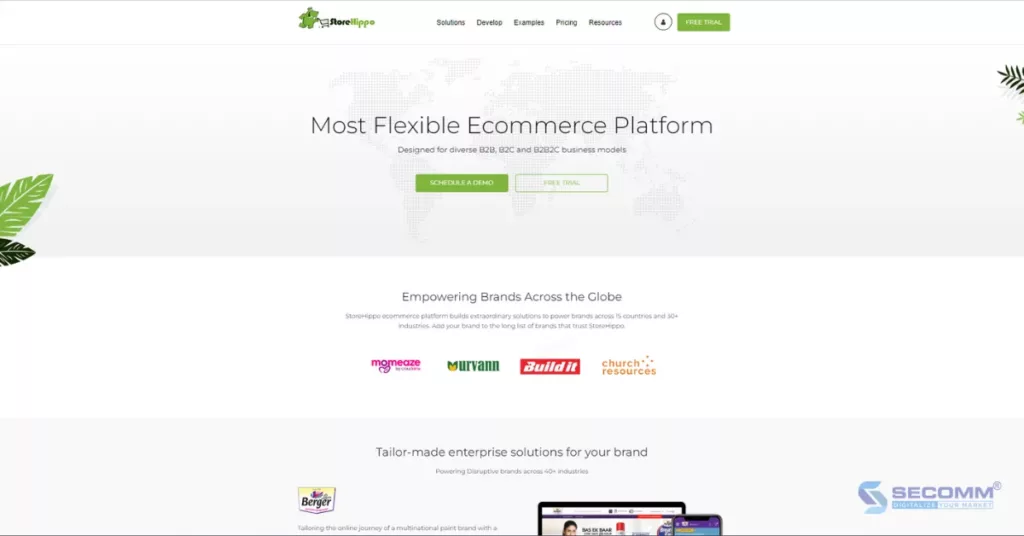
Similar to other SaaS platforms, StoreHippo offers a variety of solutions to choose from:
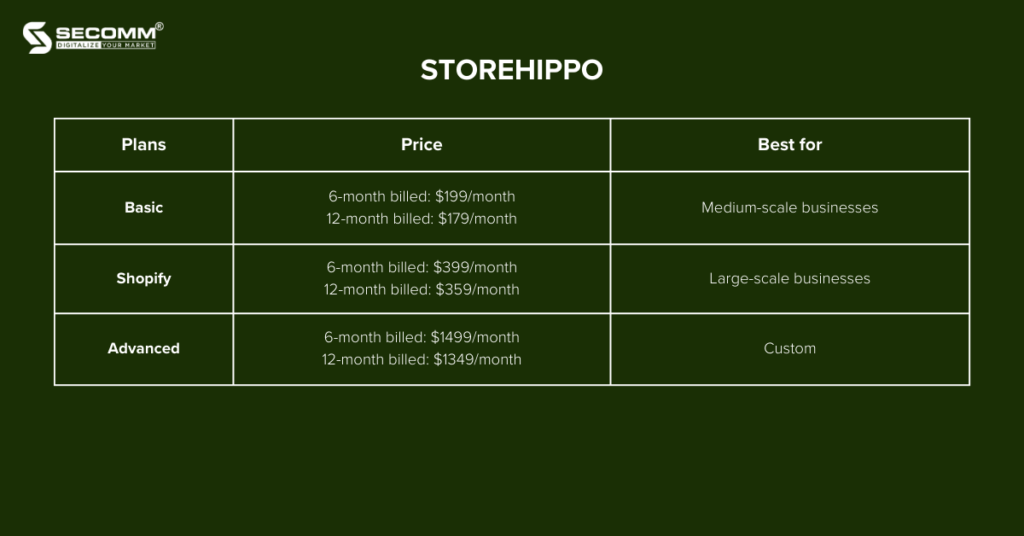
Pros:
- Easy to use: StoreHippo is designed with a user-friendly interface, making it quick and easy for users to create online stores.
- Custom solutions for pharmaceutical eCommerce: StoreHippo provides dedicated solutions for various industries, including online pharmacies.
- Continuous Updates: To address specific functions for each industry, StoreHippo has consistently improved and updated the latest technologies in e-commerce, such as Headless Commerce, PWA, Angular JS, etc.
Cons:
- Limited customization: Although StoreHippo allows businesses to customize their eCommerce website interface, it still limits deeper customization compared to other eCommerce platforms.
- Limited image size: StoreHippo has limitations on the size of images that businesses can upload and use in their online stores.
- Community and Support Limitations: In comparison to larger e-commerce platforms like Shopify, Magento, or BigCommerce, StoreHippo has a smaller user community and customer support, which may slow down the resolution of technical issues or support requests.
Some brands that built their online pharmacy with StoreHippo include WoundProfessional, Kunooz, and On A Healthy Note.
WooCommerce
WooCommerce is an open-source eCommerce plugin developed for the WordPress platform, one of the most popular content management systems (CMS) globally. WooCommerce enables businesses to turn their WordPress websites into online stores or integrate eCommerce features into existing websites.
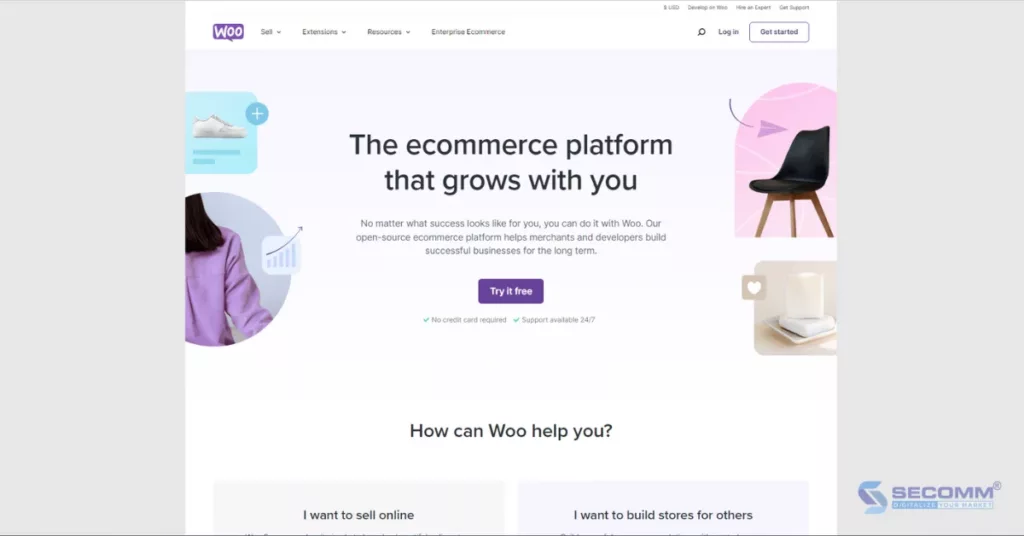
The license fee of WooCommerce depends on the complexity of each project, averaging around $1,000 for a basic eCommerce website and $10,000 for a more advanced eCommerce website.
Pros:
- Free to use: WooCommerce is an open-source platform, so it is entirely free to use and customize. However, associated costs such as hosting, domain, themes, functionality systems, and maintenance should be considered.
- Easy to use: WooCommerce is deeply integrated into WordPress, making the installation and management of online stores straightforward. Users familiar with WordPress will find WooCommerce’s interface user-friendly.
- Third-party integration: WooCommerce has a large development community and supports integration with various third-party applications and services, including features tailored for pharmaceutical eCommerce
- High customization: Businesses can customize the eCommerce website interface using both free and premium themes. WooCommerce also allows businesses to design their interface to reflect their brand.
Cons:
- WordPress dependency: WooCommerce is essentially a plugin for WordPress, meaning businesses must use the WordPress platform to use WooCommerce. This dependency can lead to challenges such as inconsistent support, slow data retrieval, conflicts between updates, etc.
- Complex customization: While WooCommerce allows customization, implementing complex customizations or integrating specific features may be time-consuming and require high technical skills or support from developers.
- Limited scalability: WooCommerce often faces difficulties in handling large online stores with thousands of products and high traffic.
Brands using WooCommerce to build online pharmacy include Dr. Scholl’s, myLAB Box, Superdrug Health Clinics, and Apothecanna.
Adobe Commerce (Magento)
Adobe Commerce, formerly known as Magento Commerce, is a professional and widely used eCommerce system. Adobe Commerce is part of the Adobe Experience Cloud product line and is designed to assist businesses in building eCommerce websites.
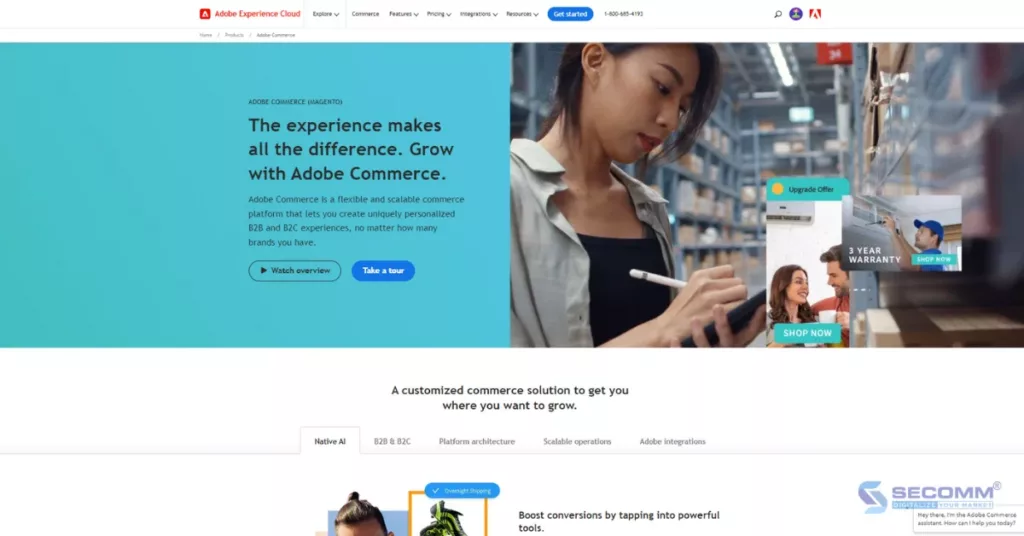
Currently, Adobe Commerce provides businesses with two main versions:
- Adobe Commerce (Magento Commerce): This is the premium version of Magento designed for large enterprises, offering two options: on-premise and on-cloud.
- Magento Open Source: Formerly known as Magento Community Edition, this is the open-source and free version of Magento.
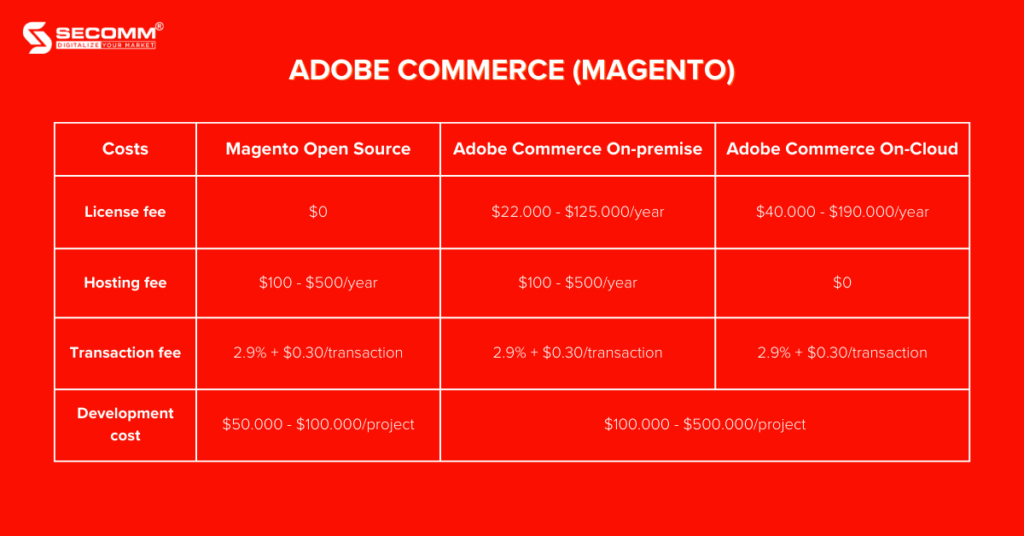
Pros:
- High Scalability: The Magento platform is built with high scalability, allowing businesses to add features and integrate third-party applications as needed.
- High Security: Adobe Commerce prioritizes security, ensuring that customer data and payments are protected securely.
- High customization: All versions of Adobe Commerce have flexible customization capabilities, addressing the complex requirements of various industries, particularly in the pharmaceutical eCommerce sector.
- Adobe Experience Cloud Ecosystem: If a business is using other Adobe products such as Adobe Analytics or Adobe Marketing Cloud, they can integrate them with Adobe Commerce to create a comprehensive system for customer experience.
Cons:
- High initial costs: Adobe Commerce has a higher development cost compared to other eCommerce platforms, making it preferred by medium and large businesses with complex eCommerce systems or high customization needs.
- Require high technical skills: Adobe Commerce is developed using the PHP programming language, which is relatively complex, requiring technical personnel with expertise and experience to develop projects correctly and effectively.
- Long deployment time: Deploying Adobe Commerce may take more time, especially for highly customized or complex eCommerce websites.
This list is just a few examples for businesses to reference; there are many other robust eCommerce platforms that businesses can consider based on specific needs and available resources.
With extensive experience in implementing eCommerce for clients in various countries, SECOMM understands the challenges and difficulties businesses face during the deployment of pharmaceutical eCommerce.
Contact SECOMM now or call the hotline at 02871089908 today for a free consultation.

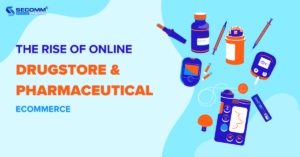
THE RISE OF ONLINE DRUGSTORE & PHARMACEUTICAL ECOMMERCE
 22/12/2023
22/12/2023
 11,607
11,607
 2
2
 0
0
 1
1
In the ever-growing digital age, online drugstores have become an ideal destination for global users seeking convenient and safe ways to care for their health and purchase medications online. The robust growth of eCommerce and changes in user behavior have driven the expansion of this pharmaceutical eCommerce industry.
Below are some crucial insights into why pharmaceutical eCommerce has become an essential component of the modern healthcare system.
What is Pharmaceutical eCommerce?
Pharmaceutical eCommerce has become a promising business model in recent years. According to the “Healthcare eCommerce Global Market Report” compiled by The Business Research Company, pharmaceutical eCommerce is categorized into three main models:
- By type: drug, medical devices
- By application: telemedicine, caregiving services, medical consultation
- By end user: hospitals, clinics, other end users
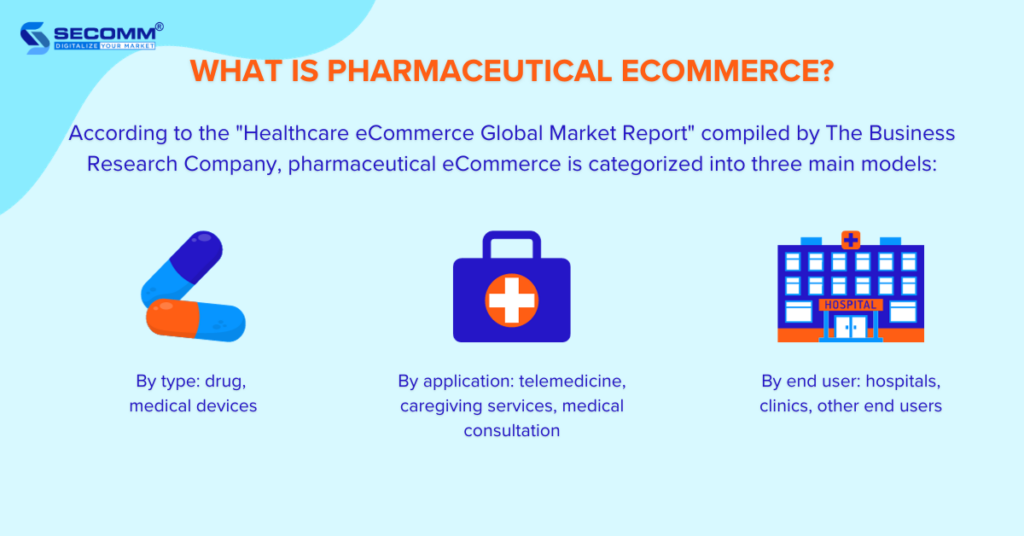
Pharmaceutical eCommerce by Type
This is a model that enables consumers to order and purchase various products such as prescription drugs, over-the-counter medications, vitamins, dietary supplements, healthcare, personal care, etc., through online shopping channels.
Some well-known pharmaceutical eCommerce by type examples include Droga Raia (Brazil), Netmeds (India), Pharmacity (Vietnam), etc.
Pharmaceutical eCommerce by Application
Consumers can access healthcare consultation, advice, and diagnostic services through various applications for this type of pharmaceutical eCommerce. Under this model, consumers typically subscribe to and pay for these services through packages or on a subscription basis (monthly or yearly).
Companies adopting this service-oriented eCommerce model include Teladoc (USA), iCliniq (India), SBB Healthcare (Vietnam), and others.
Pharmaceutical eCommerce by End User
This pharmaceutical eCommerce model often involves websites or applications created by hospitals/clinics to assist patients in scheduling appointments, offering healthcare packages, prescription medications, and more.
Examples of hospitals/clinics following the eCommerce model by end-users include The Royal Melbourne Hospital (Australia), NYC Health+ Hospital (USA), Vinmec (Vietnam), and others.
The Potential of Pharmaceutical eCommerce
Certainly, Covid has not only led to a rise in traditional healthcare expenditures but has also acted as a driving force for pharmaceutical eCommerce. In the United States, telehealth visits witnessed a remarkable surge of 2,600% in March 2020 (during the peak of the COVID-19 outbreak in the U.S.) compared to the same month in 2019.
The growth of the pharmaceutical eCommerce market seems unabated. According to a recent report by CMS, total healthcare spending in the United States reached $3.8 trillion, marking a 4.6% increase in 2022. The Asia-Pacific region is anticipated to experience rapid growth in healthcare eCommerce, with a projected CAGR of 20.5% from 2020 to 2027.
Nielsen predicts that the pharmaceutical eCommerce market in Vietnam will attain a value of $10 billion by 2025.
Some other reasons for the rise of pharmaceutical eCommerce include:
- Population Growth and Healthcare Demand: The increasing global population and improving quality of life lead to a growing demand for healthcare.
- Advancements in Information Technology and the Internet: The development of information technology and the Internet facilitates easy access for consumers to information about healthcare products and services, fostering a greater inclination towards online pharmaceutical shopping.
- Changes in Consumer Lifestyles: Consumers are becoming busier, and there is a trend towards increased online shopping, especially after COVID-19, creating favorable conditions for the growth of online pharmacies.
Top brands built their pharmacy eCommerce websites
Apollo Pharmacy (India)
Apollo Pharmacy is a well-known retail pharmacy chain in India, affiliated with the Apollo Hospitals. After years of operation in the healthcare sector, Apollo decided to establish an eCommerce website to serve millions of customers nationwide. The Apollo eCommerce website is built on the Magento platform, ensuring the capability to manage an extensive product catalog.
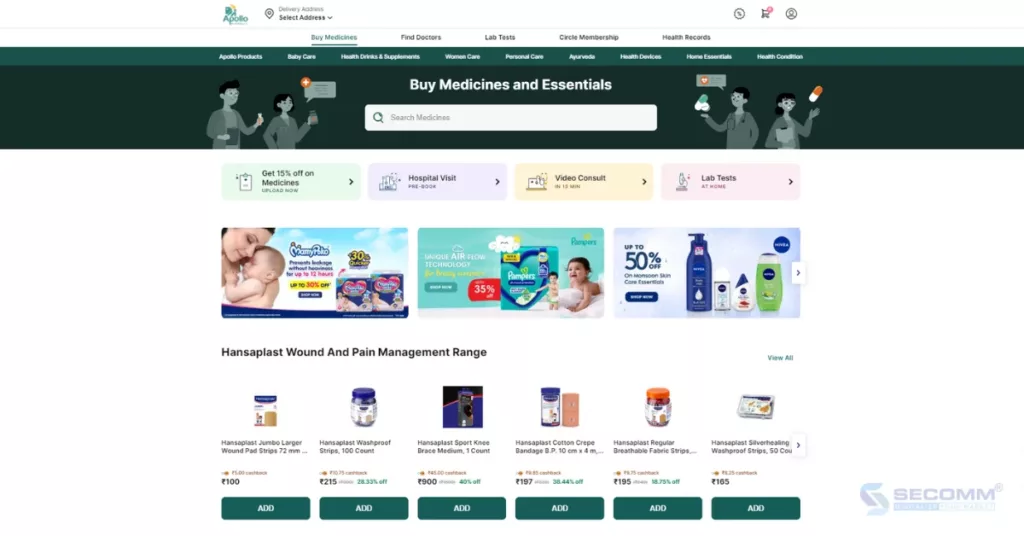
Beyond selling prescription and non-prescription drugs, as well as health care products, Apollo also provides various related services. Among these, notable offerings include online consultation services, health check-up appointments, vaccination appointments, and insurance sales.
Teladoc (USA)
Teladoc Health, Inc. is an American healthcare technology company headquartered in Purchase, New York. The company provides remote healthcare services, including video consultations, phone consultations, and remote health monitoring.
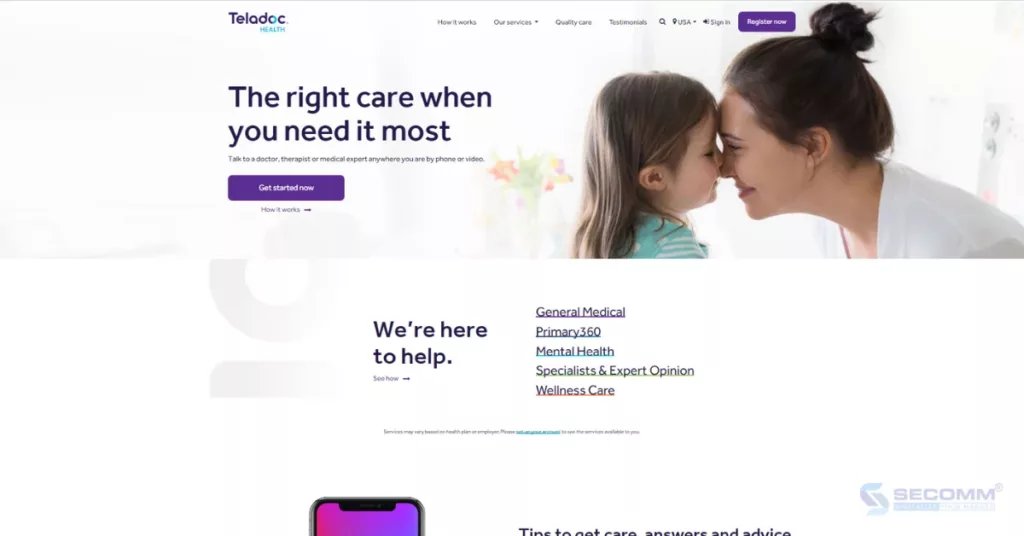
By rapidly deploying a website and eCommerce application, along with the utilization of cutting-edge technologies such as artificial intelligence (AI), machine learning (ML), and data analytics, Teladoc has been able to enhance customer experience and deliver improved remote healthcare services.
Mayo Clinic (USA)
Mayo Clinic was founded in 1889 by Dr. William W. Mayo and his two sons, Dr. Charles and Dr. William J. Mayo. Initially, Mayo Clinic was a small clinic specializing in providing healthcare services to the local community. However, the hospital quickly expanded and became one of the leading hospitals in the world.
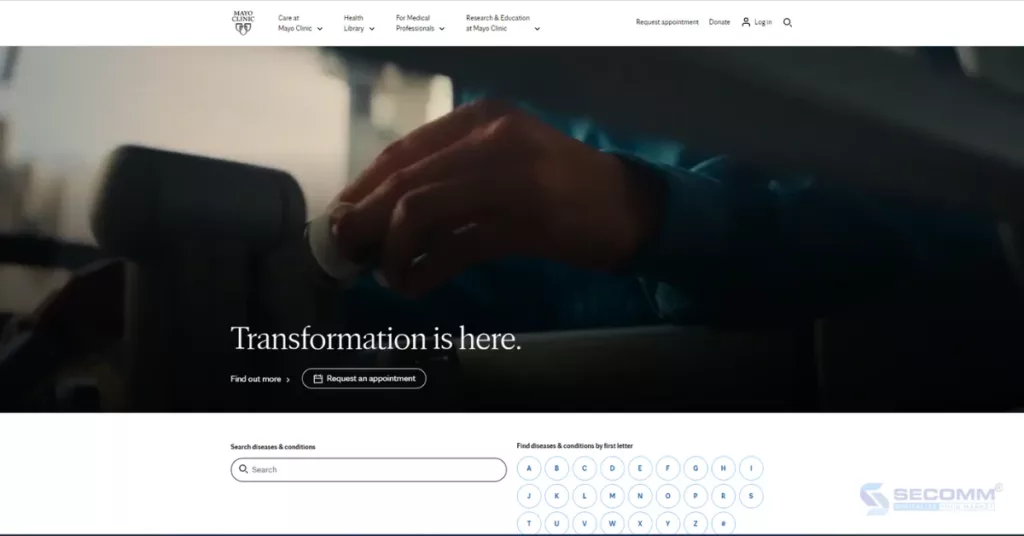
Much of Mayo Clinic’s success can be attributed to the early adoption of eCommerce, allowing patients to schedule appointments, check test results, and purchase medications online. This has helped patients save time and effort, contributing to Mayo Clinic’s overall success.
Learn more: The 10 Best Remarkable Pharmacy eCommerce Websites
The Bottom Line
Pharmaceutical eCommerce not only brings convenience and diverse choices for consumers but also presents attractive business opportunities for healthcare enterprises. If invested systematically and guided correctly, businesses in this field can seize significant opportunities in this promising market.
With extensive experience in implementing eCommerce for customers in various countries, SECOMM understands the difficulties and challenges that businesses face during the deployment process.
Contact SECOMM now or call directly at the hotline number (02871089908) today for a free consultation

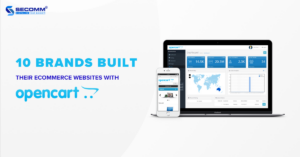
TOP 10 OPENCART ECOMMERCE WEBSITES YOU SHOULD KNOW
 22/12/2023
22/12/2023
 7,767
7,767
 2
2
 0
0
 1
1
OpenCart is an open-source eCommerce platform based on the PHP programming language, utilizing the MySQL database and HTML components to build eCommerce websites. According to Builtwith, the platform powers over 2,500 websites, with the majority in the United States and Russia.
OpenCart offers businesses various options for building eCommerce websites: Free (Open Source) and Cloud Store (Paid). Due to the flexibility of open-source code, many businesses choose this platform to meet specialized requirements in website development.
Below are some brands that have used OpenCart to create dedicated eCommerce websites
Bensound
Bensound is the brainchild of musician Benjamin Tissot, founded in 2012. It is an eCommerce website specializing in providing free and licensed music, as well as sound effects. Initially, Benjamin Tissot composed and licensed only his songs on this platform.
However, as the service grew, Benjamin Tissot started accepting musical works from other artists, making it an ideal destination for content creators on platforms like YouTube, Facebook, and Instagram.
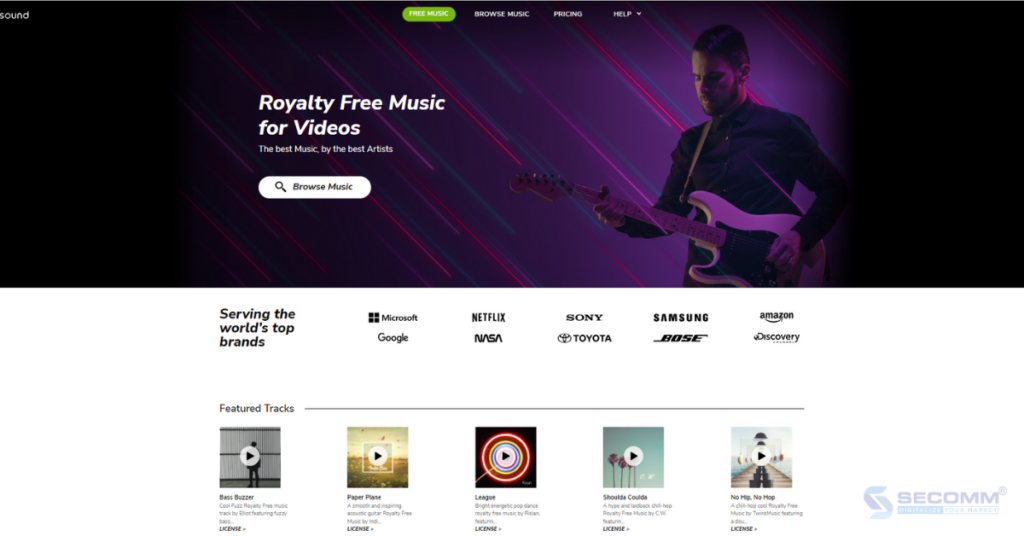
- Website: https://www.bensound.com/
- Industry: Music
- Traffic: 632.3K/month
- Ranking: #69,810 (USA) & #86,312 (Worldwide)
Vicrez
Vicrez is an online automotive parts retailer established in 2014 in the city of Whittier, Southern California, USA. What sets Vicrez apart is that customers can shop online for any external car parts and accessories to customize their vehicles according to their individual preferences.
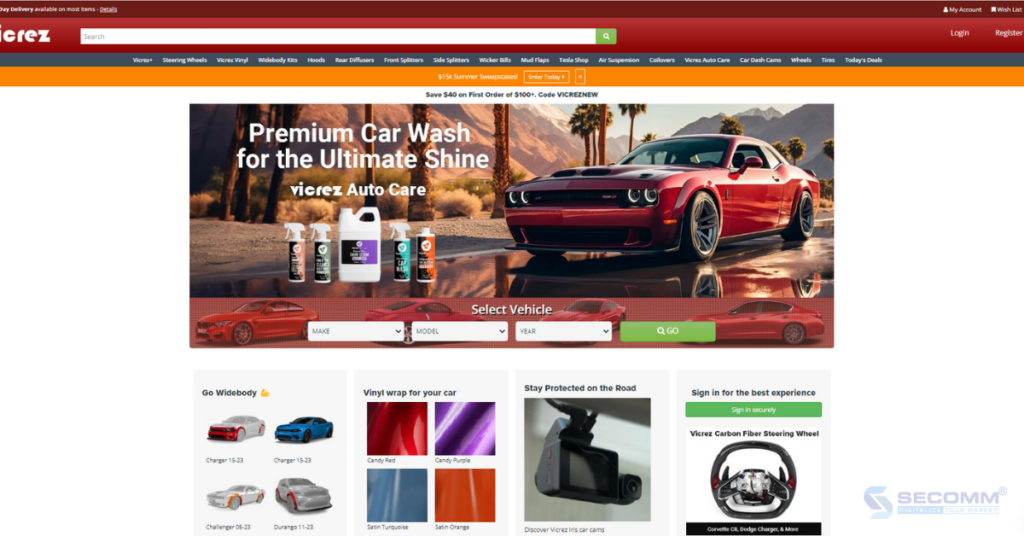
- Website: https://www.vicrez.com/
- Industry: Auto parts
- Traffic: 335.3K/month
- Ranking: #67,964 (USA) & #218,262 (Worldwide)
Pharmacy Direct
Pharmacy Direct is the first online pharmacy to follow the eCommerce model, owned and operated by pharmacists in Australia since 1996. Initially, the brand operated on a small scale, serving local customers. However, as the demand for health products in Australia steadily increased, Pharmacy Direct experienced remarkable growth.
The business invested more in its eCommerce website to offer over 17,000 products, including vitamins, supplements, beauty products, fragrances, childcare products, prescription medications, and over-the-counter medicines from reputable pharmaceutical brands. This expansion allowed Pharmacy Direct to provide online services to the Australian population.
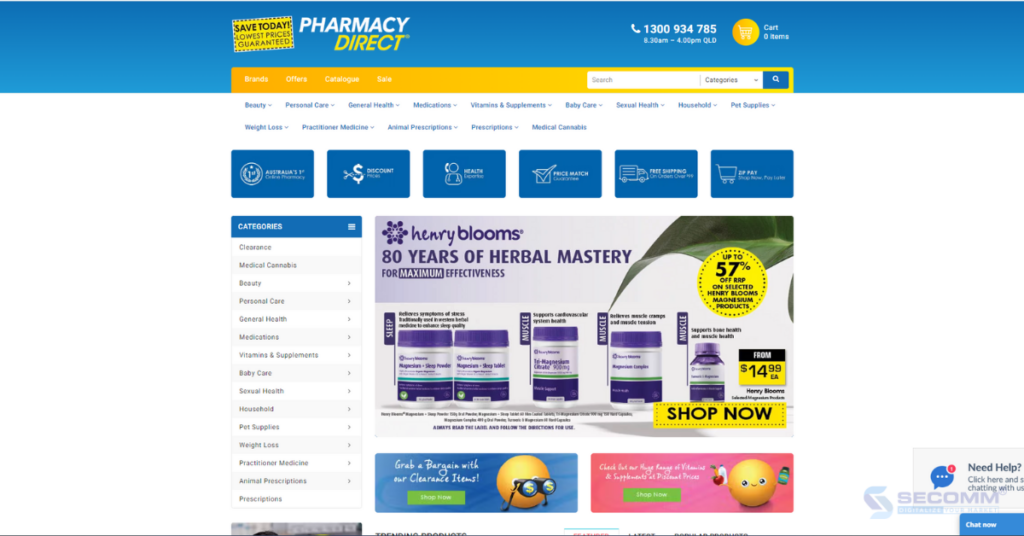
- Website: https://www.pharmacydirect.com.au/
- Industry: Pharmacy
- Traffic: 247.4K/month
- Ranking: #2,005 (Australia) & #126,629 (Worldwide)
Get Laid Beds
Get Laid Beds is a business specializing in handcrafting solid wood beds, founded in 2012 by John and Jean, a pair of architect and carpenter friends.
After more than 10 years of development, Get Laid Beds has expanded its product lines to include bedroom furniture, focusing on building its eCommerce website and enhancing customer service. This brand has gained popularity among customers in the UK and the US.
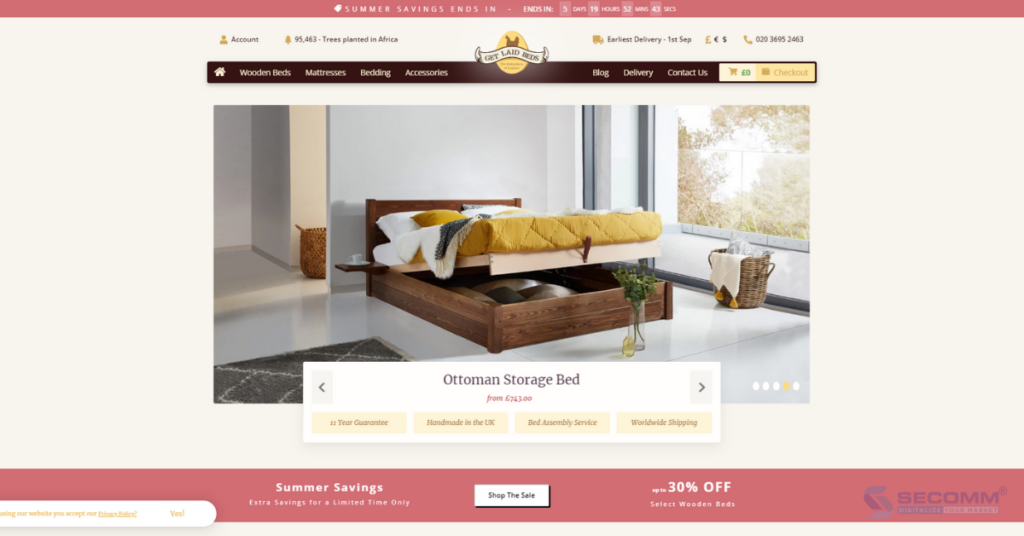
- Website: https://www.getlaidbeds.co.uk/
- Lĩnh vực: Nội thất
- Lưu lượng truy cập: 209.1 nghìn/tháng
- Xếp hạng: #7,415 (Anh) và #186,306 (Toàn cầu)
Self Edge
Self Edge is a men’s fashion brand with a vintage style, established in 2006 by the American couple Kiya and Demitra Babzani. Currently, Self Edge has a presence in major cities such as San Francisco, New York, Los Angeles, Portland, and San Jose del Cabo.
Additionally, Self Edge focuses on developing its eCommerce website to reach new customers across the United States and Mexico.
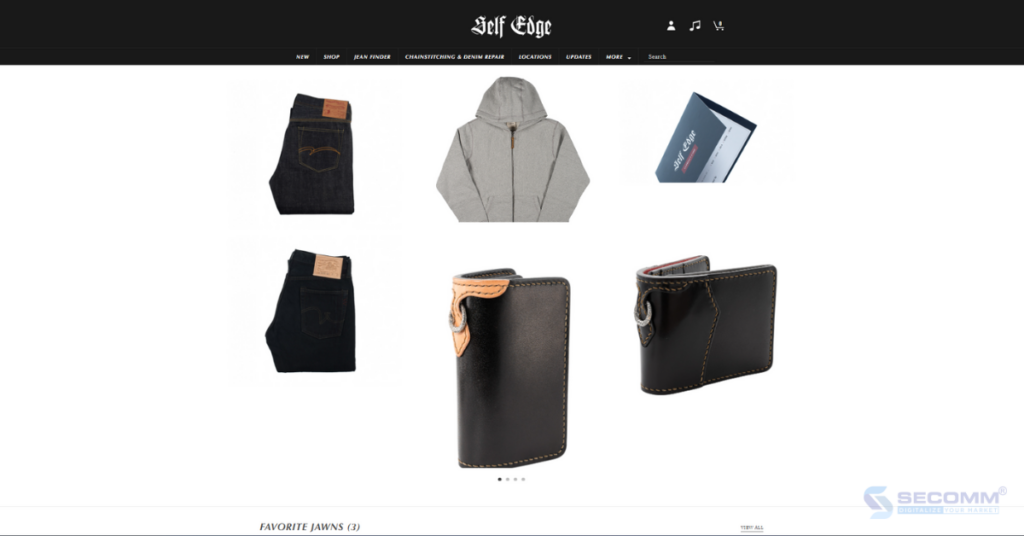
- Website: https://www.selfedge.com/
- Industry: Fashion
- Traffic: 194.5K/month
- Ranking: #67,298 (USA) & #223,754 (Worldwide)
BNA Model World
BNA Model World is a model business established in 2007 in Australia. Since its establishment, the brand’s management has focused on the eCommerce market and gradually upgraded its products/services. Currently, BNA Model World offers over 100,000 products from more than 1,000 manufacturers, serving over 104,000 customers worldwide.
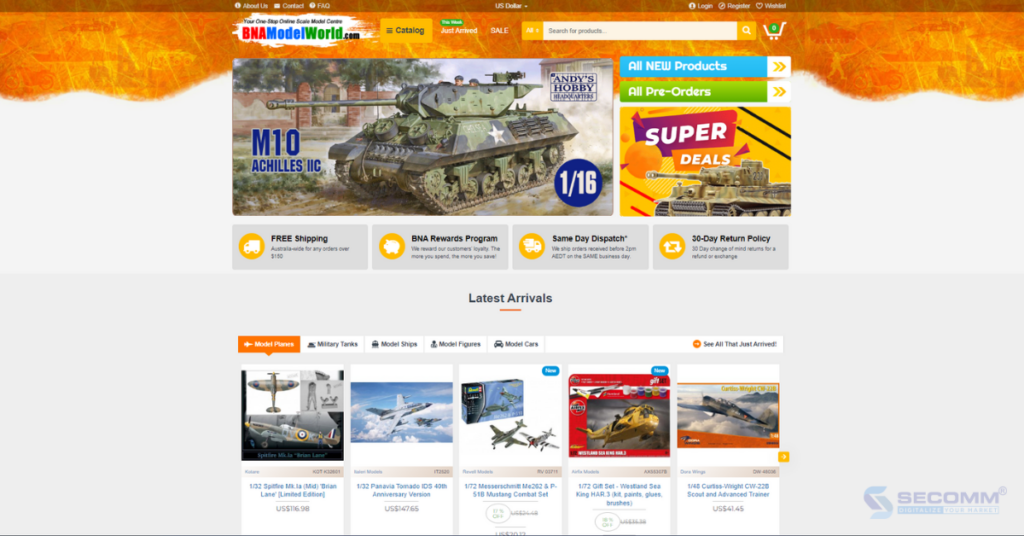
- Website: https://www.bnamodelworld.com/
- Industry: Model
- Traffic: 142.7K/month
- Ranking: #8,314 (Australia) & #226,563 (Worldwide)
Godukkan
Godukkan is a consumer electronics retail business established in 2017 and headquartered in Dubai, United Arab Emirates (UAE). Godukkan’s main goal is to become the number one eCommerce website in the UAE, offering a wide range of products, including laptops, mobile phones, tablets, PCs, gaming equipment, and more.
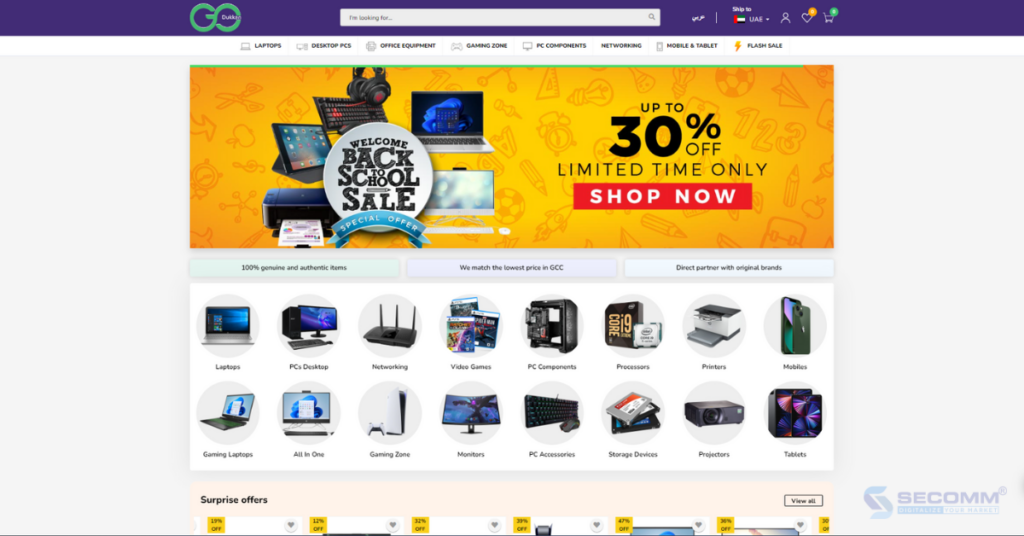
- Website: https://www.godukkan.com/
- Industry: Consumer Electronics
- Traffic: 136.4K/month
- Ranking: #2,893 (UAE) & #274,790 (Worldwide)
Get Er Brewed
Get Er Brewed is a beverage brand specializing in brewing beer, wine, tea, etc., as well as supplying fermentation ingredients and brewing equipment. The business was established in 2013 and is based in Northern Ireland.
In recent years, Get Er Brewed has expanded its reach by launching an OpenCart website to cater to an international customer base, achieving certain successes, particularly in securing contracts for the installation of fermentation and brewing systems.
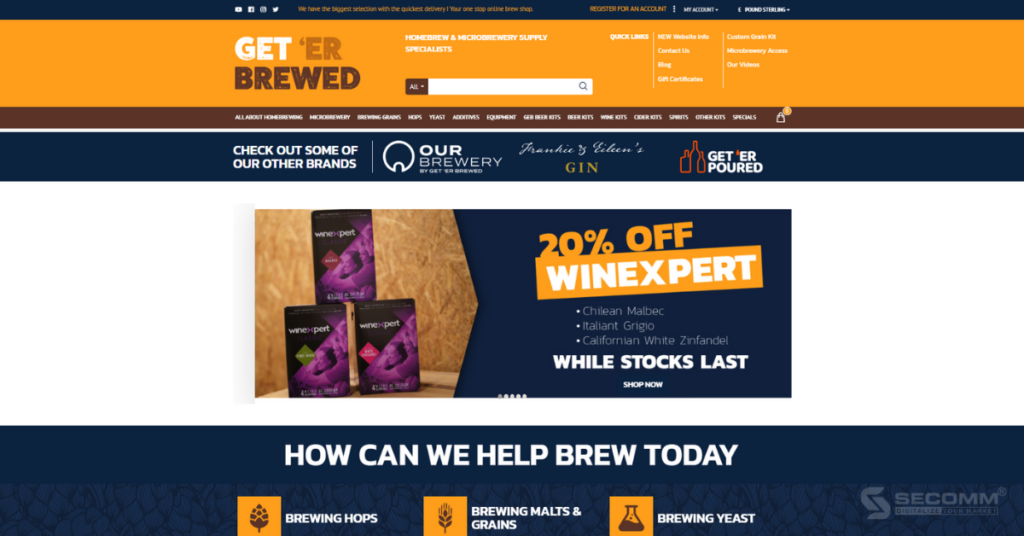
- Website: https://www.geterbrewed.com/
- Industry: Beverage
- Traffic: 110.0K/month
- Ranking: #38,209 (UK) và #380,234 (Worldwide)
CatSmart
With over 20 years of experience in the pet industry, brothers Raymond and Roger decided to establish CatSmart, the largest cat-centric brand in Singapore. Currently, CatSmart is actively investing in its OpenCart website and expanding its presence beyond traditional retail branches in the “Lion City.”
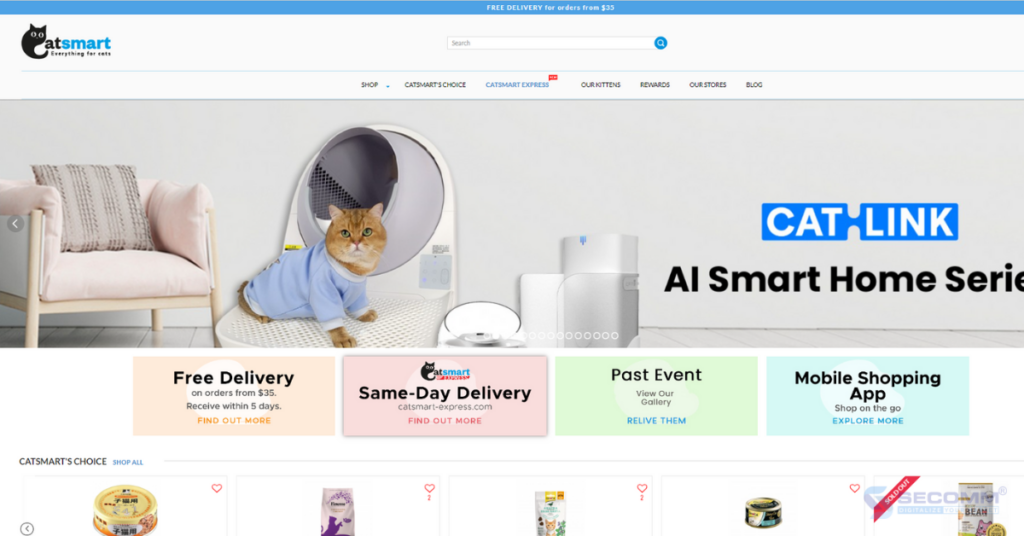
- Website: https://catsmart.com.sg/
- Industry: Pet
- Traffic: 48.8K/month
- Ranking: #850,172 (Singapore) & #9,174 (Worldwide)
Derails
Derails is a business specializing in designing and selling model trains, established in 2010. With the boom of eCommerce, Derails began building an OpenCart website to adapt to the changing market.
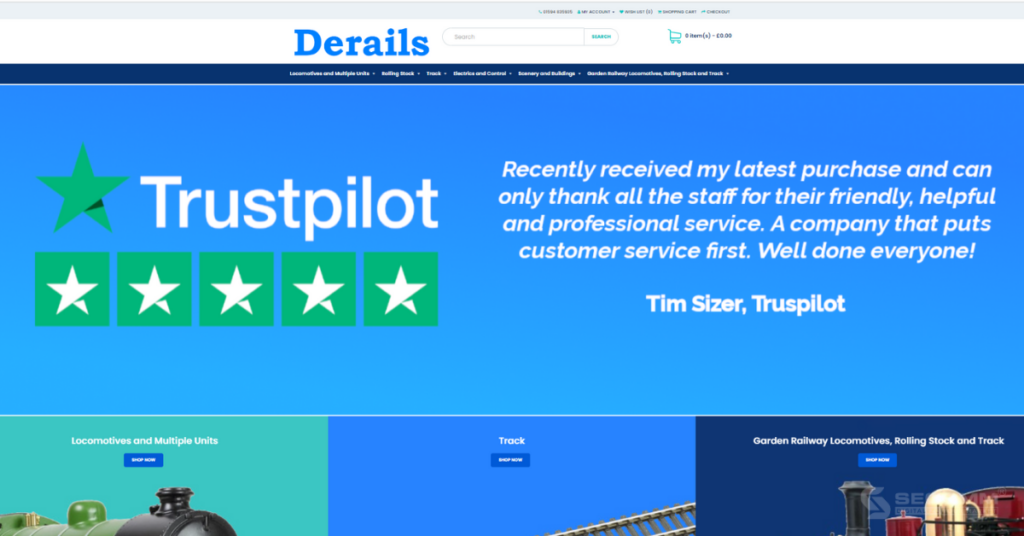
- Website: https://derails.co.uk/
- Industry: Model railways
- Traffic: 26.2K/month
- Ranking: #104,013 (UK) & #1,926,389 (Worldwide)
The Bottom Line
Here are 10 brands that have developed OpenCart websites and achieved success in both branding and revenue. This success serves as inspiration for other businesses seeking solutions to break through their operations and enhance competitiveness in the market.
Learn more: OpenCart vs Magento: Which Fits Your Business Best?
With extensive experience in deploying eCommerce for clients in many countries, SECOMM understands the difficulties and challenges that businesses face during implementation.
Contact SECOMM now or call the hotline at 02871089908 today for a free consultation.

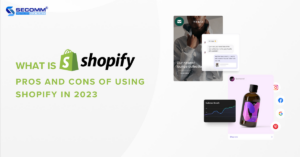
WHAT IS SHOPIFY? 9 KEY PROS AND CONS OF USING SHOPIFY IN 2023
 22/12/2023
22/12/2023
 5,374
5,374
 2
2
 0
0
 1
1
The eCommerce world is growing, and the significance of building and developing eCommerce websites has never been more crucial. Among the popular SaaS platforms, Shopify stands out as a name that commands attention.
Shopify is a SaaS platform and an outstanding solution that helps thousands worldwide turn their online business ideas into reality.
So, what is it? Why it is the top choice for eCommerce businesses, ranging from small-scale to large-scale operations. Let’s explore the power of Shopify in this article.
What is Shopify?
Shopify is a widely used eCommerce platform that allows businesses to build, develop, and manage their online store. With its user-friendly interface, even those with limited technical expertise can effortlessly navigate it easily.
How does Shopify work?
Shopify operates as a Software as a Service (SaaS), requiring businesses to pay a monthly fee for usage and adhere to the platform’s regulations. However, the platform manages hosting and takes responsibility for technical issues, ensuring the security and efficient operation of the business’s eCommerce website.
Shopify pricing
- Pricing plans
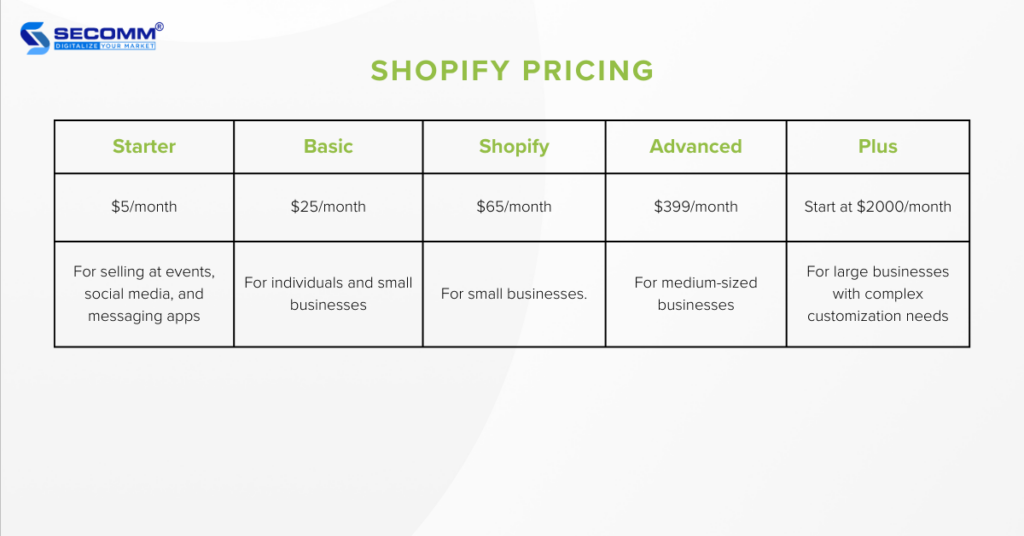
Until now, businesses have been familiar with 5 main solutions: Starter, Basic, Shopify, Advanced, and Plus. Recently, the platform introduced a new advanced solution called Commerce Components. This solution allows businesses to use the platform as a modular service, paying only for the features they need. It’s worth noting that this new solution is currently exclusive to the U.S. market.
- Transaction fees
For the Basic, Shopify, Advanced, and Plus plans, transaction fees are waived when businesses use Shopify Payments. However, in reality, this payment method isn’t available for all countries. Currently, it only supports countries in this list.
Conversely, transaction fees will apply at rates of 2%, 1%, 0.5%, and 0.15%, respectively. For the Starter plan, whether or not using it, transaction fees still apply and are relatively high at 5%.
Plus businesses using this payment method will enjoy no transaction fees. However, this exemption doesn’t apply to businesses in Austria, Belgium, and Sweden, even though these countries are included in the list.
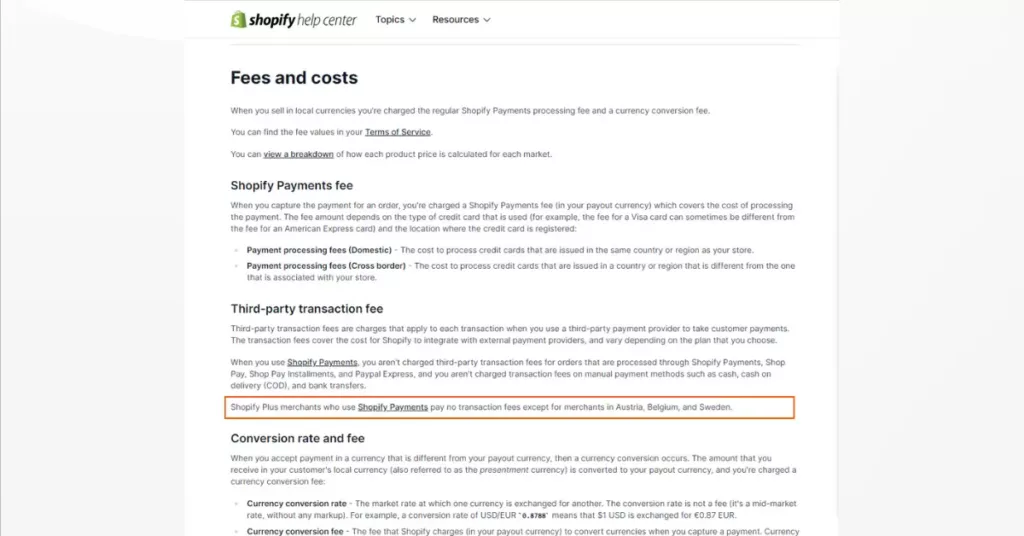
Pros of Shopify
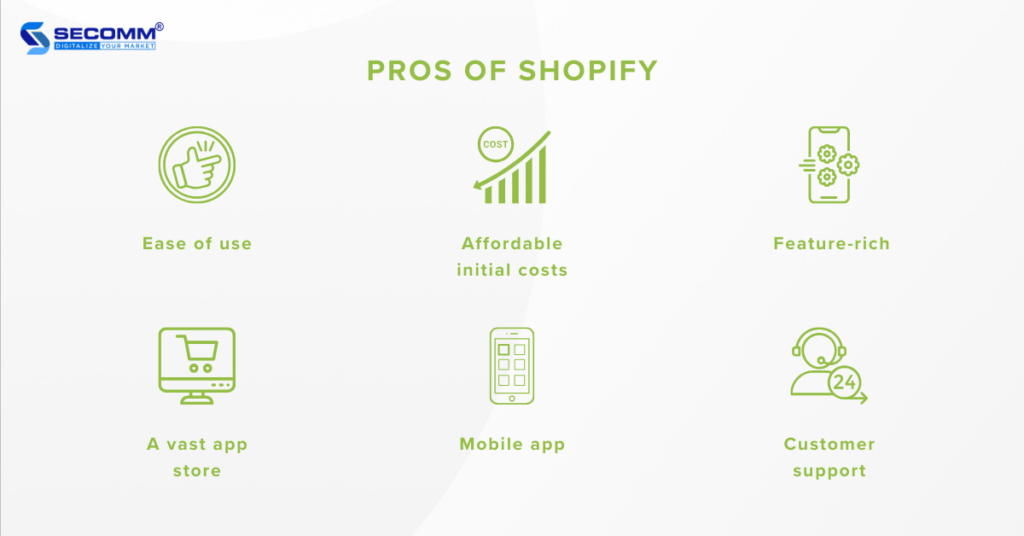
Ease of use
The platform is designed with an intuitive interface, allowing users with limited technical expertise to navigate it effortlessly. The platform offers a drag-and-drop editor, enabling businesses to easily add or remove products and make quick customizations.
Businesses also have the flexibility to customize layouts, colors, fonts, and font sizes, and add or remove elements and widgets from both free and premium themes.
Moreover, it offers businesses documentation and tutorial videos, ensuring a seamless and efficient setup and utilization experience.
Affordable initial costs
The platform provides a range of cost-effective solutions suitable for startups and small to medium-sized businesses entering the eCommerce market. However, larger enterprises often prefer the Shopify Plus solution, given its reasonable costs of around $2,000, offering customization and scalability comparable to open-source platforms.
Moreover, as a SaaS platform, businesses pay a monthly fee for using it based on actual Gross Merchandise Volume (GMV), eliminating the need for a substantial one-time payment common with open-source platforms.
Feature-rich
This is a versatile eCommerce platform suitable for businesses of all sizes and deployment needs. Whether for individuals, startups, or medium to large enterprises, it can provide features and tailored solutions to meet the specific needs of the business.
Some standout features that the platform brings to businesses include:
- POS: Manages online, offline, and omnichannel sales transactions.
- Marketplace Connect (formerly Codisto): Connects and sells on major eCommerce platforms such as Amazon, eBay, and Walmart (available only in the United States).
- Shopify Payments: Superior integrated online payment gateway.
- Checkout: Incorporates Shop Pay for optimized payments and provides multiple delivery options (available in select countries).
- Markets: Centrally manage multiple local domains, languages, and currencies.
- Shopify Email: Automates Email Marketing campaigns.
- Shopify Hydrogen: A React-based framework for building Headless eCommerce websites.
A vast app store
Beyond a diverse range of solutions and outstanding features, the platform offers businesses over 6,000 applications and integrations across various categories, from marketing, analytics, and shipping to inventory management and customer care. Each application is designed to address specific challenges and goals in the development of eCommerce.
Most applications and integrations in the App Store are developed by third-party businesses or independent developers. It provides resources, documentation, and tools for developers to create and release their applications on the store. While some apps offer a free version, it often comes with limited features, and businesses need to pay a monthly fee to access the full functionality.
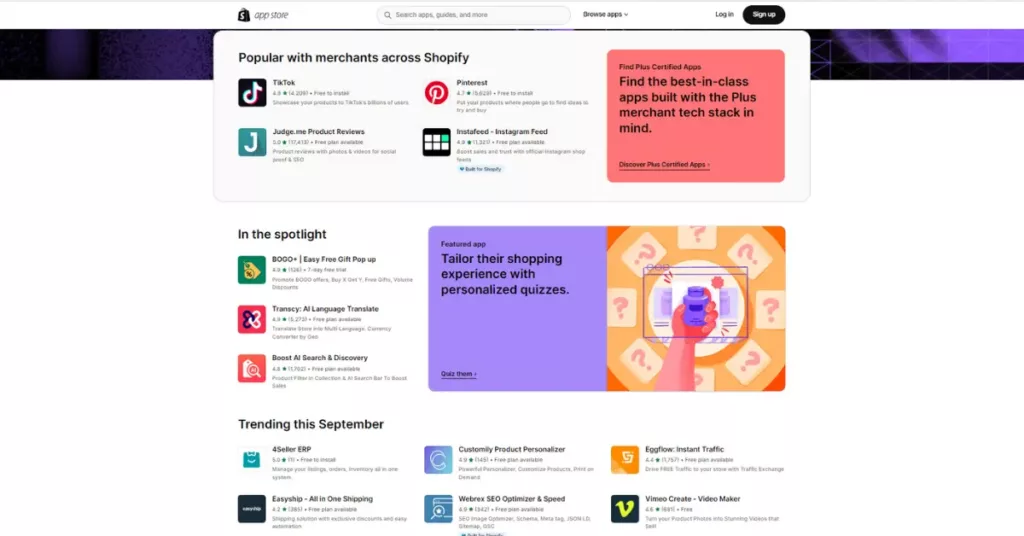
Mobile app
Compared to other SaaS platforms, Shopify provides businesses with up to three mobile applications for effective remote management of eCommerce operations:
- Shopify app: Manage orders, and inventory, and view updated sales reports.
- Shopify POS: Manage transactions for online, offline, and omnichannel sales.
- Shopify Inbox: Manage customer interactions and conduct direct sales within the chatbox.
Customer support
The SaaS platform offers 24/7 customer support through chat, hotline, and email to address any customer issues throughout the eCommerce website development process. The level of support is equivalent for both small and large businesses. Moreover, it provides Shopify Experts services to offer businesses in-depth technical support, including web development, web design, marketing, and sales.
Cons of Shopify
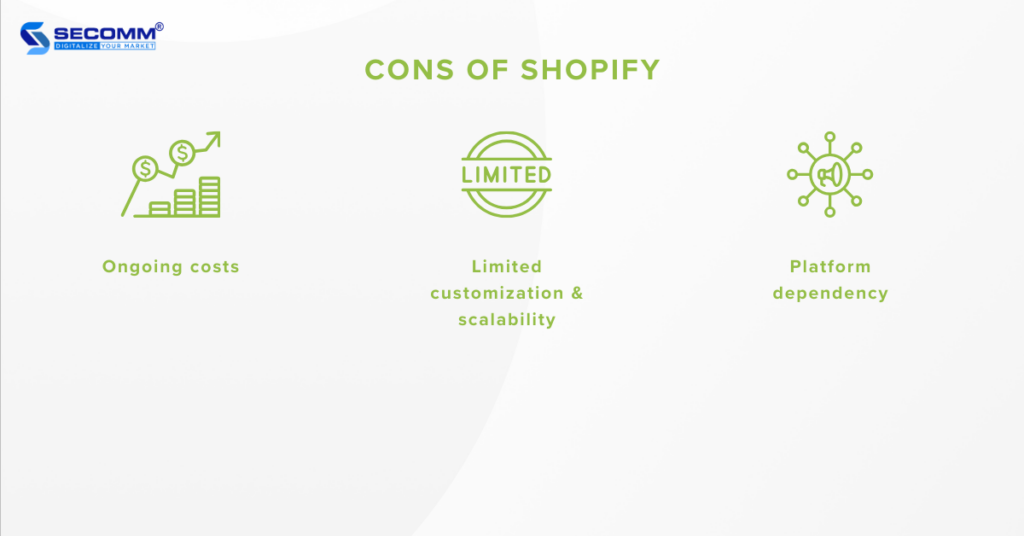
Ongoing costs
While the fees for using the plans seem reasonable, depending on the need for additional features, apps, or extensions, monthly costs may increase significantly, posing challenges for cash flow management, especially for larger businesses.
Limited customization & scalability
While this popular SaaS platform serves as a versatile eCommerce platform, its regular plans come with limitations in terms of customization and scalability. If a business requires a unique design or seeks freedom in designing the website interface, customizing themes on it can be restrictive and may require advanced programming skills.
Moreover, customizing third-party features and apps may add extra costs and dependencies. As an eCommerce website grows and expands, performance may be affected by increased traffic, accompanied by significant cost increases due to transaction fees (if not using Shopify Payments), app fees, and platform fees.
In such cases, the regular pricing plans (Basic, Shopify, Advanced) may not meet the business’s expectations for scalability, and businesses should consider transitioning to the Plus platform for long-term goals.
Platform dependency
As a SaaS platform, Shopify has full control over the source code and data within the entire eCommerce website system. This means that all data related to the eCommerce operations will be locked into the platform’s database.
If it declares bankruptcy or ceases operations, all business data on this platform could be lost. However, this risk is highly unlikely. In the second scenario, when a business switches to another eCommerce platform, the exported data is typically provided in the form of a CSV file.
Get started with Shopify today!
When Tobias Lütke transformed Shopify from a snowboard-selling website to an eCommerce platform for businesses, he probably couldn’t have envisioned the significant impact it would have on the global business and technology landscape. The figure of 4.5 million active eCommerce websites is sure to increase substantially in the coming years.
Having accompanied many businesses, both domestically and internationally, in deploying Shopify website, the SECOMM team has accumulated extensive experience in web development and a deep understanding of the platform.
Contact SECOMM or call the hotline at 028 7108 9908 to get started!


WHAT IS CS-CART? BUILD YOUR FIRST CS-CART ECOMMERCE WEBSITE
 22/12/2023
22/12/2023
 5,319
5,319
 2
2
 0
0
 1
1
In the era of growing eCommerce, building an eCommerce website has become an essential part of how businesses approach and interact with customers. To successfully build and manage an online store, businesses will need to choose the right eCommerce platform that aligns with their business needs and wants. CS-Cart is one such eCommerce platform chosen by many medium and large-scale businesses.
According to BuiltWith, the platform currently supports approximately 13,232 websites globally, with Russia (about 3,772 websites) and the United States (about 2,809 websites) being the most prevalent markets.
In this article, SECOMM will share insights into what CS-Cart is and the advantages and disadvantages of this eCommerce platform.
What is CS-Cart?
CS-Cart is an open-source eCommerce platform that utilizes a SaaS (Software as a Service) model and was developed by Simbirsk Technologies Ltd. Launched for the first time in 2005, CS-Cart has gradually become one of the popular and trusted solutions used by many businesses worldwide.
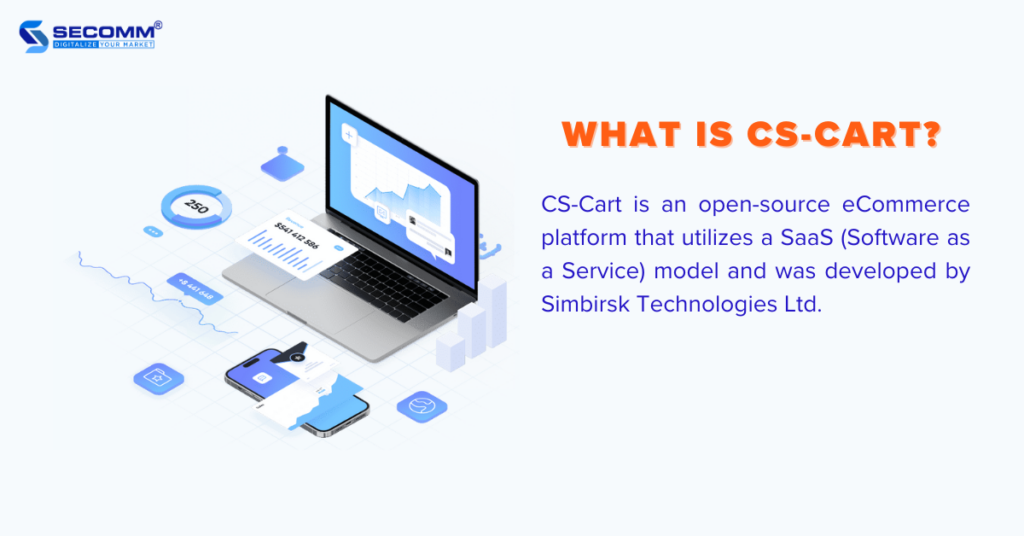
Some eCommerce websites currently using the CS-Cart platform include TechAble (USA), Yumbles (UK), Bakeshop (Australia), ToolBrothers (Germany), Inasbay (Canada), Nguyễn Kim (Vietnam), and more.
Currently, CS-Cart offers two main solutions: No-Code (a no-code e-commerce website builder) and On-Premises (an open-source eCommerce solution for website customization).
No-Code solution pricing:
- Basic: $95/month – For businesses with up to 500 products
- Pro: $155/month – For businesses with up to 5,000 products
- Advanced: $295/month – For businesses with up to 200,000 products
On-Premises solution pricing:
- Standard: $1,250/year – For businesses needing basic system customization
- Plus: $3,150/year – For businesses using open source for mobile applications
- Ultimate: $6,950/year – For businesses with multiple global markets and requiring centralized management
- Unlim: Contact for pricing – For businesses needing a permanent solution with a one-time payment.
Moreover, CS-Cart provides a free open-source version for businesses to freely apply for building eCommerce websites.
Advantages of building CS Cart website
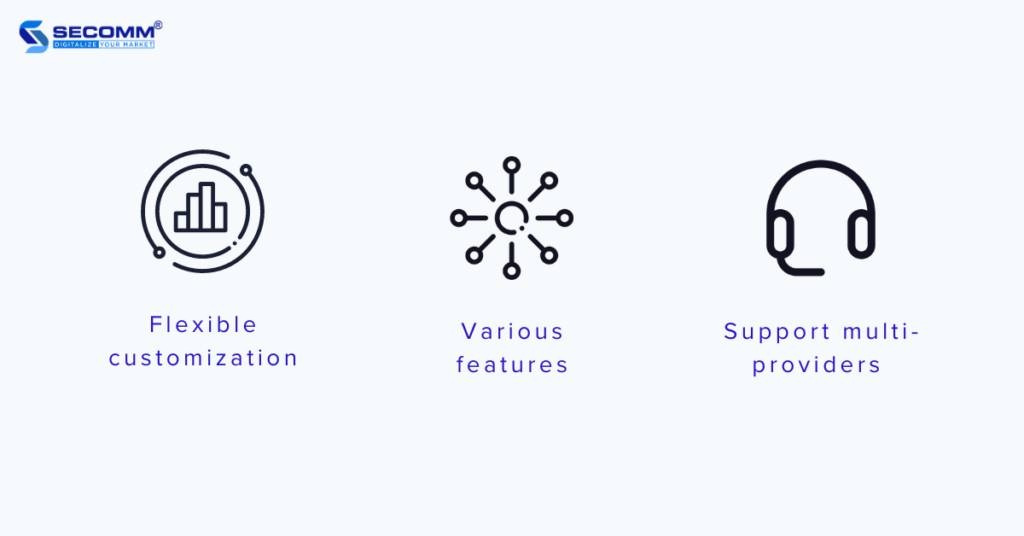
Flexible customization
One of the standout features of the CS-Cart platform is its flexibility, supporting businesses of both moderate and large scales in the eCommerce market.
Beyond employing open-source with the PHP language, CS-Cart also implements Headless architecture, allowing businesses extensive customization capabilities. This flexibility empowers businesses to create eCommerce websites tailored to their specific needs, delivering a unique and memorable shopping experience for customers.
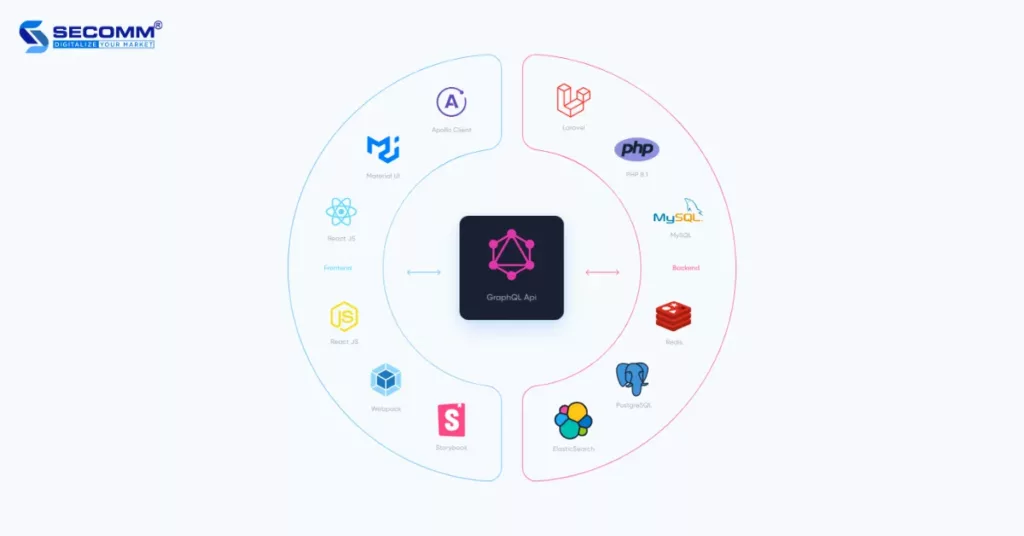
Various features
CS-Cart provides a comprehensive range of features from A to Z for operating an eCommerce system for businesses, including over 500 features and 2,000 available add-ons. From product management and order processing to marketing and SEO optimization, among others
This richness helps businesses minimize the need to integrate numerous third-party plugins, streamlining the technology stack of the eCommerce website.
Support multi-providers
CS-Cart is highly praised for its ability to connect and manage multiple suppliers with customers. This multi-vendor capability optimizes the management of different sellers, inventory, and payments, making the website system an ideal solution for businesses looking to oversee multiple suppliers on a single platform.
Disadvantages of building CS Cart website
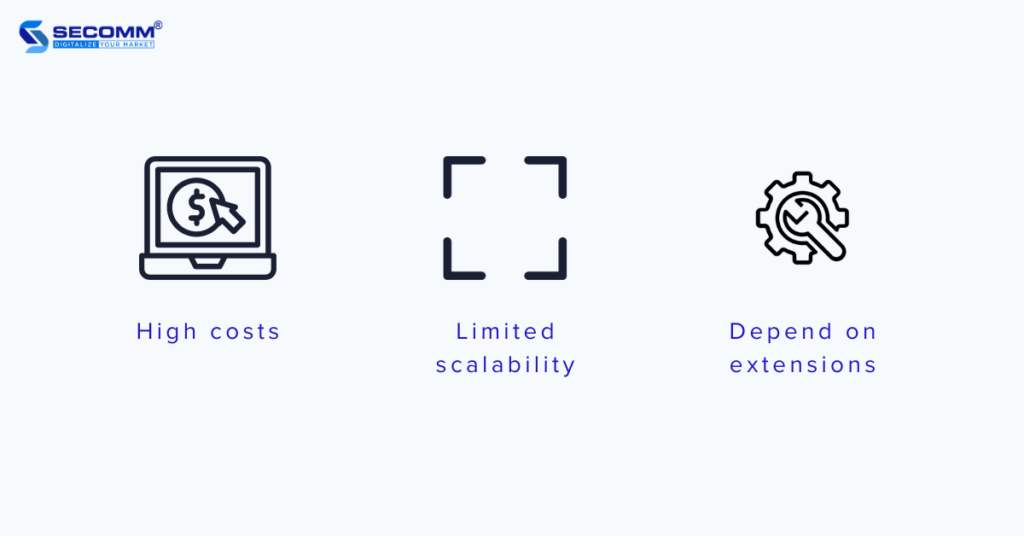
High costs
The paid versions, No-Code, and On-Premises, are considered to have relatively high usage costs. Additionally, the free version of CS-Cart may not be sufficient to meet the needs of building an eCommerce website for businesses, especially larger ones.
Businesses should note that many advanced features and functionalities will require purchasing licenses or additional add-ons. The costs associated with these add-ons and development and customization expenses can accumulate, particularly for small businesses or startups with limited budgets.
Limited scalability
While CS-Cart is suitable for a variety of business scales, it may not be the most scalable solution for rapidly growing businesses with high levels of traffic and transactions. As businesses expand, performance issues may arise, necessitating improvements to the system’s performance or a transition to another platform.
Depend on extensions
Although CS-Cart provides many comprehensive features, some businesses feel the need for specific functionalities, requiring the purchase or development of additional third-party add-ons outside the CS-Cart ecosystem.
Relying heavily on third-party add-ons can lead to issues of compatibility, security concerns, and difficulties during the upgrade process.
The Bottom Line
In general, CS-Cart is an eCommerce platform suitable for businesses seeking an open-source solution, especially those with a medium scale. However, when upgrading to a more specialized and complex eCommerce website system, businesses will need to invest additional costs and resources to scale up the system.
These are the details about CS Cart, along with its notable advantages and disadvantages that businesses should consider when developing an eCommerce website.
After years of implementing eCommerce solutions for various businesses across different countries, SECOMM has accumulated valuable experience in helping businesses build and develop effective eCommerce websites.
Contact SECOMM or call the hotline at 02871089908 for advice on choosing a platform and deploying eCommerce today!


